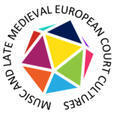BLOGS
Over the course of the project, the researchers, guests and the PI have contributed many blogposts to share. Click the titles below to read more about a variety of topics, including featured visits on location, focus themes and the experience of working on MALMECC.
Blogs 12 2019 - 12 2022
Does meaning atrophy or accumulate? A virtual étrenne
Boy, what a year!
You know you’re in trouble once Machaut’s description of the Black Death, in the prologue to his Jugement dou Roy de Navarre, starts doing the rounds on social media. Cancelled research trips; delayed conferences; trying to find a quiet corner in which to do some work within a locked-down household while maintaining sanity in isolation; and then there is the rest of life… At least we didn’t have to bury our cheese. Terrible segues aside—and yes, that was a link between the current pandemic, that which raged across Europe from 1346 to 1353, and Samuel Pepys’ famous set of priorities when faced with the encroaching flames of the Great Fire of London in 1666—I hope you will join me in raising a glass, whatever time it is when you read this (there must be some advantages to working from home!): To better times ahead, to the survival of the higher education sector, to humanities departments and research funding, as well as to collective and personal health, safety and wellbeing.
And so, back to Machaut and Pepys. I have long been fascinated by the presence of the former’s Remède de Fortune in the latter’s book collection, a fact that in itself raises both ‘how’ and ‘why’ questions. I won’t be discussing the original creation of the manuscript Cambridge, Magdalene College MS 1594 (Machaut manuscript Pe), or the route through which it found its way into Pepys’ hands (although I may be able to offer some new information concerning both aspects soon). Rather, I bring up this example as an illustration of the vicissitudes and fluctuations of meaning and value. It is clear that the Remède did not mean the same thing at its original presentation as it did for Pepys when he purchased his manuscript centuries later. Scholarship traditionally associates the origins of the Remède and its earliest and most luxurious copy (Paris, Bibliothèque Nationale de France, fonds français 1586) with the needs and interests of royalty, be they those of Machaut’s direct employer at the time (John of Luxembourg, King of Bohemia) or those of the dit’s supposed dedicatee (John’s daughter, Bonne, then queen of France in waiting). Such resonances, however, seem entirely absent from Pepys’ evaluation of his copy of the Remède. It seems that many of his medieval acquisitions had at their core a visual rather than a textual fascination. Beyond the appeal of decorative or illuminated manuscripts (here, his medieval sketchbook, MS 1916, stands out), Pepys was deeply invested in calligraphy. In 1700, for example, he created his first of three scrapbook albums (MSS 2891-3) under the descriptive title: “My Calligraphical Collection, vol. I: Comprehending as well Original Proofs of the Hand-writings of the Ancients in Several Ages within the last 1000 Years; and the Competition for Mastery between Librarians and Printers, upon the first breaking-out of the Latter as the Performances of all the Celebrated Masters of the Penn (now Extant and Recoverable) whether Domestick or Forreign, by Hand or Burin, within the last and praesent Age.” It seems likely that the appeal of what became Cambridge, Magdalene College MS 1594 was related to this interest, it being a pleasing example of an antiquated script, with the added bonus of an illumination on fol. 12v. This view suggests that the dit itself held no artistic or content-related value to Pepys at the point of purchase. In trying to draw a line between an initial highpoint of social prestige assigned both to the dit and the book that contained it, and this late seventeenth-century nadir of appreciation, it is possible to point at a more or less gradual loss of musical and visual impact and a declining interest in the subject matter as indicators of an inexorable process of atrophy. Before succumbing to this metaphor, however, we should note that this process was neither linear, one-directional, nor continuous. Indeed, this very blog—along with new editions and translations, dedicated scholarship and repeated performances and recordings—testifies to the Remède’s phoenix-like re-ascendance as an object of interest – and to some, indeed, as an object of admiration. This process relies on a re-accumulation of knowledge and, resulting from it, of interest, and on the referencing of new readings to older ones within a (modern) tradition of interpretation. Putting it perhaps a little more flippantly, and with no stronger claim to linearity or continuity than with the atrophy metaphor, one might say that the resurgence of the Remède’s cultural and artistic value over the 340 or so years since the moment when Pepys bought his copy was as dramatic as its decline over its first 340 years of existence. Actually, we are not certain that the Remède was composed in 1340, nor that Pepys’ purchase took place in 1680 … but both are as good a guess as any other. And, in all honesty, I simply could not resist the round numbers and numerical symmetry built into this chronology while writing this, still in 2020.
I’ll be saying more on the matter soon, but for now, I hand you, my dear readers, over to 2021. Merry Mid-winter, however you choose to celebrate (or ignore) it, and a happy new year, assuming you at least pay lip-service, if not adhere to the Gregorian Calendar.
Uri Smilansky
With suitcases packed
The research project I have been talking about in my previous posts (La Obra Musical Renacentista) has now come to an end. As usually happens in research, it has left us with new hypotheses and objectives that we hope to take on board in the next research project of the Contrapunto team (www.contrapunto.uva.es). Taking advantage of the end of the project, which also coincides with the end of my sabbatical year, I would like to tell you about some of my experiences and impressions at Oxford.
After 27 years as a lecturer and researcher in Spanish universities, being able to enjoy a sabbatical year in Oxford awoke in me expectations that were both, shall we say, extensive and intense. As a researcher and coordinator of research teams, and before taking on any new projects, I wanted to share my experiences with colleagues and teams in the vanguard of international musicology. In this sense, Oxford and its university, as well as the MALMECC project in particular, have turned out to be extremely enriching.
Oxford is a highly evocative city. It is vibrant with knowledge looking to be shared and transferred through a myriad of seminars, conferences, and informal meetings. I will mention just one example: the Seminars in Medieval and Renaissance Music convened by Margaret Bent; they are essential occurrences during term time that enable colleagues in the field to get together for very fruitful meetings.
My collaboration with MALMECC, too, satisfied all my aspirations. MALMECC shares fundamental objectives with La Obra Musical Renacentista and, by extension, with the Contrapunto team and with my own research agenda. Both projects are interested in examining ‘other’ sources, environments, and types of music that are seldom visited in general music historiography. Both challenge established scholarly practice by using and reconciling diverse methodological frameworks when tackling the object of study. What is more, and an aspect which is really vital, both address culture in general, not just music; one at the end of the Middle Ages and the other at the start of the modern period. This has brought about a fluid exchange of information, theorizing methodological frameworks and strategies, between the MALMECC team and myself.
My personal involvement with the MALMECC project began at the conference that the MALMECC team organized in September 2019, Music and Late Medieval European Court Cultures. My presentation was about the symbolic courtly song Nunca fue pena mayor as an example of European emotive intertextuality. I continued working on this song and others in Oxford, which will soon give rise to two articles - which are now merely waiting for the relaxation of library restrictions following the Covid-19 outbreak which will once more permit me access to a few items of secondary literature that still need to be consulted.
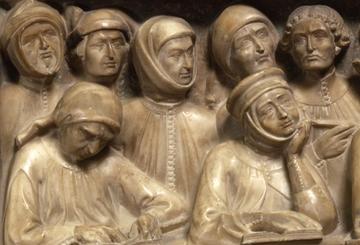
CC BY NC SA http://www.museibologna.it
The most enriching aspect of my collaboration with the MALMECC team came about in their periodical seminars in which I met up with the group of inspiring researchers who are part of the project or collaborate with it. It is a multidisciplinary team of musicologists, art historians, general historians, and literature historians interested in recognizing the ‘other’ courts, their creations and interrelations. I recall that in one of these seminars, while Uri Smilansky was presenting his work, the serene expressions on the faces of the Bolognese students of Giovanni da Legnano as depicted on their teacher’s tomb came to my mind, and how different that was from our vibrant and lively seminar debate. It is undoubtedly true that we take away knowledge, but we also take away many enriching experiences.
I would not like to finish without emphasizing the rich musical life of the city of Oxford, something which has both satisfied my spirit and left me wanting more. One thing that has attracted my particular attention is the great sensibility towards music that many, many people here possess (or at least those with whom I came into contact), in a city where I have lived as a researcher but also as a mother of three children attending school.
In conclusion, I can sincerely attest that I leave the University of Oxford with my suitcase full of new knowledge and ideas for new projects, and with the firm resolution to keep up the links created during my stay for a long time to come - despite having had to cope unexpectedly with the COVID-19 pandemic, an extraordinary and distressing situation that has only slightly lessened the intensity of the experience of having worked there for an unforgettable academic year.
Soterraña Aguirre Rincón
Profesora Titular in Musicology
University of Valladolid (Spain)
The Discovery of a Palace for Music (Blog III of IV)
Soterraña Aguirre Rincón
‘Ca en la vihuela es la mas perfecta y profunda musica, la mas dulce y suaue consonantia, la que mas applaze al oydo …. la de mayor efficacia, que mas mueue y enciende los animos de los que oyen [sig. A v verso]’.[1]
This important passage of text extols the affection and desire to listen incited in those who hear the music of the vihuela player. It is found in the opening statement of the LIBRO DE MVSICA / DE VIHVELA INTITVLADO SILVA / de sirenas, a text by Enríquez de Valderrábano that was printed in Valladolid in 1547. The volume contains 169 compositions divided into seven books. Some are new creations, while many others are adaptations for the vihuela of pieces by, among others, Josquin, Gombert, Jaquet de Mantua, or Willaert. The collection also contains pieces by Spanish composers such as Cristóbal de Morales, Juan Vásquez, or Mateo Flecha el Viejo. Silva de Sirenas is dedicated to the fourth Count of Miranda del Castañar, D. Francisco de Zúñiga y Avellaneda.
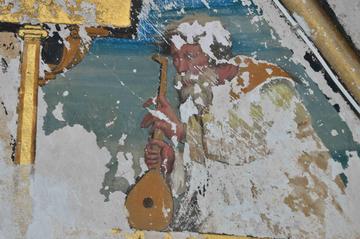
Musician with string instrument. Palacio de Peñaranda de Duero (Spain). Estudio musical. Fresco. CC BY Soterraña Aguirre Rincón NC SA
The music theorist Juan Bermudo (ca. 1510-ca. 1565) also - strikingly - dedicated his Declaración de Instrumentos musicales to the very same person, doing so because of ‘la afficion que tiene [V.S.] a la buena musica, y el saber entenderla, y exercitarla [Prologo, fol. iij verso]’.[2]
Any attempt to write the biography of this important patron has the enormous disadvantage that there is very little documentation about him. However, as luck would have it, we do have access to an exceptional source of knowledge concerning him. By that I mean his Renaissance palace in Peñaranda de Duero, now a small, charming Castilian town in the Duero valley.
Our project La Obra Musical Renacentista allowed us to experience there the performance of several pieces that we had previously selected for a comparative study. The experience was both thrilling and fruitful - it was a privilege to be able to experience such a place, conceived for the purpose of enjoying music.
The palace possesses two exceptional spaces designed for musical performances. One is a small room that historiographers, until now, considered to be a kind of gallery where the women ‘could see and hear without being seen’, as it opens to the principal hall of the palace, now called the Salón de Embajadores or ‘Ambassadors’ Hall’. However, its architectural characteristics, the socio-cultural context of its use, as well as certain acoustic qualities of the space that we measured, allowed us to state that its primary purpose appears to have been to facilitate an acousmatic listening experience for those present in the Salón. The small room can accommodate just two or three musicians; its walls are rough, and unpolished. It is located above the lintel of one of the side doors of the Salón, and is 2.84 meters long, 2 meters high and 0.95 meters wide. Unlike a balcony for minstrels, it does not protrude into the Salón. Those present in the chamber cannot be seen from the Salón but goings-on in the Salón can be followed and observed from the chamber. We therefore believe that it functioned in ways comparable to today’s sound systems, providing ‘atmospheric’ music for those congregating in the Salón without them seeing the performers, something which is highly exceptional at this period in history.
The second space is a studiolo, richly decorated with frescoes dedicated to music and musicians. The musicians appear playing numerous different combinations of instruments in realistic poses, both getting ready for playing and while playing their instruments.
These spaces constitute one of the main foci of our next research project. Meanwhile, if you would like to have further information and to see some images, they are available in: Soterraña Aguirre-Rincón and Ana López Suero, “Música, espacios y mecenas. El palacio de los Condes de Miranda en Peñaranda de Duero (c.1510 - c.1550)”, Biblioteca: estudio e investigación (2017) 32: 119-138.
[1]‘There exists in the vihuela the most perfect and profound music, the sweetest and softest consonance, that gives the greatest pleasure to the ear… the most effective, that most moves and fires the mood of those who hear it’.
[2] ‘The liking you [Serene Highness] have for good music, and the understanding of it, and the practice of it’.
Re-visiting the concept of the ‘musical work.’ Part II (Blog 2 of 4)
Soterraña Aguirre Rincón
As I mentioned in my previous post, the research project The Renaissance Musical Work: Fundamentals, Repertoires and Practices, carried out by the Contrapunto team, is based on the study of ‘other’ sources, environments and kinds of music that are little used in general music historiography. Now, I would like to present some of these. We have consulted, for instance, the writings of the humanist, philosopher and educator Juan Luis Vives (1492-1540); works of the philosopher and poet Giordano Bruno (1548-1600); or the musical theorist Fernand Estevan (fl. 1410). Our aim was to reflect on the concept of a musical work and to carry out an ontological investigation concerning Renaissance musical works that tell us about the past, but also project us towards the future through their potential for (re-) materialization as sounding music.
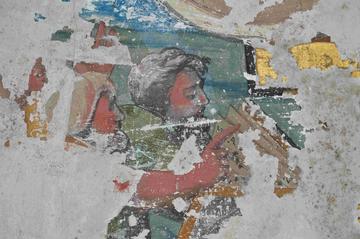
We also consulted such peculiar literary texts as those of the aristocrat, soldier and poet, Íñigo López de Mendoza, the first Marquis of Santillana (1398-1458), or the Arte de trovar (ca. 1427-33) by the astrologer and writer Enrique de Villena. The purpose here was to rethink the uses of interpretative practices in 15th-century songs with Castilian texts and the limits of these practices in relation to their potential classification as musical works.
We further looked at the incunable dictionaries of Antonio de Nebrija (1441/44-1522), Alfonso de Palencia (1423-1492), and the interesting but almost unknown anonymous treatise, the Arte de la melodía sobre canto lano y canto dorgano (ca. 1475-1525 [Barcelona, Biblioteca de Catalunya, Ms. 1325/2, ff. 21v-24r]), among other sources, in order to study the gloss and its limits as an identifying element of musical work
The results of our research have been set out in the volume Making Musical Works in Renaissance Spain, of which John Griffiths and I are the editors and which will come out shortly (Turnhout: Brepols). So as not to bore you with too much information, I would just like to say that this volume also includes case studies focused on concrete pieces of which a considerable number of copies have been preserved. For example, the romance Los brazos traygo cansados has been dealt with as an example of constant updating; while the hymn Pange lingua set by Juan de Urrede possesses a symbolism that shapes it into a work.
There are also other contributions that we believe will be of interest to the reader, such as the one dedicated to identifying the musical works contained in the immense library of Hernando Colón (1488-1539) – a son of the well-known explorer, Christopher Columbus - on the banks of the River Guadalquivir, in Seville, with exactly 15.344 volumes, until now only partially examined.
We hope to be able to continue our research in a future project, where one of the central foci will be the study of the Palace of Peñaranda de Duero, an exceptional research object previously unstudied by musicologists, and one which I would like to talk about more in my next post.
Series of four posts by Soterraña Aguirre Rincón: Blog post I
Do we need the concept of the ‘musical work’ to make a music history? This is a simple question to which it is not easy to offer an answer. If we answer it restrictively, we would have to say that its use is only relevant for the study of the music of the 19th century and much of the 20th century. But it is also quite possible that we might accept its validity for music from the 15th century onwards. As John Butt pointed out, ‘within the context of the European tradition, there is for many … an essential transhistorical unity implied by the concept of a work’.[1]
CC BY Soterraña Aguirre Rincón NC SA
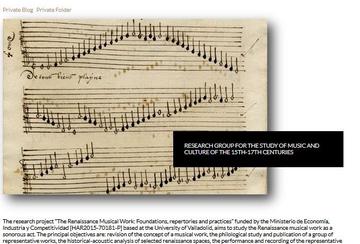
CC BY Soterraña Aguirre Rincón NC SA
The ‘musical work’ has been the subject of vibrant and productive discussions since the late 1960s,[2] but the debate has become more widespread since the 1990s, when English-language musicology began to concern itself with the subject. We all remember in this respect the impact of Lydia Goehr's controversial and emblematic book The Imaginary Museum of Musical Works: An Essay in the Philosophy of Music (Oxford: Clarendon Press, 1992).
Goehr’s study dealt with the historical period (the end of the 18th century) in which a specific way of conceiving the musical work (which in the book appears as the only one) became the regulating force of the musical practices of the following centuries. Goehr highlighted the relevance of the notion of Werktreue in the fields of music and theatre. She also underlined the powerful influence that the work concept had in legitimizing certain musical practices over others. Her book without doubt revealed a fissure in the dominant ways of thinking and made room for new arguments and ideas. In my opinion, this was one of its main contributions.
Goehr’s most direct impact came from her claim that the element of time – of history - was a necessary component for understanding the meanings of the term ‘musical work’. Goehr marked the turning point as ca. 1800, the period when – according to her - composers began to conceive of their craft not just as music, but as ‘works’. Hence, we can’t properly speak about the ‘musical work’ before that moment as an aesthetic and regulative concept. This argument has been criticized for creating a certain historical discontinuity and, consequently, for excluding creations such as those by Bach or Mozart from the terrain of the ‘work’.
Theorists such as Polish philosopher Władysław Tatarkiewicz and British critic Terry Eagleton previously concluded that the concept of the ‘work of art’ had been established during the second half of the 18th century, intertwined with other ideas about art, autonomy, creativity (or genius), beauty, form and aesthetic experience.[3] However, as the Spanish researcher Pilar Ramos points out, ‘Tatarkiewicz was not interested in addressing issues such as the origins, continuity or discontinuity of ideas throughout history, but chose to focus on the various meanings given in each historical period to terms such as creator, work, art, mimesis, etc.’.[4]
In an attempt to clarify this ‘problem’ within the musicological field, and to try to allow space for the ‘idea’ and the ‘process’ of the musical work, in 1998 the symposium The musical work: reality or invention? was organized at the University of Liverpool.[5] On this occasion, speakers belonging to several research fields, such as musicology, ethnomusicology, anthropology or philosophy, shed light on this theme from very different perspectives. All the participants tried to reach an agreement on what a ‘musical work’ is, whether from a timeless perspective or in a concrete historical situation, and some consensus was reached in defining a musical work as ‘discrete, reproducible and attributable’.[6] This is an inclusive conception of a musical work, but it is also somewhat imprecise and therefore difficult to use.
There is no doubt, however, that the concept of a musical work was already used in the 15th century.[7] Several researchers have analyzed this concept. Almost inevitably, they examine it as a progression towards the idea of a musical work of art in the sense understood in the 19th century, differentiating the 19th-century concept from how they believe the concept of a musical work was used and materialized in the fifteenth.
My research team Contrapunto has sought to understand Renaissance music from the perspectives of both observation and analysis. To this end, we designed the project The Renaissance Musical Work: Fundamentals, Repertoires and Practices which I lead.[8]
Our interest in examining ‘other’ sources, environments and musics that are little used in general music historiography, together with the plurality of methodological frameworks that we use to achieve our objectives, are premises that our project shares with MALMECC. Hence our interest in collaborating and sharing results and experiences.
Soterraña Aguirre Rincón
Profesora Titular in Musicology
University of Valladolid (Spain)
[1] John Butt, ‘What is a ‘musical work’? Reflections on the origins of the “work concept” in western art music’, in Concepts of Music and Copyright: How Music Perceives Itself and How Copyright Perceives Music, ed. by Andreas Rahmatian (Cheltenham: Edward Elgar Publishing, 2015), 1-22, at 2.
[2] See for example, Carl Dahlhaus, ‘Plädoyer für eine romantische Kategorie: Der Begriff des Kunstwerkes in der neuesten Musik’, Neue Zeitschrift für Musik, 130 (1969), 18-22, or Zofia Lissa, ‘Über das Wesen des Musikwerkes’, Die Musikforschung, 21/2 (1968), 157-82.
[3] Władysław Tatarkiewicz, A History of Six Ideas: An Essay in Aesthetics (The Hague: Nijhoff, 1980). Terry Eagleton, The Ideology of the Aesthetic (Oxford: Blackwell, 1990).
[4] Pilar Ramos, ‘Defraudar la compostura: On Musical Glosses, Musical Works and Authors’, in Making Musical Works in Renaissance Spain, ed. by Soterraña Aguirre Rincón and John Griffiths (Turnhout: Brepols, forthcoming).
[5] Organized by James Michael Talbot and Constance Alsop. Its results were published as The Musical Work: Reality or Invention?, ed. by Michael Talbot (Liverpool: Liverpool University Press, 2000).
[6] See also Giuseppe Fiorentino, “The Concept of Musical Work in the Spanish Renaissance: A Lexical Inquiry” in Making Musical Works in Renaissance Spain (forthcoming).
[7] See, for example, Laurenz Lütteken and James Steichen, ‘The Work Concept’, in The Cambridge History of Fifteenth-Century Music, ed. by Anna Maria Busse Berger and Jesse Rodin (Cambridge: Cambridge University Press, 2015), 55-68.
[8] Financed by the Spanish Ministry of Economy, Industry and Competitiveness [HAR2015-70181-P].
Interview with Grantley McDonald, Post-doc researcher on the MALMECC project
What attracted you to this project?
I have been working on a large-scale project on the court chapel of Maximilian I Habsburg (1459–1519) since 2016. At every turn I became aware how much its structures, practices and personnel drew on the chapels of his immediate predecessors: his father, Holy Roman Emperor Frederick III, Archduke Sigmund of the Tyrol, and Duke Charles the Bold of Burgundy. I was attracted to this project by the chance to explore more fully the musical life of these earlier courts, in an environment that would lead me to look at the materials in ways I had not previously considered, and with some colleagues whom I admire tremendously.

The court chapel of Maximilian’s father Frederick III in particular is desperately under-studied, despite Frederick’s central position in the politics of Central Europe during the fifteenth century. Most nineteenth-century historians dismissed him as ineffectual and cranky, but the diligent work of some recent German and Austrian historians, and the systematic examination of the written records of his reign, have begun to reveal his true importance. This revision of Frederick’s historical and political importance really demands a reassessment of his musical legacy.
Why do you think this project is important or original?
I have long been fascinated by Isaac Newton. Besides his pioneering contributions to the natural sciences and mathematics, Newton was obsessed by historical, theological and prophetic questions, as his voluminous papers attest. Things are different now. As disciplines become ever more specialised, they develop their own way of examining, testing, and talking about their object of study. Ideas and hypotheses are evaluated; ever more workable ideas and techniques are developed, and inaccurate or untenable notions are winnowed out. This is true not only in the natural sciences, but also in the humanities, where the objects of study are “softer” and more difficult to pin down. Nevertheless, while the creation of such subject-specific discourses permits individual fields to move forward, it also means that it is difficult, if not impossible, for an individual to master the discourse – and the attendant literature – of several different academic specialisations. If he were alive now, even Newton would have found it a challenge to operate at the cutting edge of both theoretical physics and biblical criticism. However, working in a team made up of individuals with different specialisations is one way of profiting simultaneously from the approaches and advances of multiple fields, and of stimulating fruitful new lines of enquiry.
MALMECC has the added challenge of operating within the field of mediaeval studies, which has long served as a crucible of nationalistic and religious agendas. Responding to recent developments in the “new mediaeval studies”, we are trying to disrupt the agendas of earlier generations of mediaevalists by asking different questions of the material and questioning the narratives underlying earlier work.
My own part in the project combines these stimulating new intellectual challenges with what is perhaps a very traditional way of working: by trawling the archives of Europe to gather vast quantities of previously unpublished material recording the lives and activities of the members of the chapels of Frederick and Maximilian, to create what historians call a “prosopography”, a collection of life data on a circumscribed group. After a while, historical work on a given period or situation can start to turn in circles once scholars have digested and discussed the available source materials. The publication of new source materials provides the necessary fuel for new discussions, but it’s hard going. Working in archives is like looking for pieces of a jigsaw in an exploded building. It can be wretched, boring, and unexpectedly draining. Once a document has been located, it must be transcribed and analysed, and these tasks require advanced skills in palaeography and various dead languages, as well as knowledge of the historical background and interpretive acumen. But once you start to build up a body of documentary evidence, all the little bits of the jigsaw start to fall into place. You’ll probably never find all the pieces, and you will have to chuck out bits that belong to other puzzles, but once a picture starts to emerge, it’s electrifying. That shiver of uncovering past lives sends you back into the archive the next day. And the next. And the next. More importantly, the location, transcription and publication of previously unknown materials is an indispensable part of keeping historical discussion fresh and dynamic.
Which aspects of courtly culture in mediaeval times do you find most interesting and why?
In the present project, I have become fascinated by the intersections between the structures of the court and the structures of the church. The Holy Roman Emperor had a mission to promote the interests of the church. In the fifteenth century, this meant fighting against Hussitism and the advance of the Turks; in the sixteenth, it still meant fighting back the Turks, but also involved stopping and – if possible – reversing the gains of Protestantism. So the relation between the church and the imperial court is particularly interesting. As elected head of a confederation of nobles, the Emperor also had to project the power of his personality and authority. One of the things I am investigating is the way music was used to do that – in a sense, how music was instrumentalised as a political and even as a propagandistic tool.
What message would you like to communicate through your work on the project?
One of the explicit aims of MALMECC is to challenge the nationalistic narratives that have in the past run though mediaeval studies, and to an extent still do. The history of the Holy Roman Empire has almost always been written as a German and Austrian story. On the other hand, while the five-hundredth anniversary of Maximilian’s death in 2019 prompted numerous conferences and major exhibitions in Austria and Germany, the event was marked by no comparable events in Belgium or the Netherlands, even though Maximilian, as Duke of Burgundy, ruled the Low Countries for some fifteen years. I wanted to shake up such silly parochialism. Besides working in major archives in places such as Vienna, Innsbruck, Weimar, Augsburg, Nuremberg and Karlsruhe, I have also looked further afield, to central archives in places such as Rome, Milan, Ljubljana, Prague, Strasbourg, Brussels, Lille, the Hague, Ghent, and Bruges, as well as to numerous small town and church archives throughout Europe. This has revealed that the activity of the Holy Roman Empire involved much more than simply Germany and Austria, but sent out tentacles across the continent.
Secondly, I want to reveal something of the lives of the members of the chapels of Frederick and Maximilian. Partly because the source situation is so difficult, we have in the past found it hard to understand most musicians of the Middle Ages as people, with a few exceptions, such as Guillaume de Machaut. But by collecting vast amounts of information about individual musicians, I have come to know many of them as interesting individuals: emotionally fragile organists, undisciplined and unruly singers, priests hustling for promotion within the Church hierarchy or providing for their illegitimate children, trumpeters negotiating a pay-rise or a pension for their wives. And all this fine-grained texture about the lives of members of the chapel and other musicians can bring their music to life in surprising ways.
What got you interested in mediaeval music and what do you like about it?
As a kid I sang in the choir of St Paul’s cathedral in Melbourne, and at our parish church. Even as a child I was drawn to mediaeval and Renaissance music, and devoured recordings by David Munrow, the Tallis Scholars and Gothic Voices. As an over-eager high school student I wrote a long essay about the Roman de Fauvel, complete with a recording which I had made with some friends, huddled around a tape recorder. As an undergraduate in Melbourne I was fortunate to work with some very erudite conductors, such as John O’Donnell and John Stinson; under John Stinson I sang in a group called Les Six, which specialised in fourteenth-century Italian music. I also continued my vocal studies with Vivien Hamilton and Stephen Grant, who sang with the mediaeval ensemble Sequentia. After moving to Europe I started to sing with other early music ensembles, such as Diabolus in Musica (Tours) and Cappella Pratensis (Den Bosch/ Leuven). I find the combination of elegance, intellectualism, and raw energy in this music immensely appealing.
What reactions do you get from new audiences, such as children?
During a US tour with Cappella Pratensis last year, we had the chance to work with groups of high-school students and undergrads, such as a group of the students of the wonderful Jenny Bloxam at Williams College in Massachusetts. With the high-school kids, we worked on things such as tone and articulation as ways to express the text. Cappella Pratensis specialises in performing from facsimiles of original sources, and after a few hours we had Jenny’s students doing likewise. Their delight at being able to sing from notation which at first seemed foreign was palpable. After a concert in New York, a young poet even sent us a package of delightful Neo-Spencerian poems in praise of the ensemble and the performance. We hope that the kind of research we are doing in MALMECC will resonate both with our own peers and with students of the next generation who come to study mediaeval and Renaissance music more deeply through their own experiences as performers or listeners.
Our understanding of medieval culture vastly relies on fragmentary sources. Musicologists are especially well-acquainted with this — most historians working on pre-1500 music rely to a significant extent on ‘waste’ parchment as a source of information about lost musical cultures. Working with fragments is challenging; however, it can also yield extremely rewarding results when we are able to reconstruct a wider picture.
In a recent publication, I re-examined a group of musical fragments preserved in Catalan archives. They transmit a highly sophisticated repertory inspired by the musical practices of late fourteenth-century cardinals and popes in Avignon, alongside northern French aristocratic and royal households. My essay traces the provenance of these fragments, recalibrating the way we think about the connection between the original manuscripts, local ecclesiastic and courtly institutions, and individual clerics. To make a long story short, most of the manuscripts converge with the itineraries of King John I of Aragon (b. 1350, r. 1387-1396) —who was an enthusiastic lover of music— and his court. The rather concrete picture emerging from my study confirms the long-held hypothesis that the royal court of Aragon was a major force behind the dissemination of this refined musical repertory throughout late medieval Catalonia.
In order to make the results of my research accessible to non-specialists, I have put together a ten-minute video. I couldn’t resist including footage of some of my favourite medieval towns and buildings. I hope you’ll enjoy watching it.
David Catalunya
Life Imitating Art Imitating Life Imitating Art Imitating Life? A Peek at Machaut and Le Franc – Part IV
Uri Smilansky
Last part, I promise!
So, there you have it. We’ve encountered Guillaume de Machaut’s literary influence on Martin Le Franc, and suggested the earlier poet’s name still resonated at the Burgundian court in the middle of the fifteenth century. We’ve mirrored art and life, juxtaposing Machaut’s Boethian Remede with Le Franc’s framing of two literary works and two books within the intellectual politics of the court of Burgundy. We’ve seen how this mirroring might have been achieved, and what Le Franc could have gained from it. Now, the question is how any of this can affects the way we view courtly culture.
I ended the previous instalment suggesting that the story told by the manuscript Paris, BnF fr. 12476 is subtly yet materially different from its actual, textual and visual content. Regardless of what one thinks of this specific case, allowing such readings forces a deeper interaction of material culture and situational context into literary, artistic and musical analysis. Texts accrue meanings beyond their words, not only through their presentation, ordering and juxtaposition within each manuscript source (Huot, 1987), but also with each interaction of users with the book as object. Clearly, not all interactions are as carefully managed as that orchestrated by Le Franc for the presentation of this manuscript. Nevertheless, crafted intentionality can be read into any book-presentation or gift-giving ritual, and even into book-loaning at court. This, of course, relates also to the literary use of books, especially when this involved an intentionally communal consumption, with discussions appending readings (Kelly, 2017).
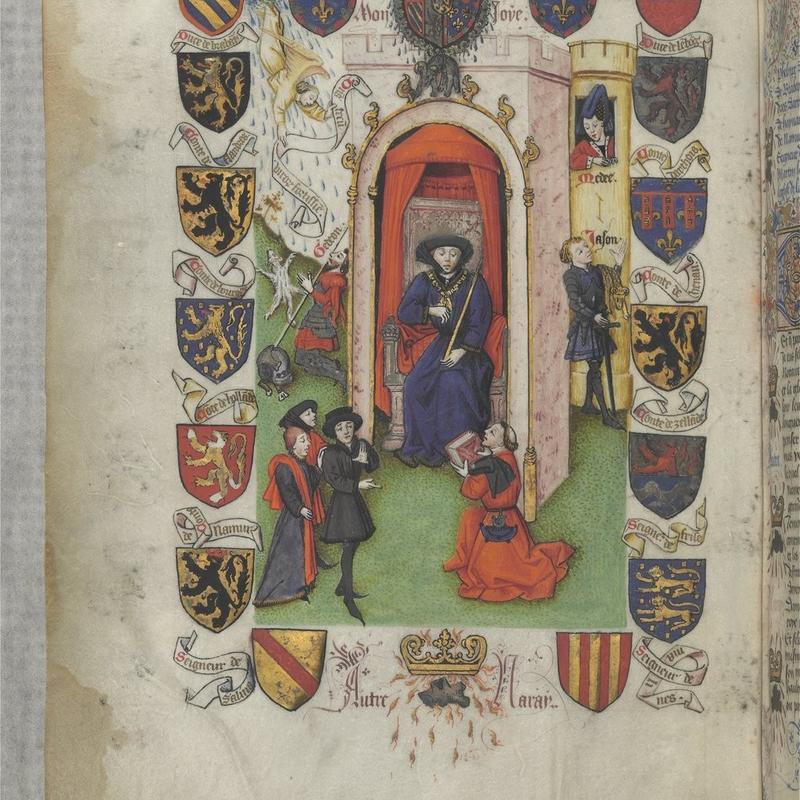
The notion of communal interpretation of cross-literary-courtly behaviour that underpins these blogs links to many other established directions of research. The social performance component clearly relates to discussions of the orality of literature (Coleman, 1996; McGrady, 2006). It ties in with institutional research into the operation and use of princely libraries (Wijsman, 2013). I have already highlighted its relevance to interpretations of the use of allusion within courtly life (Plumley 2013), and the whole affair underlines performance—of literature, or of courtly, social ritual—as an integral component of creating meaning. This is taken for granted within the realm of linguistics, taking it to be a building block of communication. Musicological, art-historical and literary analyses, however, often shy away from incorporating performance within their models of meaning, no doubt due to our distance from both original performers and audiences, and the meagre evidence we have concerning their techniques and aesthetics.
Finally, I’d like to throw some questions out there, which go clearly beyond the current context and medium. These relate to more general notions of time, contemporaneity, memory and relevance. How was the border between contemporaneity and the past navigated? Were works by Machaut thought of as current a century after their composition, or did they act as relics of an authoritative past? Did Machaut have special status in this regard? How did his oeuvre compare to the scores of other writings circulating and being reproduced long after the demise of their authors, for example, the thirteenth-century Roman de la Rose? Could audiences easily date the works they were consuming? Did dating matter beyond the notion, that something was ‘old’? To what degree do such considerations rely on the objects in which works are contained? Is an old work in a new book new or old? In what other ways did owners and courtiers engaged with new books? Were old books cherished for their literary contents, or as tokens of dynastic inheritance? Were they used, or simply preserved? Assuming at least a few of Machaut’s works did remain in some publics’ imagination for a century or so, how did this manifest itself? Were they remembered in detail? Were they viewed as idealized tropes? Or viewed not at all, with only his name acting as a nebulous tag of authority?
With so many questions still outstanding at the end of the analysis, at least intellectually, none of us will be out of work any time soon. I hope this has encouraged some of you to carry on thinking along these lines. If that happens, these multiple entries will have been well worth the effort.
Image: French gift book detail
Selected further reading:
Sylvia Huot, From Song to Book: The Poetics of Writing in Old French Lyric and Lyrical Narrative Poetry (Cornell University Press, 1987).
Douglas Kelly, ‘Judgment at Court: Open Thought and Prudent Dissimulation in the Anonymous Livre du Tresor amoureux’, in R. Barton Palmer and Burt Kimmelman (eds), Machaut’s Legacy: The Judgment Poetry Tradition in the Later Middle Ages and Beyond (University Press of Florida, 2017), pp. 9-27.
Joyce Coleman, Public Reading and the Reading Public in Late Medieval England and France (Cambridge University Press, 1996).
Deborah McGrady, Controlling Readers: Guillaume de Machaut and his Late Medieval Audience (University of Toronto Press, 2006).
Hanno Wijsman, ‘Book Collections and their Use: The Example of the Library of the Dukes of Burgundy’, Queeste, Journal of Medieval Literature in the Low Countries 20 (2013), pp. 83-98.
Life Imitating Art Imitating Life Imitating Art Imitating Life? A Peek at Machaut and Le Franc – Part III
Uri Smilansky
In the first two postings of this series, I’ve presented a couple of works by Martin Le Franc, a couple of manuscripts in which they were first copied, and traced their accepted or potential relationships to some of Guillaume de Machaut’s oeuvre. In the second post, I suggested one can choose to see a purposeful remodelling of Machaut’s Remede de Fortune narrative structure in Le Franc’s decision to compose the Complainte du Livre du Champion des Dames and present his Champion des Dames for a second time at the same court. According to this reading, both court and author—along with his two poems and two books—become characters in a meta-fictional performance of courtliness and cultural consumption. This raises many questions, though I will only mention three here. Why would Le Franc choose to act in this manner? Would this remodelling become apparent to his contemporary audiences? How was it enacted?
We cannot tell exactly why Le Franc decided to present his Champion des Dames to the same patron twice, a decade apart. Whatever the actual reasons, I believe this procedure was unusual enough to lead him to take precautionary action before undertaking it. After all, if the work was indeed rejected when new, would a new presentation not imply that the Duke of Burgundy and his court were wrong in their original judgement? If it was accepted back then (either enthusiastically or indifferently), why would the author presume his patron required a new version? True, princely libraries often contained multiple copies of single works, but these were usually the result of inheritance or commission, not of authorial presentation. To my mind, a second presentation would have required careful management on Le Franc’s part. It needed to be done in such a way as to explain the repetition of the act of presentation of the book by Le Franc to Philip the Good, and—assuming he was hoping for a more positive reception at his second attempt—provide both patron and court with an avenue through which they could change their reaction to the work without losing face. This is where Machaut’s model comes into play: the use of an established literary trope recast to retrospectively explain real-life events would have offered exactly such a narrative paradigm. The Remede model presents a successful reintegration into court. At the point of the Champion’s second presentation, this could not have been guaranteed, as the second book (now Paris, BnF fr. 12476) had not yet been accepted by Philip and his court. Le Franc’s use of the Remede as model, however, creates the expectation of a positive resolution, and provides both court and its patron with a moral justification to change their minds: it was the original presentation that was faulty, not their judgement upon it, or, indeed, the work itself.
This is all very well, but such modelling would only be effective if it was recognized by the books’ recipients. Previously, I suggested that at least in the particular case of the reception of Machaut’s oeuvre in mid fifteenth-century Burgundy, adaptations, citations, references or allusions to materials a century or more old were intended to resonate with contemporary audiences rather than function as unacknowledged tags of an author’s learnedness for the benefit of future specialist readers. Indeed, it seems reasonable to suggest that such techniques, when used in works designed for presentation to a courtly audience, always relied on at least some listeners picking up on their significance (Plumley, 2013). Otherwise, they make little sense. If this was indeed the case, what would stand in the way of this audience familiarity underpinning the performance of similar relationships between old and new within managed courtly rituals such as book presentations? If meta-fictions and pseudo-realities were so eagerly consumed within late-medieval literature, why not act out meta-realities and pseudo-fictions within courtly life?
This leaves the question of technique. How would the relationship to Machaut’s Remede be communicated? One issue is that of specificity. For Le Franc’s fictionalized description of events to work, it would have been enough for the courtly audience to recognize a more general ‘consolation’ trope where adversity is successfully overcome. An association with the Remede—with its specifically courtly setting and near obsessive presentations, descriptions and discussions of performance—would have been ideal for Le Franc’s needs. Nonetheless, vague echoes of Boethius’ De consolatione philosophiae (c. 524) in its Latin original or in any one of its many French translations and reworkings would probably have sufficed for his pretence to have worked (Cropp, 2012). This reduces the pressure to associate the proceedings with Machaut specifically and allow access also to consumers without this degree of prior knowledge.
Either way, the viability of any external allusion relies on the recipients noticing that Martin Le Franc added the new Complainte at the end of the Paris manuscript. To recap, this is the only work in that book beside the Champion, they are linked though scribal hand and illuminator, and there is no sign of separate origins for the two works. This joining seems original, and as the main textual difference between the Paris and Brussels books, it would have been easy to point towards the addition during a presentation ritual. The joint binding of the two works acts as a continuous reminder of the artifice they are engaged with, thus imbuing them with additional interest beyond their actual content. Furthermore, the relationship between the two works is readily apparent just from reading their rubricated titles. Combine this with the physical object of the presentation book that contains them and with a familiarity with the Consolatio / Remede narrative model, and it becomes possible for the books’ owners mentally to reconstruct or remember Le Franc’s meta-narrative without even hearing his poetry. The book’s physical location and intellectual context tells a story that, while authored by Le Franc, is not contained within it. One can go as far as suggest that while his work may well have been better received upon its second presentation, the very artifice used to enable the occasion may have caused a reduced likelihood for textual engagement with its contents. Courtly artifice—represented through the meta-fictional exchange outlined here and the dissonance between literary content and the new illumination programme of the Paris copy—may have won over contents.
In the next instalment, I ask: “So, what?”
Selected further reading:
Yolanda Plumley, The Art of Grafted Song: Citation and Allusion in the Age of Machaut (Oxford: Oxford University Press, 2013).
Glynnis M. Cropp, ‘Boethius in Medieval France: Translations of the De consolatione philosophiae and Literary Influence’, in Noel Harold Kaylor, Jr. and Philip Edward Phillips (eds), A Companion to Boethius in the Middle Ages (Brill, 2012), pp. 319-55.
Transl. by David R. Slavitt (trans.), Boethius: The Consolation of Philosophy (Harvard University Press, 2010).
A Peek at Machaut and Le Franc – Part II
Uri Smilansky
Previously on the MALMECC blog: in the last post, I traced a few links between Guillaume de Machaut and Martin Le Franc and left some questions hanging as to how far they can be stretched. This is the focus of today’s instalment. My suggestion first involves a widening of the range of works to be compared, and then allowing the comparison to take a step beyond the world of literature. The work I have in mind is Machaut’s Remede de Fortune (early 1340s?). The comparison with Le Franc is not directly with any of his literary works, but with his retrospective fictionalization of the events surrounding the double presentation of his Champion, and the composition of the Complainte described in Part I. Instead of a literary space, Le Franc uses the Burgundian court to portray a real-life version of Machaut’s fictional model of courtly rejection, reinvention and eventual acceptance, with himself, his books and his literary creations acting as characters in the story. See what you think.
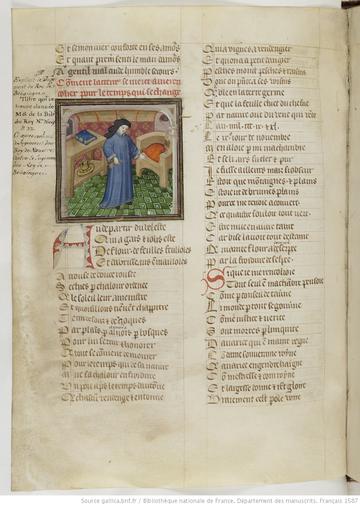
NY Morgan library and Museum MS M 396 fol 67v detail
The Remede is not an overtly biographical work, though its compositionally-minded and active first-person narrator invites a certain amount of conflation between character and at least an idealised author-figure. As a result, this work has been taken to attest to a number of extra-literary processes. These include the formation of, at a minimum, a professional relationship between Machaut and Bonne of Luxembourg (May, 20th, 1315-September, 11th, 1349), the supposed dedicatee of the work, conflating her with the character of the beloved (Wimsatt and Kibler, 1988); Machaut’s didactic relationship with the future Charles V as a child (Leo, 2013); and the literary reframing of a real-world, contemporaneous transition from old to new musical and poetic possibilities and conventions (Switten, 1989, Brownlee, 1991).
The narrative arc of the Remede is presented in a much-simplified version in the first column of the table below. Central events and structural points of change are highlighted within the narrative through lyric interpolation, with seven of the nine insertions sporting musical settings in the majority of surviving versions (and, notably, in the central group of sources close to Machaut’s person). These self-contained pieces work as a set, offering a single instance of each courtly genre of the day, and presented as moving simultaneously towards poetic simplification and musical innovation. The middle column of the table details their locations within the narratives, as well as giving some more detail of the events of the Remede. Finally, I have added a third column to the table, where the parallels between Machaut’s and Le Franc’s creations are mapped out. Beyond the transition from a literary space to that of the Burgundian court, this requires the substitution of Machaut’s literary protagonist, the amant, with Le Franc’s literary work, the Champion. Placing a literary creation as a character is, of course, problematic. Le Franc overcomes the problem of this (relative) fixity in two ingenious ways. First, the ventriloquizing of the Champion’s first presentation copy—now Brussels, KBR, MS 9466—within the Complainte permits it to acquire a narrative presence within the fictionalized proceedings. Second, the creation of a new, physically distinct version of the same text—now Paris, BnF fr. 12476—, visually differentiated through the integration of a new illumination programme and the Complainte, allows for the material performance of change without the text changing or losing its identity.
Part I of IV
Uri Smilansky
Helen Swift has written extensively (2017, but also 2004, 2006, 2008 and 2013) about an extraordinary work, the Complainte du livre du Champion des Dames a maistre Martin le Franc son acteur. Martin le Franc (c. 1410-1461) must have composed this 60-strophe dream-poem by 1451, this being the date of its first surviving copy. As the name suggests, the poem dramatizes a debate (or rather, mud-slinging match) between a book containing Le Franc’s major work—the 24,000-verse and much better-known Champion des Dames (c. 1442)—and its author, following its supposedly unsuccessful presentation at the Burgundian court. It will surprise no-one to hear that, following a learned Boethian discussion, the author clears himself of any wrongdoing.
As luck would have it, this very same talking book—or, in any case, the one presented to the Duke of Burgundy and that the Complainte purports to ventriloquize—has survived to this day as Brussels, KBR, MS 9466. Even more fortuitously, the earliest surviving version of the Complainte mentioned above is appended to a second copy of the Champion, also presented at the Burgundian court only a few years after that of the Brussels manuscript (a colophon on fol. 147v attests that the Champion’s text was copied in, though this is by no means the end of the creation process). This second book is now Paris, Bibliothèque nationale de France, français 12476

The addition of the Complainte to the second, later copy of the Champion suggests that lessons have been learned from the first attempt, a notion further strengthened by the enhanced presentation of the second volume. While its main text remains virtually identical, it offers 66 illuminations compared to the first version’s two, with Pascale Charron (2000) demonstrating that the new visual programme was geared specifically to appeal to Burgundian viewers. They highlight the anecdotal, narrative elements of the Champion des Dames rather than its extensive polemical and moralizing elements, the latter being some of the accusations levelled by the book at its author as having caused its negative reception. Regardless of whether the first book was indeed poorly received (which is by no means certain), the presentation of a new copy with the shorter poem at its end creates a performance in the real world which validates its own artistic content by imitating the actual, imagined or invented real-life events surrounding its predecessor.
So far, so good, but what does this have to do with Machaut? Well, Le Franc mentions Machaut (c. 1300-1377) three times in the Champion, demonstrating not only his own knowledge, but an expectation of familiarity among his audiences.
The mid-century Burgundian book-collection, after all, contained a number of Machaut manuscripts (now sadly lost), and the venerable author of three generations earlier knew and dedicated works to the founder of the Valois-Burgundian dynasty, Philip the Bold (1342-1404), this being the grandfather and namesake of the Duke to whom Le Franc presented his works, Philip the Good (1396-1467). Furthermore, Machaut has been credited with important contributions to many of the literary topoi found in Le Franc’s work, from the structural use of debate, to concepts theorized in modern criticism as intertextual, metatextual, transtextual and metafictional. Perhaps the most visible parallels between the outputs of the two authors are the centricity of performance and its discussion as the driving forces behind central plotlines, and the use of false retraction, whereby the relationship between Le Franc’s Complainte and Champion mirror that between Machaut’s two judgement poems, the Jugement dou Roi de Behaigne (before 1346; mid-1330s?) and the Jugement dou Roi de Navarre (c. 1349). Suggesting a nod towards the earlier master is thus not overly controversial.
Comparisons between the two authors are usually, and understandably, confined to comparing their respective literary outputs, and most often relate to Machaut’s debate poetry. Still, Le Franc’s explicit conflation between art, life, book and performance—echoing and expanding upon Machaut’s earlier tendencies—perhaps gives license to casting the net wider. But how much wider? And what would the net ensnare? Tune in to the next instalment in a couple of weeks, or send your own suggestions on a 21st Century postcard, via Twitter.
Selected further reading:
Gaston Paris, ‘Un poème inédit de Martin Le Franc’, Romania, 16 (1887), pp. 383-437.
Helen J. Swift, ‘Courting Controversy? Poetic Manipulation of Politics in the Mid-Fifteenth Century’, in R. Barton Palmer and Burt Kimmelman (eds), Machaut’s Legacy: The Judgment Poetry Tradition in the Later Middle Ages and Beyond (University Press of Florida, 2017), pp. 62-86.
Pascale Charron, ‘Les Réceptions du Champion des dames de Martin Le Franc à la cour de Bourgogne: ‘Tres puissant et tres humain prince [...] veuillez cest livre humainement recepvoir’’, Bulletin du bibliophile, 1 (2000), pp. 9–31.
R. Barton Palmer, ‘The Metafictional Machaut: Reflexivity in the Judgment Poems’, in R. Barton Palmer (ed.), Chaucer’s French Contemporaries: The Poetry/Poetics of Self and Tradition (New York: AMS Press, 1999), pp. 71–92.
R. Barton Palmer with Domenic Leo and Uri Smilansky, The Debate Poems, in R. Barton Palmer and Yolanda Plumley (eds), Guillaume de Machaut: The Complete Poetry & Music, volume I (TEAMS, Medieval Institute Publications: Michigan, 2017).
An interview with Dr. Uri Smilansky January 2020 by Project Coordinator, Claire Selby.
Today we welcome Uri Smilansky who is going to talk about his role in the MALMECC project.
What attracted you to this project?
“I believe that in order to understand a cultural system, we have to look at it in the round. While it is entirely understandable that people latch onto the little bit (of culture) that they enjoy most or specialise in studying, at some point there comes a time when, if we don’t look outside our ‘own box’, we are very likely not only to miss out on what’s going on around us, but not even to be able to understand its appeal fully - so I was very pleased to be able to join a project that shared this viewpoint.”
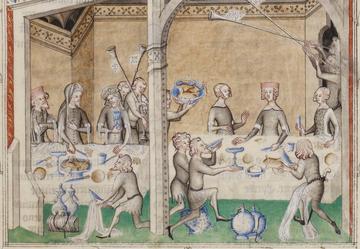
Excellent to hear! What do you think is original about the project’s approach to medieval European culture and what kind of original thoughts can we extract from it at the end?
“I think MALMECC goes beyond most projects in terms of the degree of cooperation between various research techniques and interests. While it has music in the title, it is less geared towards a specific view of music’s place in the world or having to channel everything through discussions of music. The broader disciplinary scope of the project means it is more able to bring together what are really independent, wide-ranging interdisciplinary examinations.”
Uri, I know that you have your own specialism within the project, so I thought it might be interesting to hear which aspects of courtly culture in medieval times you find most interesting and why that might be.
“Well, I have been working on French music for more years than I care to remember by this point – music throughout the 14th and 15th centuries - so I was naturally attracted to that aspect of the project. A while ago, I also worked on a project collating a new edition of the works of Guillaume de Machaut, which involved transcribing, translating and looking at manuscripts with very close attention to the words and notes, which on the one hand was fascinating and I enjoyed it very much, but on the other hand raised a lot of questions that I was able to follow up on at the time. Questions such as: What would you do with these notes afterwards? How would they be understood? Would they be listened to? Are they (the scripts and scores) just objects to look at rather than to listen to? How widely were these materials distributed? How did they sit alongside other non-musical aspects of culture in the wider social context? That’s where this project comes in. It allows me to look at similar material, but from an entirely different starting point. I hope I can bring my previous knowledge of manuscripts and experience of analysing cultural materials to the process of re-examination in a wider context now.”
What would you like to achieve through the work of this project?
Within the project, my main goal is perhaps best described as disciplinary. In conversation with musicologists, I’d like to encourage the trend away from ‘pure’ musical interests and musical abstractions. Instead, I try to show how deep the need is to examine musical materials also when they are not being used for music making, as material presence, as well as to improve our models of engaging with music’s mediation through performance. When working with non-musicologists – researchers in literature, poetry, art history and architecture – I want to encourage them to connect with the idea of performance of sounds and music, even without having specialist training in music. Researchers perceive a lack of training in music as a barrier and it is often the case that when you mention medieval music, they say, “Oh, I don’t know anything about that. Let’s look at something else!” so I’d like to help break down those barriers.
It has always been the case that music is not just for specialists. I’d like to work on expanding the understanding of music as a social topic within the context of other aspects of culture. Analysing music by itself makes little sense and one should try to understand everything from architecture to fashion in order to be able to find a starting point for analysing the notes. If we start by analysing the notes on the page and only then move to thinking about who listened to them and what their preconceived notions and mental attitudes towards listening were, there is a risk that we base our initial analysis on our own knowledge and attitudes, rather than trying to understand what the music meant to its listeners at the time. That’s why a project that considers music in its wider context is very important to me.
The trick, of course, is to try and talk to both audiences at the same time.”
That is fascinating! We look forward very much to hearing more and learning about its conclusions as the project progresses. Thank you very much for your time today. We are grateful to Uri Smilansky of the MALMECC project for those thought-provoking insights.
Blogs 05 2019 - 11 2019
Uri Smilansky
First days are always stressful, especially when your new colleagues seem to know everyone already, and are willing and ready to fulfil any request made of them. Such days are even more intimidating if one arrives four years into a project to be presented with a smooth-running operation which has established its own protocols and habits. But enough about me. This is not about the new team members at MALMECC: we have been warmly welcomed by both the existing team and the wider scholarly community during the project’s conference and got stuck straight in with the work. No, I am thinking of men such as Raoul de Vienne, lord of Louppy, who on Thursday, October 9th, 1354 made his first contact with the court of the relatively new regime of King John ‘the Good’ II of France (1319-64, reigned from 1350 to his death). Raoul was by then an experienced courtier, having already served the previous monarch, Philip VI, yet, during the intervening years his services and personal life has been interwoven with the cause of Charles II ‘the Bad’ of Navarre (1332-87, reigned from 1349) during this turbulent period in French political history. Still, upon such first contact, Raoul—as would any aspiring courtier—would have needed to quickly assess the cultural environment of the court. A lack of proficiency in this could easily end up in missed opportunities if not actual trouble for anyone whose career relies at least in part on grace and favour. Tastes and fashions change, and keeping up both with patrons and competitor-courtiers was essential, then as now, in a corporate environment. A celebrated career as, among other responsibilities, governor of the Dauphiné in the 1360s and 70s suggests Raoul’s success in this regard.

It is safe to assume that new arrivals at court did not go through an official induction process. Still, most courtiers would have already been trained, acculturated and active within broadly similar courtly environments. The specific need for assimilation upon arrival, therefore, would not have related to the underlying, systemic elements on which this culture was constructed, but on the subtleties differentiating this court, at this point of time, from any other. We all know how theory and practice differ in social situations, and how thin is the line between standing out and putting your foot in it. In both forming such cultural assessments and projecting their own identities, courtiers such as Raoul would have relied on fleeting, partial, and indeed, accidental exposure to a court’s culture. By the placing of luxury artefacts at the foreground of the courts’ operation, they would have suggested themselves as a primary port of call when making their judgements. In this process, immediately recognizable visual tropes communicating value and identity more efficiently than subtleties of details and their potential interpretations.
As part of my project, I am interested in this kind of exposure: in how we can understand its processes or analyse the effect objects had within this setting. Identifiers of courtly status and uniqueness could be very subtle and wide-ranging. They did not apply only to a court’s visual currency, and within that currency, not only to the kind of objects and visualities I intend to explore. My emphasis on books—and in particular, the sub-set of luxury books containing secular music—is due to their multiple ontologies. Their place in cultural discourse stretches over a wide range of interactions. At different times and contexts, they can be examined for their external material worth, size and craftsmanship; their internal artisanship and presentation; they can be contemplated for their contents on both the single piece and collection level, their technique and their emotional effect; within their content, they often act as commentators on their own cultural context; they can act as a focal point for performance, and as the starting point for debate beyond it. The concentration on music and secularity removes any vestiges of practical need, making their functionality and performativity purely cultural; through the peculiarities of musical notation and the demands of its performance, this also strengthens the performative element of books’ essence, weakening the claim of the private readers; finally, they engage with a further level of professional mediation, both copyists and performers. I hope to get to performance, audibility and close interpretation later on in the project. For now, I limit myself to exploring the effects of presentation, layout, font, and notational technique on the visual impact of such artefacts and the meanings such impact conveyed from the courtier point of view.
Raoul’s example is interesting also in this regard, as not only did he share political interests and a network of patronage with Guillaume and Jean de Machaut, but his name appears as one of very few people to be named within Guillaume’s poetry. As it is often difficult to find evidence of cultural activities even for well documented figures, this link is really intriguing. Machaut’s multiple manuscript-collections of text and music are prime surviving examples of the kind of object I am pursuing. In looking at them, I ask not what they say about Machaut, but about their owners; I do not compare the quality of readings, but the effect of their general presentation. This releases my inquiry from the notion of ‘oeuvre’ or ‘urtext’, making sources usually dismissed as peripheral or partial just as relevant as those associated with the author himself.
Results to be reported in due course!
Uri
Further reading:
Raymond Cazelles, Société politique: noblesse et couronne sous Jean le Bon et Charles V (Librairie Droz, 1982).
Lawrence Earp, Guillaume de Machaut: A Guide to Research (New York: Garland, 1995).
Malcolm Vale, The Princely Court: Medieval Courts and Culture in North-West Europe, 1270-1380 (Oxford, 2001).
Following on from the first post in this series, in which David Murray discussed Pilgrim II’s circles in Avignon, he turns now to the members of Pilgrim’s court once he ascended to the Throne of St Ruprecht and became Archbishop of Salzburg.
Medieval Salzburg sat very much in the middle of things: in terms of secular geography, one might think of it as lying somewhere between Wittelsbach Bavaria and Habsburg Austria (and I wrote in my last blogpost about some of Archbishop Pilgrim’s familial connections with the Habsburgs). Alternatively, in terms of the fourteenth-century Church, Salzburg’s ecclesiastical direct influence extended from the middle of Bavaria, where Freising (near Munich) was the seat of a suffragan bishopric, to the north of modern Italy, where another Salzburg suffragan was Bishop of Brixen. The bishop of Salzburg was also secular lord over much land in Styria, reaching into modern Slovenia. By another measure—as evidenced by Archbishop Pilgrim’s machinations in order to hasten the end of the Great Schism—the city on the Salzach lay in the overlap between the Pope in Avignon (or so Pilgrim said—his Chapter, by contrast, held true to Rome) and the King of Romans in Prague.

A view of Salzburg from Hartmann Schedel’s Weltchronik of 1493. Now Weimar, Anna-Amalia Bibliothek, Inc. 122
Just as the Hochstift as an institution can be thought of on multiple overlapping maps, so too were the individual courtiers and hangers-on around Pilgrim von Puchheim players in various different spheres. Two instances are particularly illuminating, and not least of all because they are individuals who were particularly close to Pilgrim. The first, Haug von Goldegg, to whom the rest of this post is devoted, was a secular member of the archiespiscopal court. My next post will be focussed on Wilderich de Mitra, Pilgrim’s chancellor and a cleric.
Haug von Goldegg was the last of a dynasty of Salzburg nobles, part of a class whose social position came from long years of service to the archbishops. Though the Goldeggs had come down in the world since their glory days in the early fourteenth century, they remained hereditary butlers to the Archbishop. They were still a force to be reckoned with at the end of the century, and that was all due to salt. Salzburg made much of its money from the production and shipping of salt, essential to the preservation of meat before the advent of the refrigeration, and the Goldeggs were major players. Of the saltworks, four belonged to the archbishop, while others belonged to, or supported, the abbey of St Peter, Nonnberg convent, and cathedral chapter in Salzburg (where Haug’s brother Wulfing had been a canon since the 1350s). The abbeys of Raitenhaslach (Bavaria) and Salmansweiler (Swabia, now better known as Schloss Salem) both had an interest in saltworks near Salzburg. But on their own, the Goldeggs owned five saltworks. It is hardly surprising then, that, when the main line of that family died out in 1400, the jostling of more distant relatives for a piece of this rather savoury pie was enthusiastic.

The Castle and Lake at Goldegg. The present Castle goes back to a fortress built from 1323 by Wulfing, grandfather of Haug and close ally to the earlier Salzburger archbishop Friedrich III von Leibnitz.
Haug was clearly a close associate of Archbishop Pilgrim. It is tempting to put this down to a similar taste for display. For instance, when Pilgrim travelled to meet the dukes of Bavaria in 1387 at the abbey of Raitenhaslach (a meeting, incidentally, that ended with Pilgrim being held hostage by the Bavarians for several months), the two travelled together in some style:
Pilgrim was accompanied by 34 knights and noble pages, partly members of his Council and of the Salzburg Stiftsadel, partly squires of the Hofgesind, his entourage of armed mercenaries. There were also guards, chamberlains and two pipers, then the servants of the noblemen. The most distinguished of Pilgrim’s companions, Sir Haug, the last of the Goldeggs, himself had another four knights and six pages with him. (Klein 1972/73: 50-51; my trans.)
Haug also interacted with other members of Pilgrim’s court. For instance, Pilgrim’s steward Reicher von Rastat re-founded the church of the Virgin at Altenmarkt in the Pongau valley (you can see an earlier post about Reicher and the Virgin here), and following the fourteenth-century devotion to the Holy Family, built a new chapel dedicated to Sts Anne and Achatius, one of the Seven Holy Helpers.
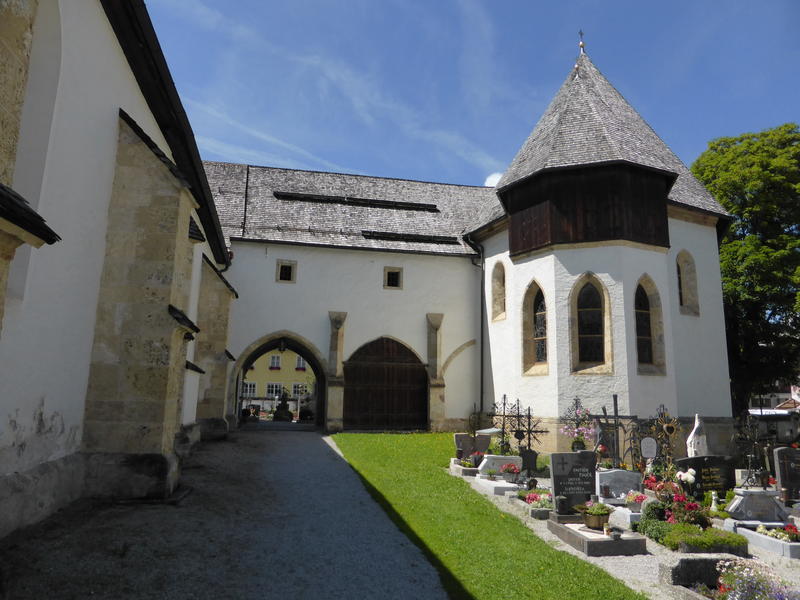
The chapel of Sts Anne and Achatius in the churchyard at Altenmarkt.
Haug von Goldegg, himself closely linked with the Pongau as it was the centre of his family’s lands, is mentioned in a charter of 1398 as giving extensive lands to Reicher’s chapel and the associated confraternity of St Anne in Altenmarkt (Martin 1947: 50). This may well be thought of as an ailing man (as noted already, he died only two years later) who was experiencing extreme financial difficulties at the time, making sure that things were a little better on the other side. The fact that Haug did this by supporting the religious work of Reicher, who, as magister curie oversaw Pilgrim’s extensive domains, is suggestive of his well-connected place in the Archbishop’s circle. Haug’s own indirect religious donations were made to pay for a weekly mass at the church in Goldegg. A charter of 1375 shows them releasing lands to be given by Marchart der Pründlinger to the parish of St. Veit im Pongau, a town around four miles away.
If it is reasonable (and I leave the question open to you…) to judge someone by the company they keep, Haug von Goldegg, last of his dynasty might be thought as the perfect counterpart to Pilgrim. Both were without direct heirs, but nonetheless engaged in the sometimes desperate attempt to shore up or expand their empire. Both of them, although this is hardly unusual in the fourteenth century, took steps to ease their fate after death (Pilgrim established a spectacularly well-endowed chapel next to the Cathedral), and both were given to a certain amount of ceremony as they thought befitting their status.
In my next post, I turn to another figure who seemed to gain Pilgrim’s respect, the doctor in decretis, Wilderich de Mitra.
Further reading
Klein, Herbert, ‘Der Streit um das Erbe der Herren von Goldegg’, Mitteilungen der Gesellschaft für Salzburger Landeskunde, 82/83 (1942/1943), 1–48
Klein, Herbert, ‘Erzbischof Pilgrim II. von Puchheim (1365-1396)’, Mitteilungen der Gesellschaft für Salzburger Landeskunde, 112/113 (1972/1973), 13–71
Martin, Franz, Salzburger Archivberichte 2.2 Politischer Bezirk Bischofshofen, Beihefte zu den Mitteilungen der Gesellschaft für Salzburger Landeskunde, 2 (Salzburg: Gesellschaft für Salzburger Landeskunde, 1947)
Schneider, Christian, Hovezuht: Literarische Hofkultur und höfisches Lebensideal um Herzog Albrecht III. von Österreich und Erzbischof Pilgrim II. von Salzburg (1365–1396) (Heidelberg: Winter, 2008)
Vones, Ludwig, Urban V. (1362-1370): Kirchenreform zwischen Kardinalkollegium, Kurie und Klientel, Päpste und Papsttum, 28 (Stuttgart: Hiersemann, 1998)
In this series of three posts, David Murray writes about some of the connections between his favourite Archbishop of Salzburg, Pilgrim II (r. 1365-1396) and other figures in the medieval Church, as well as some of Pilgrim’s secular allies.
The Puchheims were a well-established family of ministeriales with close ties to Vöcklabruck in Styria, and had long entertained connections with the archbishops of Salzburg. But it was to the Habsburg Dukes of Austria that they owed their allegiance, and so they had re-located to Lower Austria in the thirteenth century to be closer to Vienna. Their devotion to the dynasty was rewarded by being named to the office of Hereditary Steward to the in 1276. (Holders of this office received tribute in the form of pelts from monasteries, whereas towns, amusingly enough, were expected to offer a sturgeon.) They remained distinguished figures on the Austrian scene well into the eighteenth century, when the last of the direct line, Anton, Bishop of Wiener Neustadt, dies in 1718.
Credit: © Salzburg, Archiv des Erzbistums Salzburg, n. 421 (1372 II 25)
The biography of Pilgrim von Puchheim, who rose to be archbishop of Salzburg, is rather sketchy in its early years. He was probably born in the 1330s, the younger son of Pilgrim IV’s second marriage to Elisabeth von Trautmansdorf. As the younger son of a second marriage, it was perhaps unsurprising that he was destined for the church. By 1353 he was a member of the cathedral chapter of Salzburg (when his brother gave him the revenues coming from lands at Wulffingstein), although he only received priestly orders the following year. The fact that this happened at the hands of Nicola Morosini in Castello, one of the islands of Venice, could indicate that Pilgrim was studying at Padua, renowned for its teaching of canon law.
It is, however, certain that Pilgrim studied canon law at the University of Avignon. This was an unusual choice for someone from the Habsburg lands, as they tended to favour Bologna or Paris, or, later, Prague and Vienna. With the exception of a dispute in the early 1360s about the payment of his canonical income during his studies, the next thing we hear about Pilgrim is when has was named papal chaplain to Urban V in October 1363. After a contested election in 1365, Pilgrim was provided with the archiepiscopate of Salzburg on St Andrew’s Day of the same year.
So there is a long period when we cannot say a great deal for certain about Pilgrim’s activities. Herbert Klein, author of one of the most extensive studies of Pilgrim’s life, names one particular figure as an important protector to Pilgrim during this period. He is Guillaume d’Aigrefeuille the elder, known as the Cardinal of Saragossa. Through him, Pilgrim can be seen making his way into a Limousin faction at Avignon that would colour his politics and diplomatic choices throughout his reign.
Paris, BnF, lat. 11907, ‘Les papiers de Montfaucon’, f. 244.
A 1726 drawing of the tomb of Guillaume d’Aigrefeuille the Elder in St Martial in Limoges
The Aigrefeuille dynasty was one of the most successful and omnipresent in papal Avignon, a fact no doubt aided by their being cousins to Clement VI. The careers of a single set of brothers, the sons of Guillaume d’Aigrefeuille, makes clear just how spectacular their good fortune was:
- The eldest son, Aymar, who became Marshall of the Papal palace in 1362.
- Guillaume (that is, the son of Guillaume—inventive naming, there), who is thought to have been protector to Pilgrim von Puchheim, had received his cardinal’s hat by 1350, and went on to become camerlengo in 1363.
- Pierre was Bishop of Clermont and Uzès. His vicar-general was Guillaume de Grimoard, who went on to become Urban V, under whose reign Pierre became bishop of Avignon.
- Raymond was Bishop of Rodez until his death in 1361.
- The youngest son of the generation, Faydit, took over from his brother Raymond as Bishop of Rodez, before going on to inherit the bishopric of Avignon from his other brother Pierre. Talk about hand-me-downs… His career led to a cardinal’s hat in 1383.
https://www.horizon-provence.com/avignon-museum/petit-palais-museum-avig...
The Petit Palais, residence of the Bishops of Avignon, including Pierre and Faydit d’Aigrefeuille
The next generation of ecclesiastical Aigrefeuilles was less numerous, but no less successful. Aymar’s son, yet another Guillaume, also rose to the College of Cardinals. This third Guillaume, papal diplomat and jet-setter (or, more likely, donkey-sitter), would later be party to one of Pilgrim’s great wheeler-dealer exploits: the attempt to end the Great Schism.
Paris, BnF, Estampes et photographie, N-2
An early modern imagining of the face of Guillaume the younger
Clement VII appointed the younger Guillaume d’Aigrefeuille to act as his envoy to Charles V, who received him at Vincennes in May 1379. He then spent the next six years travelling the Empire, trying to win over princes for the Avignon observance. Pilgrim, along with his ally Leopold III of Habsburg, was one of the major Avignon agitators in Central Europe. Indeed, Guillaume d’Aigrefeuille had planned to attend the Salzburg provincial council in 1380 when Pilgrim hoped to convert his see to Avignon. Neither the visit nor the conversion came to fruition. But (as a future blogpost in this series will show), Guillaume the Younger was in a position to help Pilgrim by helping his respected chancellor Wilderich de Mitra when he was accused of being schismatic. All of this to say, then, that even in cases where we do not know very much about exactly what a person did, knowing who they knew can also be highly enlightening.
The Tour St-Jean, part of the remains of the livrée of Guillaum d’Aigrefeuille the Younger.
Further reading
- Creytens, ‘Le “studium romanae curiae” et le maître du sacré palais’, Archivum Fratrum Praedicatorum, 12 (1942), 5-83
- Klein, Herbert, ‘Erzbischof Pilgrim II. von Puchheim (1365-1396)’, Mitteilungen der Gesellschaft für Salzburger Landeskunde, 112/113 (1972/1973), 13–71
- Lackner, Christian, Hof und Herrschaft: Rat, Kanzlei und Regierung der österreichischen Herzöge (1365-1406), Mitteliungen des Instituts für Österreichischen Geschichte, Ergänzungsband, 41 (Vienna: Oldenbourg, 2002)
- Steinherz, Samuel, ‘Das Provincial-Concil von 1380’, Mitteilungen der Gesellschaft für Salzburger Landeskunde, 39 (1899), 83–110
- Vones, Ludwig, Urban V. (1362-1370): Kirchenreform zwischen Kardinalkollegium, Kurie und Klientel, Päpste und Papsttum, 28 (Stuttgart: Hiersemann, 1998)
After a series of study days held in Oxford, the MALMECC team co-organized a conference at the University of Liège with the local research unit Transitions: Moyen Âge et première Modernité. Focused on the much debated question of ‘Transnationalism’, it gathered researchers from both the continent and from the UK. Speakers continuously crossed disciplinary borders and historiographical traditions, creating great discussions during the conference and dinner.
After welcoming speeches by Marie-Élisabeth Henneau (co-director of Transitions) and Karl Kügle (MALMECC Principal Investigator), the audience quickly entered the main conference theme, Transnationalism and fourteenth century Europe. Through the case study of the late medieval Luxemburg dynasty, Michel Margue and Eloïse Adde addressed the central question “is it relevant to use the modern concept of ‘Transnationalism’ when studying a period, the Middle Ages, which did not know ‘nations’, in the sense of the modern concept?” The answer seemed to lie in the multiple tensions that continuously shaped medieval courts around multi-faceted, successive or simultaneous, cultural influences. “Transnationalism” was a phenomenon first conceived in the modern sense in the context of the geopolitics of the 1960s . It was intended to take into account political actors that were not themselves national states—even if some of them ultimately so—but nonetheless had an important role in politics (e.g. during the decolonization process).
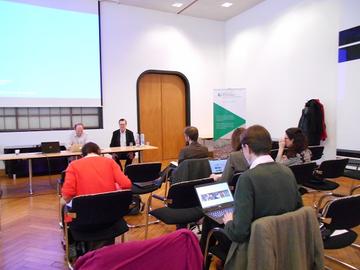
The concept of transnationalism may thus help us to understand that there was no such thing as a clear, homogeneous and undebated courtly identity in the Middle Ages. The weight of cultural actors did not depend on how close they were to the centre, and peripheries could also create lasting models, which were sometimes adopted by the centre itself.
Nicola Morato then drove discussions concerning the difficulty of following the popularity of a text throughout its history. Reflecting on the Guiron cycle, he convincingly proposed than in order to get a better idea of this, we could use the stemma codicum. This kind of genealogical tree was originally created to follow the evolution of a text through history, each major change in it creating a new “family”. But this could also be used to consider which versions remained appreciated without major changes and how cultural context could explain major or minor, changes in texts (i.e. by introducing, reshaping or cutting off episodes).
Alain Marchandisse showed, through a careful study of marriages organised by the Burgundian Valois dynasty, (and more particularly some that involved their allies, the Rheinish family of the counts of Clèves), that weddings created the space for cultural transfers, but also that finding “foreign” husbands or wives was a way of strengthening a political power inside given geographical limits.
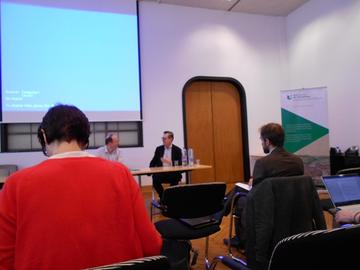
After a well-deserved lunch, two members of the MALMECC team introduced their research. David Murray emphasized how Pilgrim archbishop of Salzburg was a witness, if not a supporter, of the introduction of French, and more largely Latin musical and literate models into a Germanic city. This echoed what was discussed before, that there was hardly such a thing as a definitive and geographically-driven courtly model (or models) in fourteenth century Europe.
Laura Slater then thoroughly illustrated how counts of Namur, in modern-day Belgium, proved keen to emulate British fashion. They ordered several sets of needlework following the opus anglicanum (the British way). This was not just a political statement it seems, even if there were regular and strong connections between the Low Countries and England at the time. Aesthetic choices clearly went from one place to another as long as they looked nice, or should we say prestigious, enough to potential owners. This prevented the emergence of an overwhelmingly local, pre-national taste, and encouraged long-distance cultural transfers.
Mario Damen was the last speaker of the day. He dedicated his talk to a well-known, and very cinematographic expression of late medieval courtly life, tournaments. Going beyond the Huizinga view of a declining chivalry fooling itself with pointless ceremonials, Mario rightfully highlighted how these events were key in the ongoing reconfiguration of noble identity, amongst other things in its relationships with an ambitious, and possibly stronger than ever, overlord, in this case the duke of Burgundy, later succeeded by the Holy Roman Emperor Charles V.

The second day of the conference started with a series of trips between Savoy and England, following the paths of Savoy military architects to Wales and English chivalric offerings to the Alpine earldom. Eva Pibiri made a case for how strong mutual influences partly shaped late medieval martial and chivalric practices. Savoy appears as an ideal model to understand how a princely court could serve as a crossroads of various influences.
Karl Kügle went on crossing borders by following ecclesiastics and music practitioners who did not confine their musical career to a single geographical area. Karl convincingly demonstrated that this approach appears to have been key not only for collecting high positions, such as pope, but also for ensuring the circulation of musical models.
In the last session, Christophe Masson studied the courts of the Avignon cardinals using transnationalism. He argued that cardinals contributed to the survival of the late medieval Church organization, and ensured their role inside it, by merging multiple influences into their cultural practices. Far from slavishly replicating their diplomatic choices, culture was used by cardinals to express that they were not just “nationals” from a given kingdom or principality but were strengthening and defending the universal power of the Church.
The last speaker of the conference was Jane Gilbert. Echoing the first presentation, she explored how the creation of noble or dynastic identities was produced by a constant dialogue between a number of actors. Moreover, the case she discussed, the one of an Alexandre manuscript, offered numerous examples where creators of the actual volume (that is scribes and painters) showed themselves shaping these aristocratic identities, through marginal illustrations and even inside the text itself.
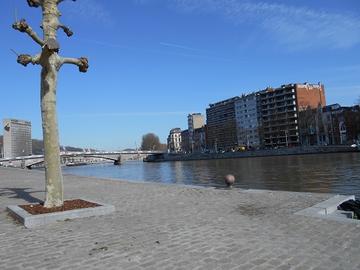
The conclusions were delivered by Eric Bousmar. Amongst the several points he emphasized and connections he made, it is worth keeping in mind that courts were a nexus. Often ‘composite’, that is created by a personal union of various territories (see the dominions of the dukes of Luxemburg or Burgundy), late medieval polities may have gathered several courts, instead of merging all of them into one, as it was the case in “complete states” (such as the kingdom of France). Nonetheless, personal union and complete state appear quite close to each other on several levels. The number of transfers occurring at courts were extremely numerous. The non-existence of a (pre-)modern state did not prevent either local identity or shared cultures from developing. Additionally, all of these influences had so many origins (family, education, political obligations or ambitions, careers, personal experiences, to name but a few) that they should be considered as complementary, not as hierarchical.
Transnationalism may thus be one of the tools we need to properly understand how states interacted in the Middle Ages, and how they were seen by fourteenth century courtiers.
The MALMECC project would like to thank all organisers and participants for their help in making the conference a success. We look forward to seeing you again soon.
In this post, David Murray writes about the importance of the Virgin Mary in and around 14th century Salzburg.
It would be an understatement to say that the fourteenth century was quite keen on the Virgin Mary.
In Salzburg, the parish church, now known as the Franziskanerkirche, was dedicated to the Virgin, as were the Nonnberg convent near Salzburg and the Eigenkloster at Admont in Styria. Mary is also, unsurprisingly, heavily represented in the religious songs that were composed at the court of Archbishop Pilgrim II and transmitted to us attributed to the anonymous ‘Monk of Salzburg’. The religious pieces combine a varied selection of translations of Latin hymns and sequences from the liturgy with more idiosyncratic compositions and pieces sharing characteristics with the German Meisterlieder of the time. Of the forty-nine religious songs in the corpus, twenty are devoted to the Virgin.
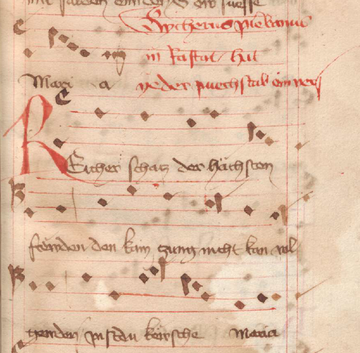
‘Richer schatz der höchsten freuden’, in Munich, Bayerische Staatsbibliothek, Cgm. 715, f. 12r.
Two of the sequences speak particularly eloquently to the value of Marian devotion in Salzburg. One, entitled ‘Plum gezartet, ros an doren’ (‘Delicate flower, rose without thorns’), is decorated with an acrostic so that the first letter of each versicle together spell PYLGREIM ERCZPISCHOF LEGAT, a clear reference to archbishop. Another, ‘Reicher schatz der höchsten freude’ (‘Rich treasury of the greatest joys’) has an acrostic reading RICHERUS PLEBANUS JN RASTAT.
We can identify this Richerus as Reicher von Ettlingen, mentioned in 1384 in the liber vitae of St Ruprecht (that is, the book in which the cathedral community recorded the name of the souls for whom it was to pray) as being rector parrochialis ecclesie Rastat et quondam magister curie. A Member of a Bavarian noble family, Reicher, as Hofmeister, was responsible for managing the central portions of the archiepiscopal estates.
Rastat (now spelled Radstadt) in the Pongau valley was, as the impressive town walls still demonstrate, an important centre for archiepiscopal authority.
The song, ‘Reicher schatz der höchsten freuden’ has a particularly ornate text, with rhyme upon rhyme mirroring the unlimited joys as well as the help that Mary was thought to offer worshippers. For example, the third double versicle reads:
Engelischer gruss dich grüsset,
götlich süss dich übersüsset,
dein suss wais chain pitterkhait
The angelic greeting greets you
divine sweetness makes you sweet all over
your sweetness knows no bitterness
Reicher seems to have been particularly devoted to Mary, and his devotions extended far beyond song: his seal shows a Virgin of Mercy, with Mary sheltering the people under her cloak (a popular piece of Marian imagery that is also picked up in the Monk’s song). Perhaps most striking though is the statue of the Virgin and Child that he appears to have acquired in 1393 for the parish church at Altenmarkt. The statue, which stands at 80cm in height is a particularly fine and relatively early example of the so-called Beautiful Madonna. I recently made an academic pilgrimage to Altenmarkt to visit the statue.
The Altenmarkt Madonna in close-up.
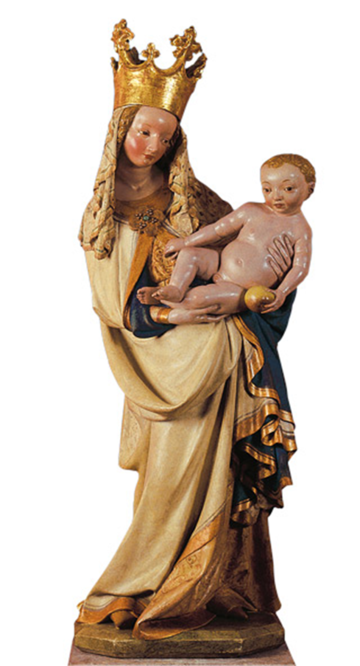
The date for the statue’s arrival in Altenmarkt can be deduced from an indulgence promising the remission of forty days for all those who prayed before this particular statue, signed by the papal nuncio Ubaldino de Torres in Prague. This may or may not align with the three trips that Pilgrim von Puechheim made to Prague to try to win over King Wenceslaus for the Avignon obedience. In the seventeenth century, the statue is recorded as having been on display ‘on a pine tree’ in the churchyard. (The image of an enormous, year-round Christmas tree in Altenmarkt, complete with Marian angel-replacement is rather terrific. But given that the statue is made of cast stone, and thus not of the lightest, this picture does not seem entirely likely. Suggestions on a postcard please…)
Indeed, so prominent is Mary that she makes her way into songs where, normally at least, she would not be expected. For instance, ‘Sälig sei der selden zait’ (‘Blessed be the time of salvation’) is a contrafactum of a Latin sequence with the title ‘Mundi renovatio’. (Contrafacta are songs sung to the tunes of already existing songs; so, for example, ‘The Red Flag’ is a contrafactum of ‘O, Tannenbaum’.) The text of ‘Mundi renovatio’ is a very well-known celebration of the Resurrection and thus focussed on Jesus and Easter, and may have been composed at the Abbey of St Victor, responsible for something of a revolution in sequence composition in the twelfth century. By contrast, the German text composed to be sung to this melody in Salzburg is as much concerned with the Virgin as it is with Christ. Mary, it proposes is actually an essential part of Easter, because without her, there would have been no Jesus to crucify. By singing this text with a shifted focus to an older tune that many people would know to ‘mean’ something rather different, the poet was able to blend together two ideas into one new song.
The Altenmarkt pietà, c.1410-1420.
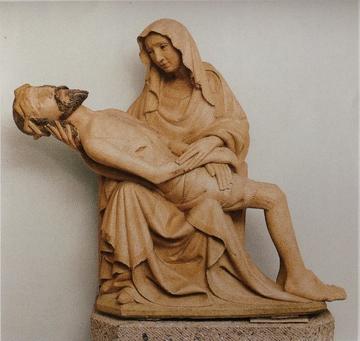
Another late medieval sculpture in Altenmarkt, which dates from after Reicher von Rastat’s tenure (it seems to date from the first fifth of the fifteenth century), is an example of a very popular version of the pietà, in which the Virgin holds the body of the crucified Jesus.
The book-end to the Madonna and Child, the pietà, or Vesperbild as it is called in German, it speaks of an intense engagement with the Easter story in this corner of the world, of a kind also found in one of the more unusual pieces of the Monk of Salzburg.
‘Die nacht wirt schir des himels gast’ (‘The night will soon leave the skies’), narrates in vivid manner the events of the Passion, with one strophe for each of the canonical hours (matins, lauds, prime, terce, sext, nones, vespers, and compline).

The strophe for vespers ends with these lines:
man legt in da mit jammer groß
Maria toten in ir schoß.
vil haisser zäher sie vergoß
und halst in minneclich.
sie kusst in oft in irem laid
und sprach: ‘mein liebste augelwaid,
mein chind, so ich nun von dir schaid,
wer sol dann trösten mich?’
sie wand vor laid ir weissen hend
mit innerm seufzen ser:
‘ich bin so jemerlich ellend
und enwaiß wo ich hin ker.’
They lay him there, with great anguish,
Dead in Mary’s lap.
Many hot tears she shed
And embraced him with love.
She kissed him often in her sorrow,
And said, ‘My dearest darling,
My child, now that I leave you,
Who will be my comfort?’
She turned her white hand for sorrow,
With deep and inmost sighs.
‘I am so miserably anguished
And do not know where to turn.’
The fervour behind Marian devotion in fourteenth-century Salzburg and its area of influence, then, crossed the boundaries between media and points to an immersive religious experience for the worshipper. The vividness of the statuary in circulation (look, for instance, at the way the Madonna’s fingers depress the flesh of the infant Jesus in the Altenmarkt Madonna) echoes both the grandeur and the emotionality of the songs dedicated to Mary which are attributed to the Monk of Salzburg. Mary, then, was present to her worshippers in music, words, and physical representations, and at all points in-between.
Further reading
Hamburger, Jeffrey, ‘Rahmenbedingungen der Marienfrömmigkeit im Spätmittelalter’, in Schöne Madonnen vom Rhein: Eine Veröffentlichung des LVR-LandesMuseums Bonn, ed. by Robert Suckale (Leipzig: Seeman, 2009), pp. 121-137
Kvapilová, Ludmila, Vesperbilder in Bayern von 1380 bis 1430 zwischen Import und einheimischer Produktion (Petersberg: Imhof, 2017)
März, Christoph, Die weltlichen Lieder des Mönchs von Salzburg: Texte und Melodien (Tübingen: Niemeyer, 1999)
Spechtler, Franz Viktor, Die geistlichen Lieder des Mönchs von Salzburg (Berlin & New York, De Gruyter, 1972)
In the second of her blog posts on Aachen Cathedral, Laura Slater muses on some of the pieces in the Aachen Cathedral Treasury, and Charles IV's penchant for relics...
Later medieval rulers from across Europe looked up to Charlemagne as an exemplary, even holy ruler of Christendom. Charlemagne was canonised as an (unofficial, locally rather than papally recognised) saint in 1165 by Emperor Frederick I Barbarossa. The glittering shrine of Charlemagne was completed in 1215 at the coronation of Emperor Frederick II of Hohenstaufen, who added the final nail.
The shrine of Charlemagne (please click for more detail)
It looks like a miniature church, but there are no saints seated under the gilt arcade, as we might expect for the tomb of a holy man. Instead, each side of the shrine depicts eight successors of Charlemagne. At the front of the shrine, we see Charlemagne enthroned, flanked by smaller, standing portraits of churchmen. The shrine forms a grand celebration of secular, imperial power and the special status of the Holy Roman Emperors.

According to later medieval legends, Charlemagne was thought to have gone on crusade in the Holy Land and brought back many important relics of Christ. He inspired kings such as Louis IX of France to do the same. The ‘Charlemagne window’ in Chartres cathedral, dated to around 1225, shows Charlemagne victorious against the ‘Saracens’ in the Holy Land and then going on crusade in Spain, fighting the Moors.
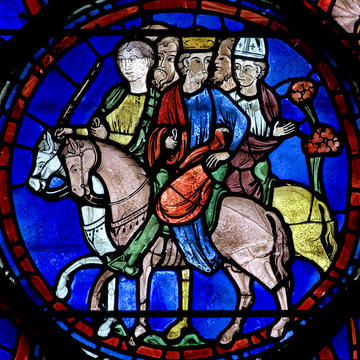
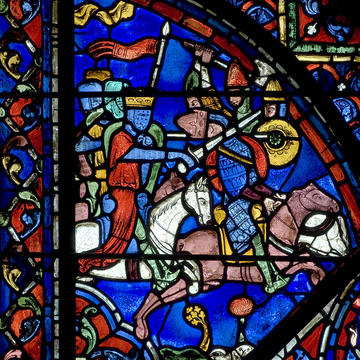
In his fourteenth-century Voeux du Paon (Vows of the Peacock), written around 1312 for Thiébaut of Bar (the powerful prince-bishop of Liège), Jacques de Longuyon classed Charlemagne as one of the Nine Worthies, exemplars of chivalric virtue and prowess. In 1332, Philippa of Hainault gave her husband, Edward III, a silver gilt cup and ewer decorated with images of the Nine Worthies, including a portrait of Charlemagne.
Charles IV of Prague, who was crowned Holy Roman Emperor in 1346 and 1349, was also a fan. He is thought to have been the donor behind this spectacular reliquary, containing Passion relics of Christ and, most prominently, a supposed arm bone (which is actually a leg bone) of Charlemagne. Among the other relics in the reliquary is a tooth of St Katherine, who had been Charles’s personal patron saint ever since his victory in the Battle of San Felice on St Katherine’s day (25th November) 1332. The reliquary also holds three teeth of Charlemagne. In 1349, at his imperial coronation in Aachen, Charles IV had received a ‘gift’ of three teeth of Charlemagne to take back to Prague with him. Charles IV was notorious for swiping relics everywhere he went. Religious houses and cathedrals were forced to give ‘diplomatic gifts’ of whatever relic Charles wanted. To avoid the risk of losing their precious relics, sometimes monks and clerics would hide them in advance of his arrival: if he didn’t see them, he couldn’t ask for them! But this time, at least, Charles seems to have returned the relics back to the cathedral treasury at Aachen, suitably and splendidly framed for public display.
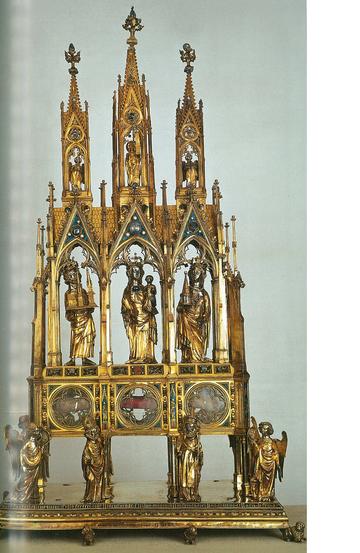
Charlemagne is the gilt figure standing on the far left of the reliquary, with the Virgin Mary in the centre and St Katherine on the far right. He is holding a miniature church: a model of Aachen Cathedral, celebrating the emperor’s role as founder.
Reference:
Herta Lepie and Georg Minkenberg, The Cathedral Treasury of Aachen (Schnell and Steiner: Regensburg, 2010)
After the workshop in Liège, the MALMECC team went to visit Charlemagne’s palace chapel in Aachen, also known as Aix-la-Chapelle. Charlemagne (742-814) was one of the greatest medieval rulers. Starting out as king of the Franks, his Frankish empire spread to cover large parts of present-day France, the Benelux countries, Germany and Italy. In 800, he was crowned ‘Emperor of the Romans’ by Pope Leo III in Rome, marking the start of the Holy Roman Empire.

The courtyard of Aachen Cathedral
Charlemagne and his son, Louis the Pious, oversaw what has been called the ‘Carolingian Renaissance’: a revival of art, scholarship, classical learning and Christian culture that saw men such as Alcuin of York become master of the palace school in Aachen, where he taught Charlemagne and his family alongside young men sent to school at the Carolingian court. Aachen became the imperial capital of the Carolingian dynasty. Charlemagne built a grand palace (which no longer exists) and a palatine chapel that today forms the heart of Aachen Cathedral.
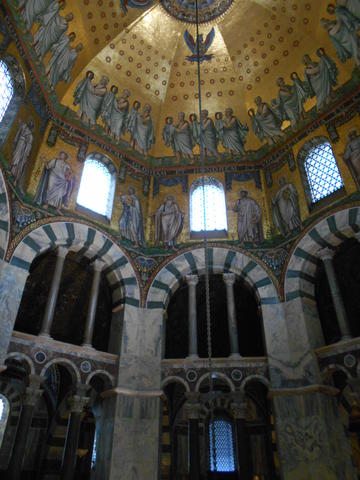
Charlemagne’s palace chapel was built around 792 and dedicated to the Virgin Mary. It is a centrally planned building topped by an octagonal dome.
The architectural plan recalls the Church of the Pantheon in Rome, a former Roman temple rededicated to the Virgin. It also echoes two of the holiest places in Jerusalem: the Anastasis Rotunda housing the tomb of Christ in the Church of the Holy Sepulchre, and the circular Dome of the Rock, the Islamic holy place built c. 692 on the Temple Mount.
The mosaic decorations of the palatine chapel at Aachen are very similar to those found in the interior of the Dome of the Rock today.
Ceiling mosaic showing the four rivers of Eden (image courtesy of theladytravels)
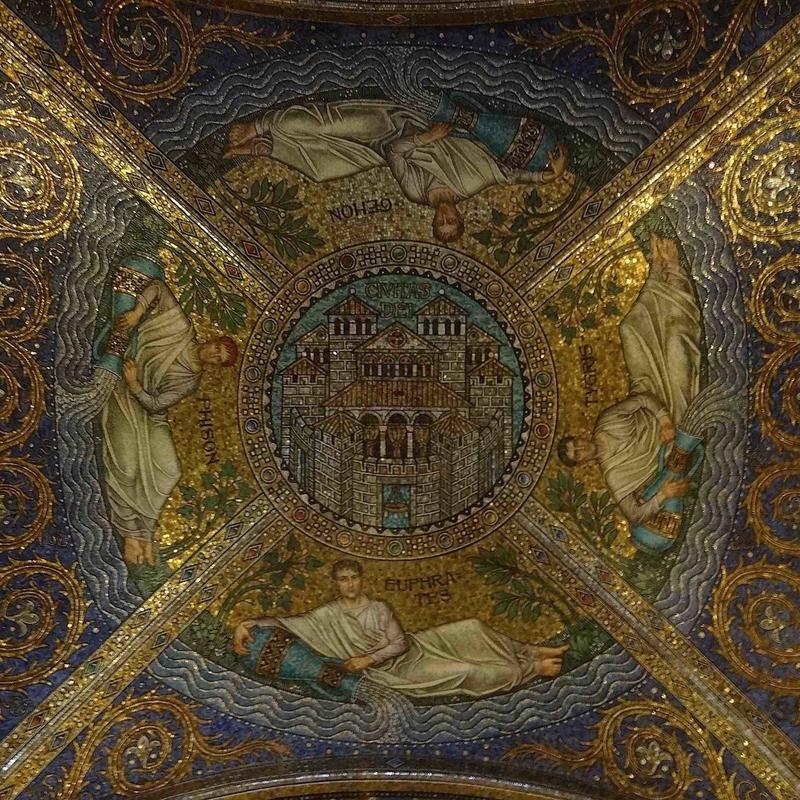
Both interiors draw on Biblical descriptions of the interior of the Temple of Solomon, as in 2 Kings 3:5-7:
‘And the greater house [the Temple] he [Solomon] ceiled with deal boards, and overlaid them with plates of fine gold throughout: and he graved in them palm trees, and like little chains interlaced with one another. He paved also the floor of the temple with most precious marble, of great beauty. And the gold of the plates with which he overlaid the house, and the beams thereof, and the posts, and the walls, and the doors was of the finest: and he graved cherubims on the walls.’
Charlemagne and the Umayyad Caliph Abd al-Malik were deliberately echoing the rich marble and mosaic work seen in early Christian and Byzantine churches in Rome, Constantinople and Jerusalem. This was a decorative language rooted in the Biblical precedent set by Solomon for works of great beauty and holiness. It was also now closely associated with ancient imperial Roman and Byzantine power. By appropriating this visual language, Carolingian and Islamic buildings could communicate a similar sense of sacred power and holy magnificence.
Charlemagne clearly wanted his palace buildings in Aachen to rival the medieval world’s most ancient and important Christian and imperial capitals. The chapel’s similarities with the basilica of San Vitale in Ravenna are not accidental: this was another former Roman imperial, Ostrogothic, Byzantine and Lombard capital city, which Charlemagne had visited multiple times.

The interior of San Vitale in Ravenna, showing marked similarities with the palace chapel at Aachen
The palatine chapel we see at Aachen today was heavily restored by Kaiser Wilhelm II in the nineteenth century, although the iconography of its decoration was carefully and closely copied. The famous Throne of Charlemagne still survives in the upper storey of the chapel. It again echoes the Biblical Throne of Solomon, and may incorporate spolia [repurposed stone] from the Holy Sepulchre in Jerusalem.
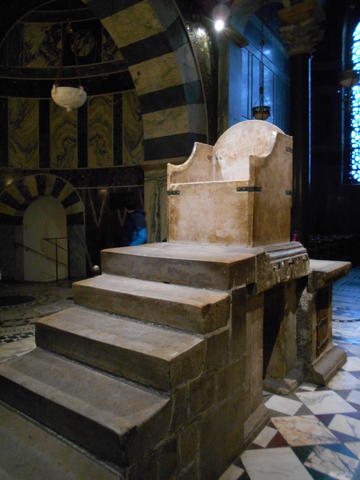
Read our next post to find out just what influence Charlemagne had on the court cultures of late medieval Europe….
In her final post in this series, Laura looks at the role of music in the images of the Ghent Altarpiece, where holy sounds seem just as important as holy sights. To read Laura's other work on the altarpiece, please see the preceding posts.
A full image of the Ghent Altarpiece which will allow you to zoom into the details can be found via Wikipedia by clicking here.
The churchmen seen in the lower register with their service books, joining in with the Mass in song, have been identified by art historian Elizabeth Dhanens as three contemporary popes, all wearing the jewelled papal tiara: Martin V (in profile nearest to the service book), the ‘antipope’ Alexander V, and Gregory XII. Whatever schisms have occurred on earth, all three have been admitted to the Kingdom of Heaven.

We can see musical notation in the service book in front of them, and it’s not the only glimpse of music in Ghent Altarpiece. In the upper levels, we see figures (usually identified as angels, although we cannot see any wings) singing and playing instruments.
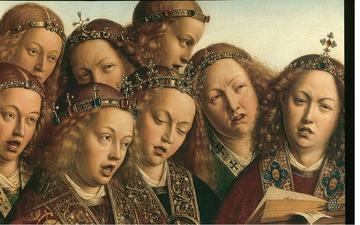
Frowning and focusing hard on their singing, the angels are clearly concentrating- perhaps to keep in time, as if they are singing elaborate, fashionable polyphonic music. The panel may again allude to the singing that accompanied the service of the Mass, as well as the eternal, unceasing praises of God sung by the heavenly choir described in Revelation 5: 9-13, ‘And they sung a new canticle…’. The angelic singers wear the clerical robes worn by deacons and subdeacons and are grouped around a pulpit with a carved image of St Michael the Archangel defeating Satan below. Referring to the events described in Revelation 12: 7-9, here is another allusion to the Last Judgement and the heavenly Paradise that awaits afterwards. Along the bottom of the pulpit is a carved border of fruits and vines, another reference to the blood of Christ and the wine of the Eucharist (John 15:1, ‘I am the true vine’). The tiles below them include images of the Lamb of God and the monograms of Jesus and Mary. Below the singers is an inscription: ‘Melos deo laus perhennis gratiarum actio’, which Elizabeth Dhanens translates as: ‘Songs of supplication, songs of praise, songs of thanksgiving’
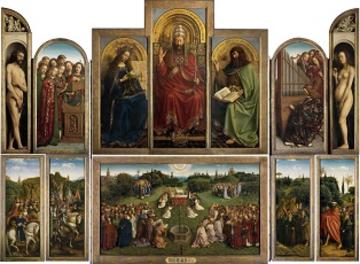
The angels gathered around the pipe-organ on the viewer’s right of the altarpiece, playing a harp and viol, are in the same (heavenly?) place, as we see the same tiles beneath their feet. And there is another inscription, this time a quote from Psalm 150:4, ‘Laudate eum in cordis et organi’, ‘Praise him with strings and organs’. Whether on earth watching the performance of the Mass or in heaven, flanking Christ, the Virgin and St John the Baptist, holy sights and holy sounds came together.
References:
Craig Harbison, Jan van Eyck: The Play of Realism (London, 1991)
Elizabeth Dhanens, Van Eyck: The Ghent Altarpiece (London, 1973)
Barbara Haggh, ‘The Mystic Lamb and the Golden Fleece: Impressions of the Ghent Altarpiece on Burgundian Music and Culture’, Revue belge de Musicologie / Belgisch Tijdschrift voor Muziekwetenschap 61 (2007): 5-59.
Blogs 09 2018 - 04 2019
In the second of her posts on the famous 'Ghent Altarpiece', Laura considers the imagery which reflects the Mass and elements of the lay devotional experience
The Ghent Altarpiece is made up of twenty-four panels. It is the largest and most complex (known and surviving) set of panel paintings made in the fifteenth-century Netherlands. No other painting by Jan van Eyck is known for certain to have been made for public display in a church. The visual programme of the altarpiece may have been devised by a theological adviser, perhaps the prior of St John’s, Olivier de Langhe, who was the author of a learned treatise on the Eucharist.
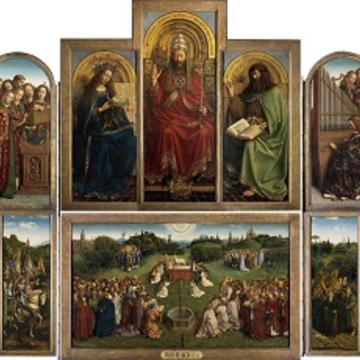
When the altarpiece is opened up, its upper register shows a deisis, a Byzantine artistic convention: Christ, the Virgin Mary and St John the Baptist are seen enthroned in heaven, flanked by singers and musicians. Adam and Eve stand at the outer edges, below two scenes from the lives of their sons, Cain and Abel. Below, we see a mystical vision of the Adoration of the Lamb of God (Agnus Dei). It is set in an unparalleled landscape depiction of the heavenly gardens of Paradise. The towers and spires of the New Jerusalem behind them are real and recognisable buildings: the tower of Utrecht Cathedral and the tower of St Nicholas’s Church in Ghent can be seen, for example.

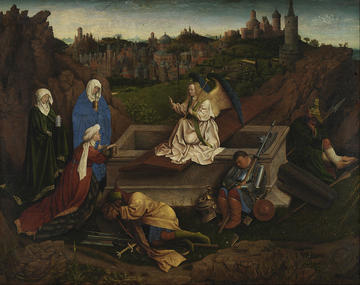
The lamb stands on an altar flanked by winged angels. The angels hold various instruments of the Passion or swing censers before the altar, just as a priest would do in the chapel itself when the Mass was being celebrated. Blood pours from the lamb’s breast into a golden chalice, set on the altar beside him. The vision of an altar, a chalice containing the blood of Christ and angels swinging censers all vividly recalls the service of the Mass. It’s worth remembering that in medieval times, the laity took communion in one kind only, taking the bread (the body of Christ) but not the wine (the blood of Christ). The blood of Christ was consumed by the eyes alone- and in the Ghent Altarpiece, there is a splendid banquet for the eyes to feast on.
‘And he showed me a river of water of life, clear as crystal, proceeding from the throne of God and the Lamb’, Revelation 22:1
The Fountain of Life (Revelation 22:1, ‘And he showed me a river of water of life, clear as crystal, proceeding from the throne of God and the Lamb’), another symbol of the Eucharist, has been placed in the foreground. Water sprays from it from six spigots, symbolising the other six sacraments of the Church. All these elements of the panel particularly emphasise the redemptive and healing powers of the Eucharist, able to absolve all sins and guarantee your entry to the Paradise we see in the altarpiece. In the Middle Ages, ordinary lay people usually received communion only once a year, at Easter. They might attend daily Masses (and in fact, this was very normal- a staple of parish social and business life), but only to watch and pray. The sight of the Mass, a sight amplified in the Ghent Altarpiece in a way that carefully communicates its theological meaning and power, was key to lay devotional experience of the Eucharist. The Eucharistic themes of the altarpiece are especially appropriate for a chapel intended to save the souls of Joos Vijd and his wife through daily celebration of the Mass.
Several groups of figures converge on the sacred altar: Old Testament patriarchs, prophets and pagan philosophers; apostles, popes and bishops; holy martyrs and confessors, hermits and pilgrims, knights and just judges. Lots of these figures can be identified by their attributes: Virgil holding a laurel wreath, St Barbara with the tower she was locked up in by her father.
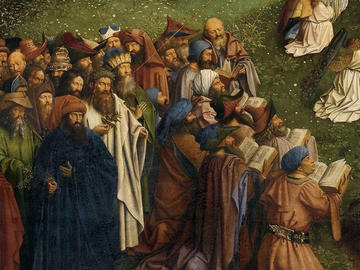
As you can see, lots of the heavenly ‘congregation’ are holding thick service books, as if they are also participating, like the angels, in the service of the Mass. When the Mass was celebrated each day in the chapel itself in Ghent, it would have been as if the clergy and any worshippers were ‘joining in’ with the eternal, heavenly Mass depicted in the lower register of the altarpiece.
You can even glimpse musical notation found on the pages of the service books. The sight of the Mass is important- but so is its sound…
Find out more about the role of music in the Ghent altarpiece in Laura's next post.
Laura stopped off in Ghent on her way to the recent 'Transnationalism at Court' event in Liège, and it was an ideal opportunity for some project-related sightseeing. In this series of blog posts, Laura considers the famous 'Ghent altarpiece', from Flemish artist Jan van Eyck.
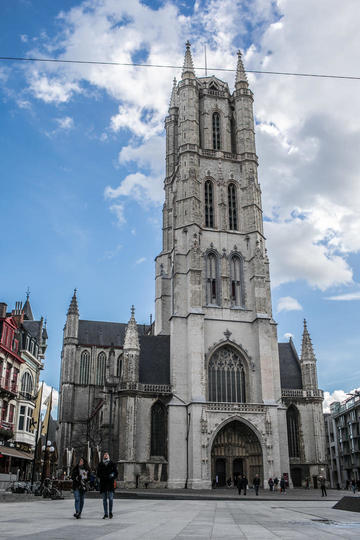
St Bavo's Cathedral ©Stad Gent - Dienst Toerisme
The recent MALMECC workshop in Liège provided an opportunity for me to follow in the footsteps of Philippa of Hainault: by visiting Ghent, where on 6th March 1340, Philippa gave birth to her third son, John of Gaunt, later duke of Lancaster and father of Henry IV of England. ‘Gaunt’ is a Middle English corruption of Ghent.
I think it’s possible that Philippa named her son after the patron saint of the city of Ghent, St John the Baptist. The city’s oldest parish church was dedicated to St John the Baptist. Rededicated around 1540, today it is better known as St Bavo’s Cathedral.
St Bavo’s is the home of one of the most important works of art in late medieval Europe, the 11ft by 15ft Ghent Altarpiece (c.1432).

Albrecht Durer visited it on a journey to the Netherlands in 1521, writing in his diary that it was: ‘a most precious painting, full of thought’ (‘ein über kostlich hoch verständig gemähl’). Originally commissioned sometime before 1426 by a wealthy member of the urban patriciate in Ghent, Joos Vijd, from local artist Hubert van Eyck, the work was completed in 1432 by his more famous brother, the renowned Flemish artist Jan van Eyck. The work was made for the chapel personally founded by Joos Vijd in 1435 to celebrate a daily Mass for the soul of himself and his wife, Elisabeth Borluut. They are depicted on the sides of the altarpiece when it is closed, below an image of the Annunciation to the Virgin and grisaille (grey) images of St John the Baptist and St John the Evangelist. At the very top of the closed panels are sibyls and prophets.
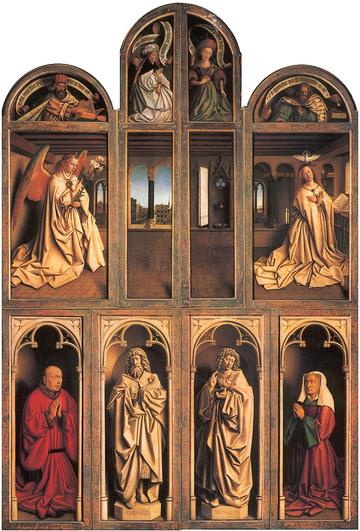
Joos Vijd (bottom L) and his wife Elisabeth Borluut ( bottom R)
Both patron and painter had strong connections to the courts of the Low Countries. Joos Vijd was from a minor noble family. Jan van Eyck worked for both John of Bavaria, count of Holland and Philip the Good, duke of Burgundy. In fact, he became a trusted courtier as well as court painter for Philip the Good, attaining the title of ‘varlet de chambre’. In 1426, Jan van Eyck travelled on pilgrimage to Jerusalem on behalf of the duke. His first-hand knowledge of the city accounts for the accurate depiction of the skyline of Jerusalem in a painting sometimes attributed to Jan, his workshop, or his brother Hubert. This is the c. 1410-1426 Three Marys at the Tomb. Notice the circular form of the Dome of the Rock in the centre of the painting: a building which still dominates the Jerusalem skyline, especially if you’re looking across at the Old City from the Mount of Olives
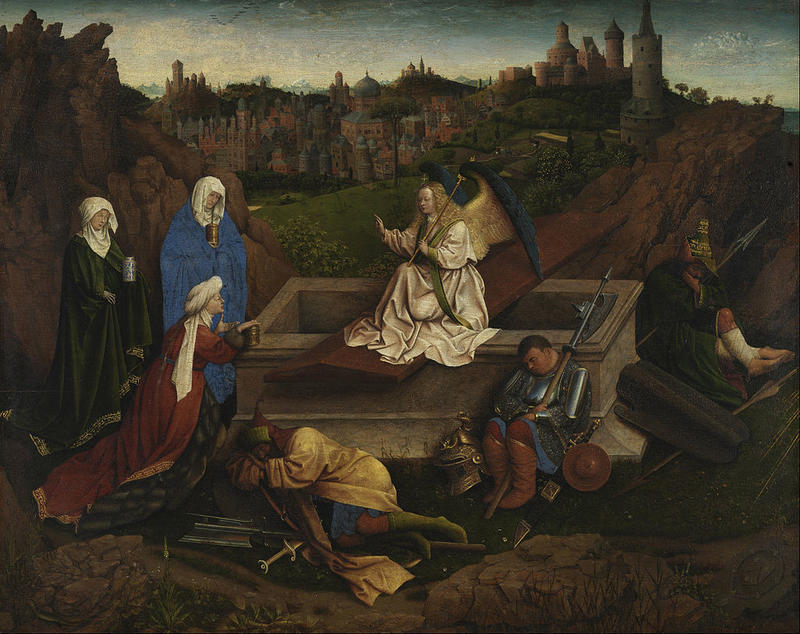
The Three Marys at the Tomb, attributed to Hubert can Eyck, c.1410-20. Museum Boijmans Van Beuningen

Dome of the rock
Jan made a ‘secret and far trip’ on Philip’s behalf at the same time, perhaps visiting cities in the Ottoman Empire. In 1428, he visited England and Spain on his way to Portugal, to help negotiate Philip’s third marriage to the Infanta Isabella of Portugal. Jan van Eyck painted two portraits of the princess to send back to Burgundy, and was again able to go on pilgrimage, this time to Santiago de Compostela.

Unidentified artist, Philip the Good and Isabella of Portugal
But amongst all these courtly travels and delicate diplomatic missions, Jan van Eyck found the time to complete the Ghent Altarpiece by 1432…
Thanks for reading - we'll have more of Laura's thoughts on the altarpiece next week!
References:
Craig Harbison, Jan van Eyck: The Play of Realism (London, 1991)
Elizabeth Dhanens, Van Eyck: The Ghent Altarpiece (London, 1973)
Barbara Haggh, ‘The Mystic Lamb and the Golden Fleece: Impressions of the Ghent Altarpiece on Burgundian Music and Culture’, Revue belge de Musicologie / Belgisch Tijdschrift voor Muziekwetenschap 61 (2007): 5-59.
Researcher Christophe Masson reflects on the latest MALMECC study day, an academic tour of Europe in search of the cultural influences of papal Avignon...
Papal Avignon lay at the centre of the third MALMECC study day (8th February 2019). As the papacy was possibly the Western European power most eager to assert its world sovereignty, Avignon, where the pope resided from 1309 to 1376 (and even to 1403 if we consider period of the Great Western Schism), was something of a centre of the world. It is no surprise, then, that some of the greatest minds of the Middle Ages lived and worked there, (Petrarch being just one example). Nevertheless, the objective of the study day was to go further than a catalogue of great names and to look into the role Avignon played in the diffusion of culture.
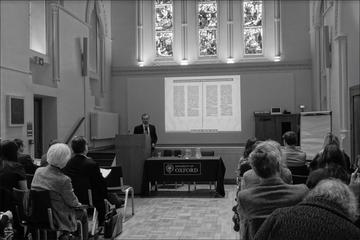
It all started during the kick-off event, a lecture given by Étienne Anheim (EHESS) for the All Souls Late Medieval and Renaissance Music seminar (7th February 2019), hosted by Margaret Bent. The comparison between the Parisian “Sainte Chapelle” and the Avignon papal palace chapel showed how an appointment at the latter, despite the fact that it was built later, established itself as the ultimate honour for singers, offering them high ecclesiastical position and a shared cultural identity.
The study day in itself started, after the opening remarks delivered by MALMECC PI Karl Kügle, with a second presentation by Étienne Anheim. Studying the social and cultural networks existing between Avignon and Italy, mostly around 1350, he emphasized the role played by Italian cardinals in offering a market to the artists coming from the Peninsula. This was ideally complemented by a presentation from Oxford’s Sarah Griffin on her work on visual diagrams realized by intellectuals (including Henricus del Carretto, latter followed by the more well-known as Opicinus de Canistris) in order to understand the world. Far from being pointless intellectual exercises, they were produced in a context of research for knowledge. What is more, Pope John XXII initially gathered these minds within the Apostolic Penitentiary (i.e. the tribunal responsible of dealing with matters such as weddings and excommunications), in order to provide them with a perpetually stimulating intellectual atmosphere.

The second session of the day led participants to regions less spontaneously associated with the cultural activities of Avignon. James Hillson (Cambridge) underlined, nonetheless, the active presence of Englishmen in Avignon up until the 1340s, a period during which they appeared to be of sufficient renown to contribute to the tombs of Pope John XXII and cardinal Arnaut de Via. The Holy Roman Empire’s contribution to the culture of Avignon was investigated by MALMECC postdoc David Murray through the case of the Salzburg archbishop Pilgrim von Puchheim. The connections he maintained with major figures including the cardinal-filled Aigrefeuille family, even after he left Avignon, shows how people not only brought their own backgrounds to Avignon but also left the city with new views and aesthetics they then tried, and often managed, to implement in their home regions.
We turned back to musical matters with Karl Kügle, who presented what is currently known about music performed in Avignon. Beyond the list of manuscripts, he highlighted the idea that popes were not to be seen as the only patrons of music. The fact that evidence is missing about their patronage or musical activities during certain periods of time should lead scholars to have a closer look at cardinals. Perhaps something is hiding there which we don’t yet have any idea of. The morning ended with a presentation by Maria Sofia Lannutti (Florence), Antonio Calvia (Pavia), and Chiara Martignano (Florence), of a stimulating new ERC funded project, European Ars Nova: Multilingual Poetry and Polyphonic Song in the Late Middle Ages (Università degli Studi di Firenze). It aims to study the corpus of all the poetic texts performed by Ars Nova musicians between the fourteenth and the early fifteenth centures through a catalogue of extant manuscripts, scientific editions of texts, and a repertory of poetic and musical structures.
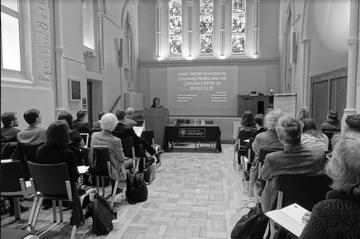
After a well-deserved lunch, participants turned back to late medieval scholars. Philipp Nothaft (Oxford) emphasized the scarcity of evidence for any “hard science” (to use a modern label) patronage between the 1270s and the pontificate of Clement VI (1342-1352). He convincingly argued that the latter was more an exception than the norm, the other popes paying less attention to these matters. From a musical perspective, Karen Cook (Hartford) followed the trail of a late fourteenth century music theorist, Johannes Pipardi, who interestingly appears to have been a cardinal’s protégé, and not a pope’s man. This echoed the question raised earlier by Karl Kügle.
Stefano Cingolani (Barcelona) had the attendees going for a last trip, this time to Aragon. He showed the clear musical dependence of the Catalan kings vis à vis Avignon, and the influence the pope’s chapel had on the king’s musical entourage.
The day was closed by MALMECC postdoc Christophe Masson’s remarks about the cultural importance of the 1378 Great Western Schism, during which two popes, one in Rome, one in Avignon, faced each other. He proposed a working hypothesis that a transnationalist model was fostered in Avignon. This could have made the popes and cardinals willing to continuously attract artists from all over Europe, notwithstanding the fact that some may have come from regions following the Roman pope, rather than that of Avignon.
The day proved extremely thought-provoking, and the discussions went on late after the end of each session. The MALMECC team is thus very grateful to all the speakers and attendees for their invaluable contributions. We now look forward our next event, the Transnationalism at Court colloquium (University of Liège, 21st-22nd March 2019). More detail on this can be found by clicking here.
Pictures kindly provided by Chiara Martignano
As well as researching and writing, a large part of academic work is presenting your findings. Christophe's work is featured in the recently published conference proceeding, La Paix de Fexhe (1316) et les révoltes dans la Principauté de Liège et dans les Pays-Bas méridionaux. Here, he presents a post which looks at life in the courts of the prince-bishops of Liège. drawing on some of the themes of his paper.
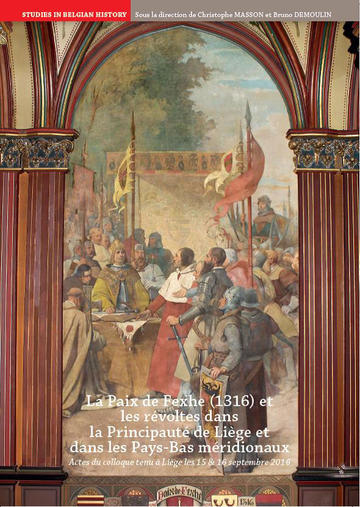
In the early fourteenth century, the principality of Liège experienced numerous dramatic events. Sudden deaths of its prince-bishops, violent political uprisings, and familial wars occurred too frequently to let the country be at peace. Amongst all of this, the Peace of Fexhe (18 June 1316), signed in a small village located some kilometres away from the capital, was considered by nineteenth-century scholars—and some modern journalists, history enthusiasts, and politicians—as the time where the prince’s monocratic power was put to an end and replaced by democracy. Which, as everyone knows, was already present—and perhaps allegedly born, (sorry about that, Athens)—in the late Middle Ages…
The reality is obviously far more complex. This text was probably, before anything else, a truce between exhausted parties. In fact, between 1315 and 1317 a dramatic famine swept across almost all Europe that left people barely able to do anything other than strive to find food, or to make decent business. Nonetheless, the truce gives us the opportunity of uncovering the political tensions of the day, as numerous political problems appear in the text. It is also a chance to meet the people who mattered in Liège political life, and the ones who tried—and sometimes succeeded—in joining them.
Urban aristocrats tended to aggregate themselves to nobility, thus copying some of their habits: listening to or reading romances, wearing coats of arms, walking with a sword at their side…
As a principality, Liège housed a court, organized around its prince-bishop. A subject of the emperor, but at this period increasingly close to the king of France, the prince-bishop had to deal with the canons of his cathedral, (Saint-Lambert), who challenged his authority as ruler of the land; with the nobility; with the urban aristocracy; and with professional guilds. He organized his court around two cores. The first one gathered his relatives—brothers, nephews, and cousins—and local allies whom he entrusted with military, judicial, administrative, or diplomatic duties. The second one was composed of the canons of Saint-Lambert, who also acted as his officers. Mostly coming from the upper part of society, they were raised amongst knights or high-profile merchants, and so brought with them an education, that relatively matched, but of course on a lower level, the one enjoyed by their princes.
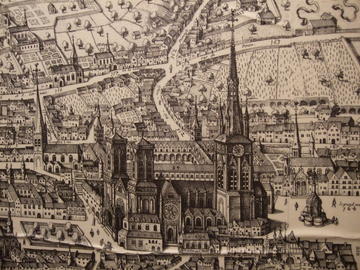
A 16thC engraving of the cathedral of Saint Lambert
War and prowess were essential in this culture, which saw princes fighting on horseback or on foot amongst their people, even using the officially-forbidden-by-the-pope crossbow to shoot some of them down! The bishop Adolphe de La Marck, who signed the Peace of Fexhe, was even compared to Hector by a contemporary chronicler! Urban aristocrats tended to aggregate themselves to nobility, thus copying some of their habits: listening to or reading romances, wearing coats of arms, walking with a sword at their side… Nonetheless, we strangely do not find evidence of jousts or tournaments held in the principality. This does not mean that the local nobility despised these activities. After all, they took part in the ones organized nearby. Maybe the ecclesiastic identity of prince-bishops prevented them from organizing such events… But it did not prevent them from shaping an original court culture, mixing aristocratic and ecclesiastical values, which was more or less imitated by everyone who aspired to an official position. Because to join the people that mattered, the best way was still to act like them before becoming one of them…
As part of his work on the Peace of Fexhe, Christophe even wrote the text for a comic produced by the cultural department of the province of Liège! More information on 'La Sang de la Paix' can be found here
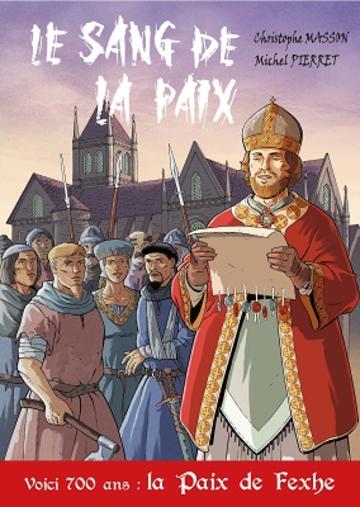
What do you leave out when you only have 30 seconds to explain your research? That was the challenge facing Laura and our other researchers recently in the context of our upcoming project videos. In this post, Laura explains some of her more painful editorial decisions.
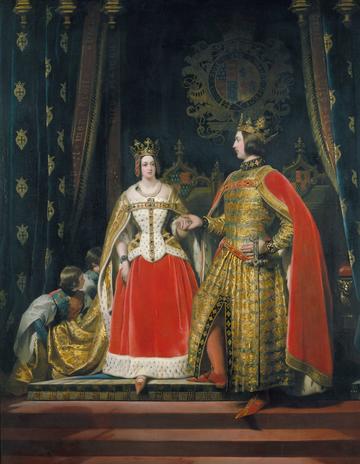
Queen Victoria and Prince Albert as Edward III and Philippa of Hainault at a costume ball of 1842 (RCIN 404540)
Philippa of Hainault and Edward III were married at York Minster in January 1328. They went on to enjoy one of the happiest royal marriages in medieval Europe. Yet their union originated as a matter of political convenience, even desperation. While estranged from her husband, Edward II, and seeking refuge on the continent, the current queen of England, Isabella of France, traded her son’s marriage in return for military aid and support from Philippa’s father, Count William the Good of Hainault, Holland and Zeeland.
The queen’s coup was a triumphant success: Edward II was deposed and imprisoned (conveniently dying nine months later) and her son was crowned as Edward III on February 1327. Philippa of Hainault arrived in England to marry the new king in December 1327, barely a week after the funeral of her murdered father-in-law, Edward II. Aged anywhere between ten and fifteen years old, she found herself entering a political and family quagmire. Her new husband turned out to be a powerless figurehead, while real power in the regency government remained in the hands of Philippa’s mother-in-law, Isabella of France, and her possible paramour, Roger Mortimer. On the very day of Edward’s coronation, Isabella awarded herself a truly enormous dower: so great, one chronicler sniped, that barely one third of the realm remained for her son.
The coronation of Philippa, from the chronicles of Jean Friossart
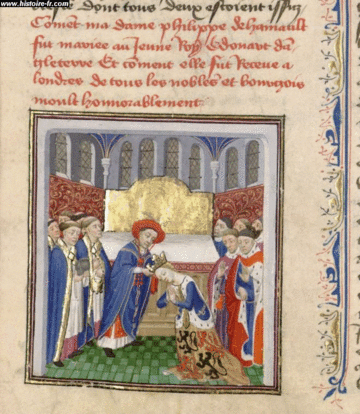
Philippa’s official, public role as queen turned out to be uniquely diminished. The royal marriage was celebrated with pomp and magnificence, but no coronation followed until 1330. Nor did Philippa receive any dower. In May 1328, as the regency government negotiated an unpopular truce with the Scots, the king enrolled on the patent rolls a public promise ‘to assign lands for the dowry of Queen Philippa within a year’. Almost a year later, in April 1329, Philippa was granted an annuity of a thousand marks a year towards the expenses of her chamber, ‘until some provision be made for her estate’, the government records note rather desperately. The problem, of course, was that Edward III could do little about his mother’s continued monopoly on the power, position and resources of the English queen.
This is the context in which I am exploring one of the manuscripts owned by Philippa. But it is difficult to try and outline such a complex web of political problems and family dysfunction in half a minute’s worth of time. Hard choices had to be made, about what to say and what to leave out. And this meant glossing over some of those all-important, pedantic academic details.
an important dimension of the MALMECC project is how we are examining kingdoms that didn’t become nation states in their own right, and so thinking about the court from a transnational perspective.
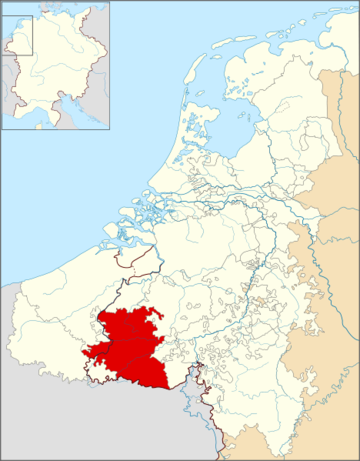
The territory of Hainault in 1350
One problem is explaining where Philippa is actually from. Her father’s territories covered parts of what is today northern France, Belgium and the Netherlands. Its key capital cities were Valenciennes (today in France) and Mons (today in Belgium). I ended up saying that Philippa was from ‘the Low Countries’: it’s just about accurate, but it doesn’t really explain much. Yet an important dimension of the MALMECC project is how we are examining kingdoms that didn’t become nation states in their own right, and so thinking about the court from a transnational perspective.
Another difficulty was explaining Philippa’s isolation in her early years in England. With only thirty seconds, it was impossible to start discussing her expenses and landed estate (or lack thereof). So I had to use a shortcut. As a way of communicating Philippa’s difficulties, I tried to outline her predicament as follows: ‘You’re on your own. You don’t speak English. And you turn out to have the mother-in-law from hell.’ We can all relate to being in a new and difficult family environment, perhaps with hostile relatives. And we can also understand how isolated and lonely it is to live somewhere where you don’t speak the language well.
in the difficult years 1327-1330, learning English would have been the least of Philippa’s concerns, living as she did in a French-speaking court
But while my script might communicate Philippa’s situation in thirty seconds, it is also simplifying more complex medieval realities. Philippa certainly didn’t speak any English when she first arrived. Yet in early fourteenth-century England, this would not have mattered in the slightest! Throughout much of English society, French was still a widely used vernacular. For the royal family and aristocracy, French was spoken as a matter of course: it was the lingua franca (pun intended) of elite life, especially for the laity. Although it’s likely that Philippa did pick up some English during her long life in the kingdom, we don’t actually know if she ever learned the language.
So in the difficult years 1327-1330, learning English would have been the least of Philippa’s concerns, living as she did in a French-speaking court. Yet my video (link on the publications page) suggests that Philippa’s lack of English was a real problem. It’s an unfortunate compromise, but I hope the wider problem, that of the early challenges of Philippa’s married life, still comes across, especially to a non-academic audience.
In the second of her posts on modern views of the Middle Ages, Laura considers how the work of the engaging historian is a careful balancing act between over-simplification and mind-boggling detail. Does a simplistic view of the Middle Ages hide interesting facts, and darker truths, from a non-specialist audience?
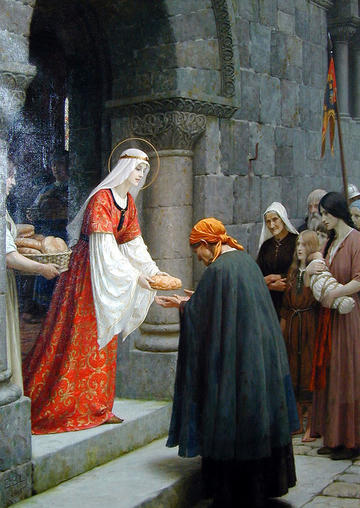
Edmund Leighton, 'The Charity of St. Elizabeth of Hungary', 1895, Collection of Fred and Sherry Ross
In contrast to all the complications of modern life, the Middle Ages is often seen as a return to nature and the land: a healthy outdoor life lived out in the fresh air, rather than sitting in an office all day staring at a computer screen. Medieval peasants did indeed live and farm in a completely ‘organic’, ‘local’, ‘artisan’ and ‘sustainable’ way. But they also regularly starved to death.
Few of us really dream of a world without modern medical care or pain relief. Other visions of the primal simplicity of the Middle Ages are even darker: an all-white world ruled only by rich men, in which women and poor people know their place, Jews are a despised, regularly massacred minority and Muslims feature only as ‘infidels’ to be swept under the trampling hooves of the crusader. Summarised as crudely as this, such an extremist and simplistic view of medieval society seems laughable. But it’s surprising how often imagined medieval pasts have been used to support political violence and hate speech. The famous battle cry used by the knights fighting in the First Crusade, ‘Deus le volt’ [God wills it], for example, has been used as racist graffiti.
Much of academic research is about fiddly details and tiny nuances: a re-dating of a window here, a re-reading of a source there, an extended and deeply dull argument (perhaps across decades) about exactly what happened to the manorial economy of Suffolk after the Black Death.

Edmund Leighton, 'The King and the Beggar-Maid', 1898, Collection of Fred and Sherry Ross.
So part of academic public engagement is pointing out that things were more complicated than they first seem. Just like society today, the medieval world was rich in its contradictions, complexities and paradoxes. Yet it can be difficult. Much of academic research is about fiddly details and tiny nuances: a re-dating of a window here, a re-reading of a source there, an extended and deeply dull argument (perhaps across decades) about exactly what happened to the manorial economy of Suffolk after the Black Death. It can be boring and incomprehensible to a non-specialist audience, even if the result is that our understanding of say, life in Suffolk in the later fourteen century is completely transformed by the end of this long, slow process. The romantic dream-world remains far more fun!
So the challenge when making a 30-second video is to summarise our work without all those pedantic details that academics spend most of their time picking over. Hard choices have to be made about what to leave out and what to put in, as in my recent experience of making a video about Philippa of Hainault’s early years in England. More about this in my next post!
In the first of a new series of posts on the perception and reality of the Middle Ages, Laura announces a public engagement activity and considers why the imagery of the medieval era has been so often used to glorify war.
The MALMECC team are currently in the process of making videos about their individual research projects. We have 30 seconds to summarise our work!
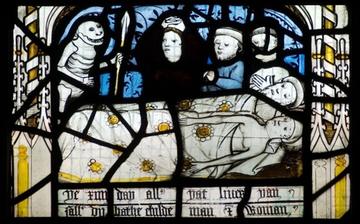
All Saints North Street, York
Public impact and engagement is an important aspect of academic life these days. Like our website, blog and twitter account, creating these videos is another way for us to share what we are doing with a wider audience. We would like it if members of the public understand how and why we are trying to rethink late medieval European court culture, and (hopefully), we can communicate why it matters. The Middle Ages are often dismissed as a ‘Dark Ages’. Sometimes, people imagine a world of oppressed peasants living in misery: forced by an all-powerful Church into rigid social conformity and macabre superstitions, rarely leaving their villages and regularly dying of the plague. This is a world entirely without books, music, dance and culture. So it’s easy for our project to show some of the ways that this was not the case.
More complex and difficult to contest is a more positive vision of the medieval past that comes closer to some of the cultural events and ideas that our project is exploring, but is still a very partial view of the Middle Ages. This is the romantic vision especially beloved by the Victorians, of heroic knights errant jousting in tournaments, winning fame and honour from admiring maidens wearing wimples, and enjoying splendid banquets afterwards.
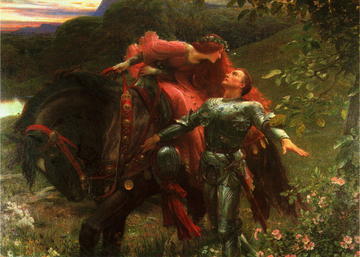
Painting by Sir Frank Dicksee, illustrating Keats’ poem ‘La Belle Dame sans Merci’ (Date unknown)
Lots of these ‘medievalist’ dreams can be understood as visions of return to a simpler age, both for good or bad. In Oxford as elsewhere across the United Kingdom and Commonwealth, we have just commemorated the 100th anniversary of Armistice Day. In both Britain and Germany after World War One, many war memorials used medieval imagery to express the heroism and bravery of the soldiers who died during the Great War. In this example from Leeds by Henry Charles Fehr, the British ‘Tommy’ is shown in the guise of St George slaying the dragon. In Germany, the octagonal form of the now-destroyed Tannenberg Memorial echoed the Castel del Monte built in Apulia by the Holy Roman Emperor Frederick II in the 1240s, and the castles of the Teutonic Knights.
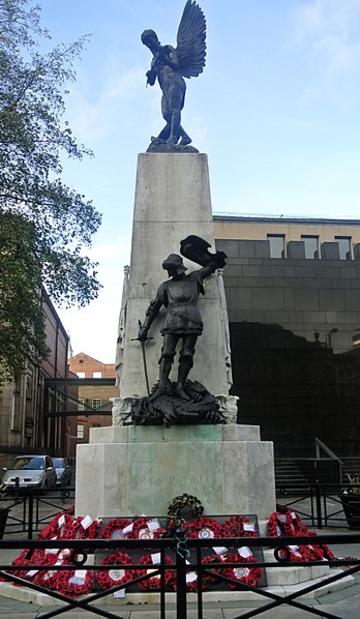
Leeds war memorial
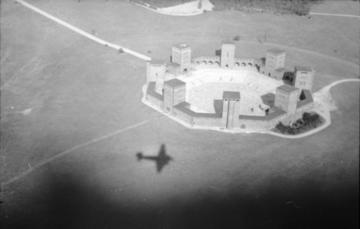
Tannenberg Memorial, Germany
Soldiers were explicitly compared to crusading knights, and legends such as that of the ‘Angels of Mons’ emerged, where phantom bowmen from the battle of Agincourt were supposedly seen coming to the aid of British soldiers at the Battle of Mons in August 1914. The destruction caused to medieval cathedrals such as Reims underscored the horror and devastation of modern, machine-made warfare, in contrast to the seemingly timeless ideals and moral values of the Middle Ages.
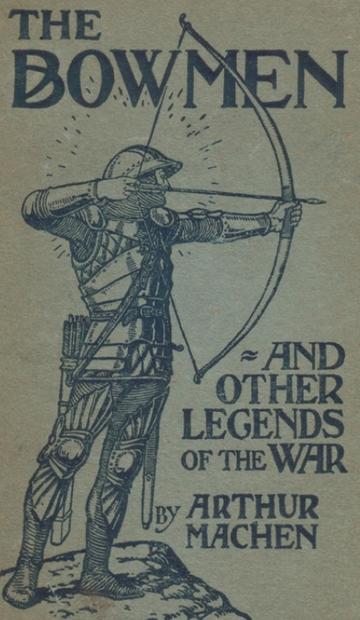
"The Bowmen" - A possible origin of the legend of the Angels of Mons
Surveying the carnage of the trenches and the economic hardship that followed in the post-war years, it is not surprising that people yearned for a return to a supposedly simpler, kinder world, of fair ladies and gallant, chivalric knights.
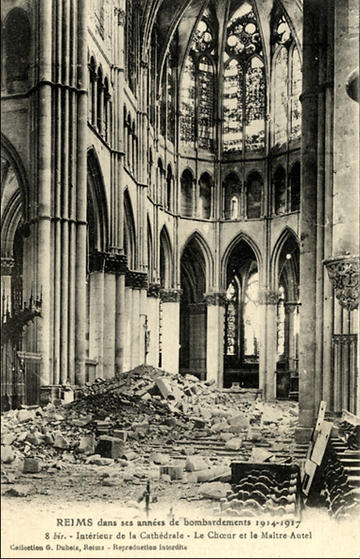
If you would like to find out more about the role which ideas of medieval life played in memorialising the 1914-18 war, please see Stefan Goebel, The Great War and Medieval Memory. War, Remembrance and Medievalism in Britain and Germany, 1914-1940 (Cambridge University Press, 2007)
Header image: Stained glass from the parish church of All Saints, North Street, York
The second study day hosted by the MALMECC project (2nd November 2018) was devoted to the phenomenon of translingualism, in our case how phenomena—be they concepts like courtliness, musical or literary forms, or for that matter individuals themselves—pass between linguistic zones. Exchanges across linguistic frontiers and the effect that the knowledge of multiple languages can have on someone’s cultural production are topics of central importance to the work of the MALMECC team. As such, we were delighted to be able to discuss these and related questions with a range of expert interlocutors representing the fields of medieval music, art, and literature in German, French, Dutch, English, Occitan, Catalan, Welsh and, of course, Latin.
After words of welcome from MALMECC’s Principal Investigator, Karl Kügle, Frank Willaert opened proceedings with a rich and wide-ranging paper entitled ‘Hovedauncis and rés d’Alemaigne’. It took as its starting point Machaut’s knowledge of the German-language song repertory of the thirteenth century, crystalized in his mention of a rés d’Alemaigne on which he claimed to have based the ballade ‘N’es qu’on porroit’ in Le Voir Dit. From there, Prof. Willaert traced the spread of Germanic songs, music, and musicians throughout later medieval Europe. He covered not only the massive demand for German wind and brass instrumentalists—Philip the Bold, Duke of Burgundy and Gaston Fébus both retained a number of them, while Wenceslas IV, King of the Romans loaned his German ‘King of the Minstrels’ to favoured servants—but also the spread of songs of Low German origin, principally the virelais-ballade along the Rhein. From the 1380s, there emerged a trend for pieces labelled ‘hovedaunce’ or ‘hovedans’ in both Low German sources such as the Hague songbook and also in the writing of English authors Chaucer and Gower, the first of whom may have come into contact with these pieces via the Rhenish musicians of his patron John of Gaunt. Prof. Willaert’s paper demonstrated vividly the wide horizons of the medieval court, as well as the benefits of comparative study on the basis of medieval, not modern, geographies both in terms of linguistic areas and the cultural spheres which did not necessarily overlap.
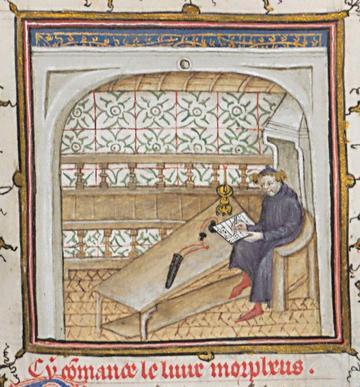
Machaut writing the Morpheus, with which he says he sent Ballade 33 to Toute Belle.
[Paris, Bibliothèque nationale de France, ms. fonds fr. 9221, f. 189r (detail)]
MALMECC’s own Karl Kügle, in his paper, ‘A song about the Porridge King and Machaut’s B33 re-visited’, took the lead from Prof. Willaert’s paper in pursuing the topic of Germanic influences on Machaut. In it he pursued a possible source for Ballade 33 in Le Voir Dit, namely the song ‘Der kuninc Rudolp’ by the German Sangspruchdichter known as ‘Der Unverzagte’ [‘The Unrelenting’] about the Habsburg duke Rudolf I. This German piece satirizes the infant duke, a contender for the imperial throne, and therefore an enemy of Machaut’s Luxmburg patron, the blind King John of Bohemia. Kügle demonstrated in detail how the peculiar compositional practice that lies behind the French piece can be traced back to the extreme melodic economy of the German Spruch, indicating the exciting possibility that Machaut, as well as his recognised knowledge of the French trouvère repertory, was also acquainted with at least some song in German. Conversation after the paper circled around the nature of artistic influence and parody, as well as poets’ claims to novelty in this context.
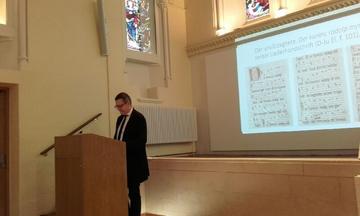
David Murray, post-doc on the MALMECC team, focussed on two aspects of translingual transfer in the corpus of the anonymous composer the Monk of Salzburg. First, the adoption of the melody of the French chace ‘Umblemens vos pri merchi’ for his three-part canon ‘Iu, ich jag’ bears witness to the years spent by the Monk’s patron, Archbishop Pilgrim von Puchheim, at the Papal court in Avignon. The German song itself later became the model for a Latin song praising the Virgin Mary. In the second half of his paper, Murray proposed a new social context for the adoption of the virelai-ballade form at the archiepiscopal court of Salzburg, long thought of as evidence of the influence of Machaut via the connections between Salzburg and Prague, where the French composer spent more than a decade as secretary to King John of Bohemia. Instead, he suggested that the form enjoyed particular prominence in the circle around Leopold III of Habsburg, a close political partner of Archbishop Pilgrim. Discussion of this paper focused on the nature of the exchanges between the sacred and the profane realms and the value of poetic and musical form (including the relative status of polyphony and monophony in corpora that have both) in the transmission of cultural goods.
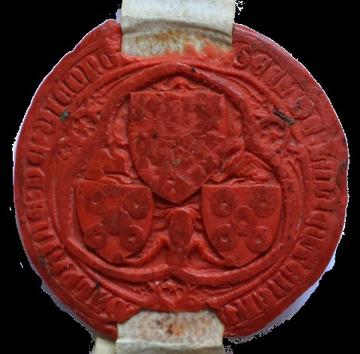
Seal of Pilgrim von Puecheim, from Salzburg, Archiv des Stiftes St Peter, no 467
In the last of her posts on the Priory Church of St Mary, Abergavenny, Laura considers he Tree of Jesse, a unique surviving monumental sculpture.
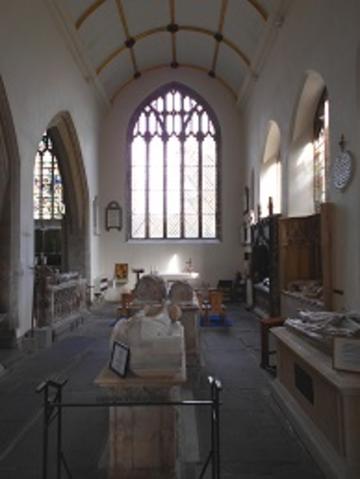
© South Wales Argus
The images of saints, apostles and martyrs on the Herbert tombs at Abergavenny are not the only rare survivals in the church. The Abergavenny Tree of Jesse is a unique surviving monumental sculpture. Many, if not the majority, of the devotional images inside and outside British churches in the Middle Ages were carved in wood. Almost all have since been destroyed.
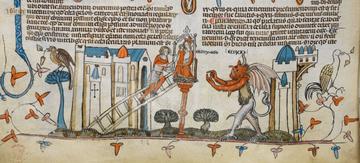
Smithfield Decretals f.209v (British Library Royal MS 10 E IV, f.209v)
So what was the Tree depicting?
Jesse was the father of King David, a key figure in the Bible and an ancestor of Christ. Medieval psalters often included an image of the lineage of Christ to mark psalm 1, ‘Blessed is the man’. It would take the form of a large and leafy tree. Jesse would be shown lying at the bottom, forming the ‘root’ of Christ’s human ancestry. David would be prominently included, often playing or tuning his harp.
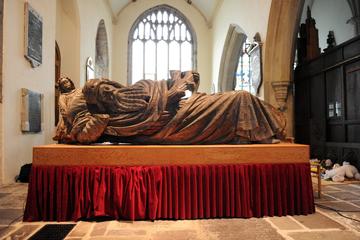
Tree of Jesse, in The Winchester Psalter
Visually tracing the lineage of the royal House of David, the image was redolent of ancestral authority- not just the authority of Christ and his teachings, but of the psalms themselves. Found in the Old Testament, the psalms were thought to have been written by King David. They were also believed to prophecy the coming of Christ. Lines such as verse 19 of the ‘Crucifixion’ psalm 21: ‘They parted my garments amongst them; and upon my vesture they cast lots’ were thought to have foretold the events of the Crucifixion, as when the soldiers cast lots for Christ’s clothes. Christ himself also quoted from psalm 21, reciting verse 2, ‘my God, why hast thou forsaken me?’ in his last moments.
The c.1150 Winchester Psalter in the British Library (Cotton MS Nero C IV) shows Jesse lying at the foot of the page on f. 9r. The figures of King David, the Virgin and Christ form the tree trunk sprouting up from Jesse’s ‘root’. At the very top of the tree, above the head of Christ, is the dove of the Holy Spirit. The Abergavenny Tree of Jesse dates from centuries later, but we can see the same trunk pushing up from his chest, gracefully curving up from the folds of his robes.
The sheer scale of the figure of Jesse gives some idea of how large the completed sculpture would have been- probably reaching to the roof of the priory church. Originally painted and gilded, it would have been an awe-inspiring sight, emphasising the majesty of Christ and the greatness of his lineage. Courtly aristocrats, with their own love of ancestry, dynasty and lineage, may well have been happy to bow down before it.
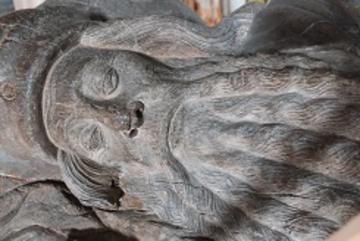
In this post, Laura steps slightly out of the MALMECC time period to write about Lady Anne Clifford and the 'Great Picture', an important work of female patronage now housed at the Abbot Hall Art Gallery and Museum, Kendal, Cumbria
From 16th-18th July, project member Laura Slater attended the conference: Lady Anne Clifford: Engagements in Culture at the Abbot Hall Art Gallery and Museum, Kendal, Cumbria. The gallery is home to an important work of female cultural patronage: the ‘Great Picture’ commissioned by Lady Anne Clifford around 1646, perhaps from the Flemish artist Jan van Belcamp.

Attributed to Jan van Belcamp, The Great Picture Triptych (1646), Abbot Hall Art Gallery
Lady Anne Clifford was one of the most formidable women in seventeenth-century England. She was the only child of George Clifford, third earl of Cumberland, a leading light of the Elizabethan court and an intrepid privateer who made numerous expeditions to the Azores. Much of his time was spent in the traditional courtly pursuits of jousting, gambling, horse racing and womanising, leading to the loss of much of his fortune. He owned great estates in Yorkshire and Cumbria. One of his fellow-courtiers complained that he was: ‘the rudest Earll by reson of his northerly bringen up’.
When he died in 1605, Anne was fifteen. She discovered that her father had disinherited her, leaving all his wealth and property to her uncle, his brother. Supported by her mother, Lady Margaret, Anne embarked on a mammoth legal fight to regain what she saw as her rightful inheritance. She married twice, first to Richard Sackville, third earl of Dorset and second to Philip Herbert, fourth earl of Pembroke. Both marriages were unhappy. Anne spent much time at court as a young woman, waiting on James I’s queen, Anne of Denmark and taking part in courtly masques. She spent the Civil War at Baynard’s Castle in London, one of the properties of her estranged second husband. In 1643, the death of her uncle’s heir meant that Anne’s father’s lands finally reverted back to his daughter. It wasn’t until 1649, when the Civil War ended, that Anne was finally able to travel north to take possession of her inheritance. She never set foot in the south again.
"the Great Picture is an emphatic statement of her great learning and intellectual interests."
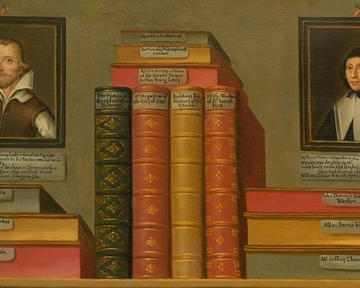
A detail of books from the 'Great Picture'
Two versions of the Great Picture were made, to hang in the Great Halls of Anne’s castles at Appleby and Skipton (the Skipton version was probably destroyed in the nineteenth century). The Picture takes the form of a triptych. On the left-hand panel, we see Anne at the age of fifteen, when she was disinherited. She is surrounded by the accomplishments of her girlhood and portraits of her childhood tutor, Samuel Daniel, and her governess Mrs Taylour. Books are found in every panel of the triptych, with their titles written out. They include the Bible, collections of sermons and exegetical works, Augustine’s City of God and the history of the church written by Eusebius. There are other works by classical writers and volumes of history and philosophy: Ovid, Boethius, Epictetus and Plutarch, for example. And there are novels, poems and romances: ‘all the works’ of Geoffrey Chaucer and Edmund Spenser, Castiglione’s Courtier, Sir Philip Sidney’s Arcadia. Anne was committed bibliophile, and the Great Picture is an emphatic statement of her great learning and intellectual interests.
The central panel shows her beloved mother, Lady Margaret, with her father, George Clifford, and portraits of Anne’s two brothers, who died in childhood at the ages of five and six. They are dressed in what look like ‘skirts’, because during this period, young boys did not start wearing trousers or breeches until the age of seven. The four portraits on the wall show Anne’s aunts, all set in much more elaborate frames than the two images of family servants on the left panel. Lady Margaret gestures to her two dead sons, and her other hand points towards her womb, indicating the presence of the foetal Anne in the picture. Although both Anne and her mother were staunch Protestants, there are strong echoes here of traditional religious images of the Annunciation, with Anne taking the place of Christ Incarnate. On the right-hand panel, Anne is shown in late middle age, now the triumphant lord over her ancestral estates. Portraits of her two husbands hang behind her. This sober, black-garbed depiction is the only image in the Great Picture that may have been painted ‘from life’.
"Music forms an essential part of her projection of social privilege and landed power"
Detail of music from the 'Great Picture'
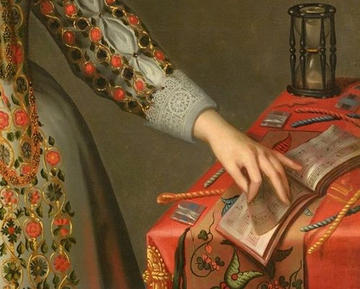
On the left-hand panel, the youthful Anne is turning the pages of a manuscript of musical notation. The scholar Lynn Hulse has suggested that the image was probably copied from a set of part-books for playing the viol. Yet while we see bars containing clefts and neumes, this is not a ‘real’ piece of music. Rather, it is an artistic impression of music, a visual representation of notes that cannot really be played.
A double-headed twelve-course lute stands against the table. Anne may well have been taught the lute as a child, either by the lutenist to the royal household, Thomas Cardell, or her tutor’s brother, John Daniel, a lutenist and composer who joined the household of the future Charles I in 1617. She also seems to have been taught to play the viol by the renowned composer and viol performer, John Jenkins. Yet while music was seen at the time as the ‘chiefest ornament’ of well-born women, the inclusion of the lute here probably has a symbolic meaning. Due to their distinctive shape, lutes were associated with female fertility and sexuality. And as representations of musical harmony, they were also associated with marriage. The nearly-sixty-year-old Anne is portraying her past self here as the ultimate eligible marital partner: educated and accomplished, well-read, skilled in music and embroidery, and the rightful heir to a great estate. Music forms an essential part of her projection of social privilege and landed power.
References
Lynn Hulse, ‘In Sweet Musicke Did Your Soule Delight’ in Karen Hearn and Lynn Hulse, ed. Lady Anne Clifford: Culture, Patronage and Gender in 17th Century Britain (Yorkshire Archaeological Society, 2009), pp. 87-97.
Blogs 01 2018 - 08 2018
In my last post I looked at artworks from the castle at Runkelstein in what is now northern Italy inspired by popular courtly romances and epics. In this piece, I turn to murals from around the same period in Vienna inspired by the rather different court poet, Neidhart von Riuwental, and in rather less grand surroundings…
A visit to Vienna in the autumn provided an opportunity to make the personal acquaintance of a work of art I first came into contact with as a finalist, now an increasingly long time ago. The Neidhart murals are the earliest secular wall paintings in Austria, and remarkable for their size (there are extensive remains of about 30 metres of paintings), and for the vividness with which they give life to figures made famous by literature. They are based on the songs of the thirteenth-century poet Neidhart von Riuwental (a stage-name roughly translating as Deeply Envious of the Vale of Sorrows—surely a distant relative of that prolific letter-writer Disgruntled of Tunbridge Wells..). Neidhart also became the object of narrative texts that grew up after his death. The most famous, Neidhart Fuchs, was first published in 1491, and again in the sixteenth century—evidence of a remarkably long-lasting affection among audiences.
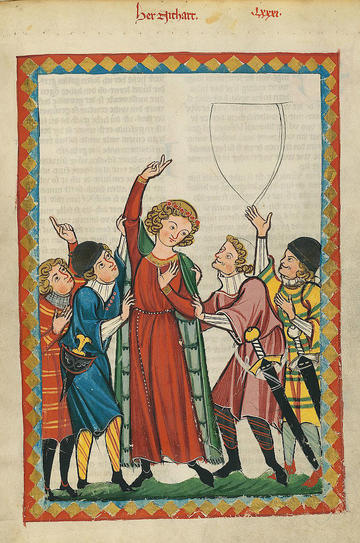
Manesse Codex, Heidelberg, Universitätsbibliothek, cod. pal. germ. 848, c. 1300-1340, Zurich, f. 273r
Neidhart’s poems play out the topoi of courtly love (the male love-servant who gains his lady’s favour after completion of difficult tasks, and by suppressing the expectation of fulfilment or reward, while both parties exhibit the most refined manners and behaviour) among the village world of farmers and peasants. They are, of course, not ‘proper’ courtiers, and so things do not go the way they should. Part of the anti-Ruritanian feel of the poetry is the strange choice of the word dörper (‘villagers’) to name the peasants. Rather Low German in colour (that is, the family of dialects spoken in the Netherlands and the north of modern Germany), it places these non-courtly events at a safe remove from Neidhart’s audiences in Vienna, where he was in the service of Duke Frederick II in the 1230s and 40s.
Interpreting the songs has proven somewhat difficult; some read them as an expression of snobbery, the court making fun of those striving to climb the greasy pole. This reading is certainly not without its merits, for instance Neidhart makes fun of the dörper’s affected dress, remarking in Winterlied 24:
Enge röcke tragent sî und smale schaperûne,
Rôte hüete, rinkelohte schuohe, swarze hosen.
Engelmâr getet mir nie sô leide an Vriderûne,
Sam die zwêne tuont, ich nîde ir phellerîne phosen,
Die si tragent:
They wear tight-fitting skirts and narrow hoods
Red hats, buckled shoes and black breeches.
Engelmar never did anything to Vriderun to hurt me so much
As those two do; I envy the purple purses
That they carry at their belt.
At the same time, though, we could also think about them as criticism of the skin-deep courtliness of certain courtiers. In Ursula Peters’ reading, this is particularly targeted at those members of the lower nobility whose drive to break through the glass ceiling in the thirteenth century was putting pressure on the Establishment ministeriales. That is to say that the dörper recall the alarming decay of old social structures. (Compare the image of the farmers putting on armour and playing at knights, an idea also sent up in Werner der Gartnære’s short story Helmbrecht. In that text, aspirations to courtliness are also mocked by the family of the title figure when he returns home spouting random fragments of foreign languages. Think Del Boy Trotter in Only Fools and Horses saying things like ‘Mange tout, Rodney...’)
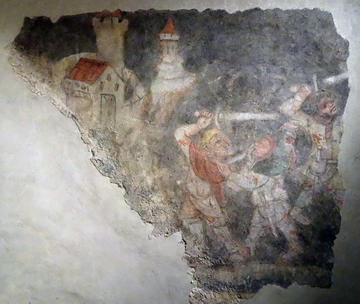
Mein Bezirk, https://www.meinbezirk.at/donaustadt/lokales/die-neidhart-fresken-d74043... 20th Nov 2017
The origins of the murals in Vienna also shed some light on the cultural capital of this literary material, even at quite some remove from its first ‘publication’ and from a non-courtly quarter. Commissioned by the merchant Michel Menschein possibly around 1398, they were rediscovered during building works in 1979 in a house in the street called Tuchlauben, named after the cloth merchants who lived and sold their wares there. The murals offer an exciting insight to some of the people who listened to Neidhart’s songs, as well as what happens to the works of court poets after their time. By this point Neidhart was a major folk hero, and a rather magnificent grave had been built for him on the south side of St. Stephan’s Cathedral in Vienna, although it is at best unclear that he was actually buried there.
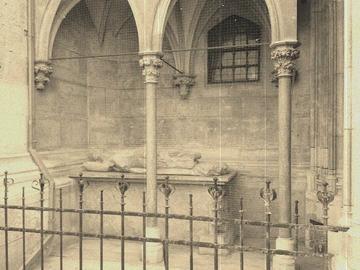
Credit: Wiener Geschichte(n), http://wiener-geschichten.at/2017/08/01/neidhart-von-reuenthal/ 10th Nov 2017
What, then, was it that attracted this merchant to decorate his house with these rather lascivious misbehaving villagers? It seems reasonable to suppose that there is a certain amount of snobbery to be read here: Menschein was one of the city council, and a major international business man dealing with traders from Cologne and the Low Countries. Also, since silk was not produced in Vienna until the eighteenth century, he would have traded with Venetian merchants, whom he may well have entertained in this room. The choice of subject seems to tread a line between showing himself to be a man of the people on the one hand, and showing how comparatively refined he was.
After all, no-one could possibly think Menschein and his family capable of the unpleasant practical joke in the Violet scene. Based on the song ‘Urlaub hab der winter’ [‘Let winter take its leave’], this scene is also portrayed on an exterior wall at Runkelstein castle in Südtirol, discussed in my last post. In it, the ruler has decreed that the first person to see a violet each year must tell him about it, so that the community could celebrate the advent of Spring. Neidhart finds it this year, and places his hat over it, so that the duchess can pick it. He runs off to find her, and meanwhile a dörper picks up the hat, and applies what might be described as home-made fertilizer to the violet. The duchess, as one might imagine, is rather upset when she lifts up the hat. Sadly, in the Vienna murals, one can only see a section of the duchess’s party walking out from the city, on the left, raising their arms in shock at the dörper’s dirty trick. Poor old Neidhart.
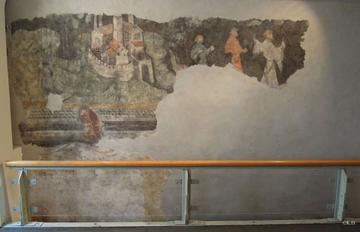
Sagen.at, http://www.sagen.at/fotos/showphoto.php/photo/30298 accessed 20th Nov 2017
What would pass these days as fairly broad humour was evidently perfectly acceptable for the Viennese bourgeoisie at the end of the fourteenth century. Just as much as proving one’s propriety, it seems that the choice of what one puts on one’s walls was about showing yourself to be a good sport. So take note on your next trip to B&Q…
What is it like to be a second son in a late medieval princely family? In this post, Christophe takes us through the example of James of Coimbra (1433 - 1459), who harnessed the political influence of his allies to aid his rapid rise to power.
(Much of this entry is based on Christophe's study in 'Évêques et cardinaux princiers et curiaux (XIVe-début XVIe siècle)'. Find out more about the book here)

Rogier van der Weyden’s workshop, Portrait of Isabella of Portugal, (Los Angeles, J. Paul Getty Museum)
Born in 1433, James of Coimbra was a son of Peter, regent of the kingdom of Portugal from 1442 to 1448, and was raised as a noble in a cultivated milieu. As such, he fought the battle of Alfarrobeira (20th May 1449) where his father died, and he was taken prisoner aged 15. He remained a captive until the end of the year, when his aunt, Duchess Isabella of Burgundy, managed to have him, his brother John, and his sister Béatrice freed and ultimately taken to the Low Countries.
The three of them benefited from the protection of Isabella and her husband, Duke Philip the Good. Béatrice was betrothed to and married an important Burgundian courtier, Adolf of Clèves, Lord of Ravenstein, (the duke’s nephew), whilst James’ brother John became a diplomat, a soldier and a counsellor for Philip of Burgundy. He then left for Cyprus to marry the 12 year old Charlotte of Lusignan, heir to the island kingdom, where he died a year later, possibly poisoned on the orders of his new mother-in-law…
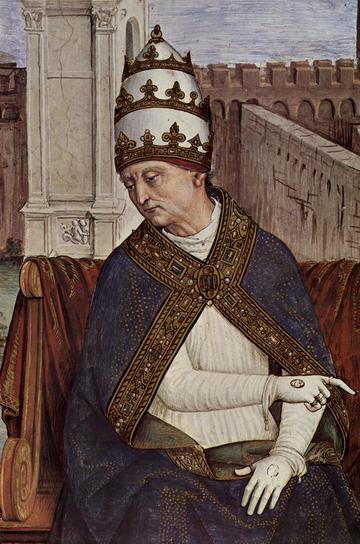
Pius II (Pinturicchio, The Arrival at Ancona (detail), Siena, Duomo, Libreria Piccolomini, (cc) The Yorck Project)
After having spent a little more than a year at the Burgundian court, where he was highly regarded and well-treated, James was sent to Rome to pursue an ecclesiastical career. This complimented the choices made for his brother, who lived as a secular lord, and for his sister, who had made a prestigious marriage alliance.
As well as being financially supported by the personal income of the Duchess Isabella, James’ career was aided by the political influence of the ducal couple. His list of appointments is extensive – he was made protonotary apostolic by the pope in 1451, elected provost of the collegiate church Saint-Pierre of Lille (in Burgundian Flanders) and made bishop of Arras “by the command of the duke of Burgundy” in 1452, bishop of Paphos in 1457, and archbishop of Lisbon in 1459. Despite receiving revenues from all of his positions, he never went to Portugal, the Low Countries, or Cyprus! He was still in his early twenties when Pope Calixtus III made him a cardinal in 1456, and he was ambitious enough to try to get himself chosen as pope at the next election of 1458, afterwards occasionally challenging the authority of the successful Pius II…
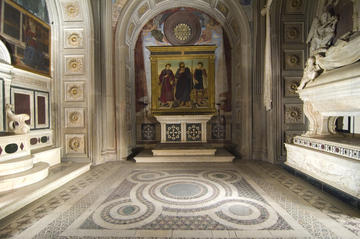
Funeral chapel of James of Portugal (Francesco Gasparetti)
Instead of travelling, James stayed in Rome, where he acted almost as a permanent ambassador for the duke of Burgundy and proved to be especially interested in Portuguese matters. He died on the 27th August 1459 in Florence, aged just 25, before being able to join the pope preparing his crusade in Mantova.
In 1466, thanks once again to the support of Isabella of Burgundy, his funeral chapel was finally erected in San Miniato al Monte, in Florence. Lucca della Robbia produced the tin-glazed terracotta of the ceiling, Antonio Rossellino built the funeral monument, Bartolomeo Platina composed the epitaph and the Pollaiuolo Brothers and Alesso Baldovinetti were responsible for the paintings.
James had thus been a perfect example of what the Burgundian rulers wanted him to be: an ambassador in the very heart of the Christendom, able to support their policy and their claims. Unfortunately for them—and for him—he died too young to be able to fulfil all of their wishes…
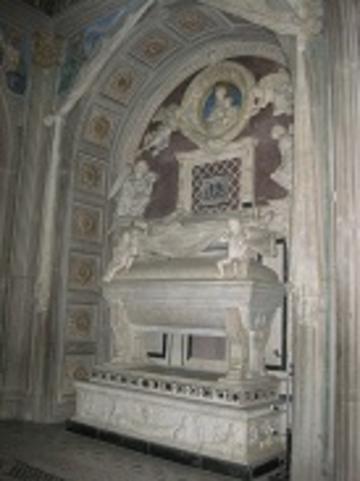
Funeral Monument of James of Portugal (Christophe Masson)
In the first of two blogs on courtly display, David Murray looks at aspirational living in the Middle Ages, how murals are useful for historians, and why you should always visit the castle privy....
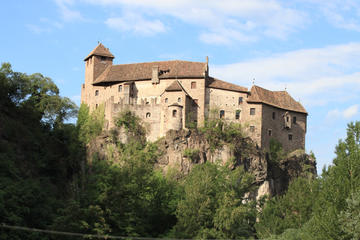
Schloss Runkelstein - Fränzl Foto BZ
One of the most valuable things you can have as a historian of any kind is a sense of what is was like to be in the place you are studying. Happily, for the student of the European Middle Ages, this is not a particularly difficult thing to acquire. There are castles, cathedrals and so on. But given the ‘Take up thy bed and walk’ approach to home furnishing favoured by rulers in the Middle Ages (and indeed long after—just think of Elizabeth I’s extraordinary summer Progresses), some of the more ephemeral elements have gone amiss in the intervening centuries. And it is of course exactly these trappings of daily life that make the past a bit more real. (For instance, I cannot be the only person whose first action on visiting a castle is to find the privy…)
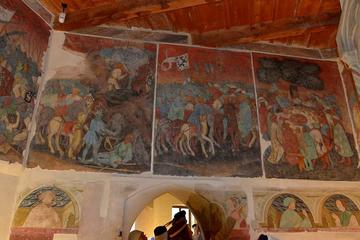
Frescos at Schloss Runkelstein - DKrieger
As such, the extraordinary series of wall paintings in the rather romantic castle of Runkelstein, (now northern Italy), discovered from the middle of the nineteenth century, offers a vivid idea of what a self-respecting man of means liked to have on his walls around at the end of the fourteenth century. They are certainly an antidote to any lingering suspicions anyone might have about the dreary Middle Ages. Quite the riot of activity and colour, the paintings combine pictures of favourite characters from courtly romance like Tristan, Wiglaois and the now less-well known Garel, with what seem to be scenes of everyday courtly folk in their natural habitat.
What is most remarkable about Runkelstein is the extent of the paintings: for a relatively small castle, there is an astonishingly large area of preserved mural, inside and out. For instance, on the gallery of the so-called summer house are triads of the greatest heroes of the Christians, Jews and heathens—as they would probably have labelled them. For instance in this picture, you can see on the far left of the gallery a sliver of King Arthur, Charlemagne and Geoffrey of Bouillon.
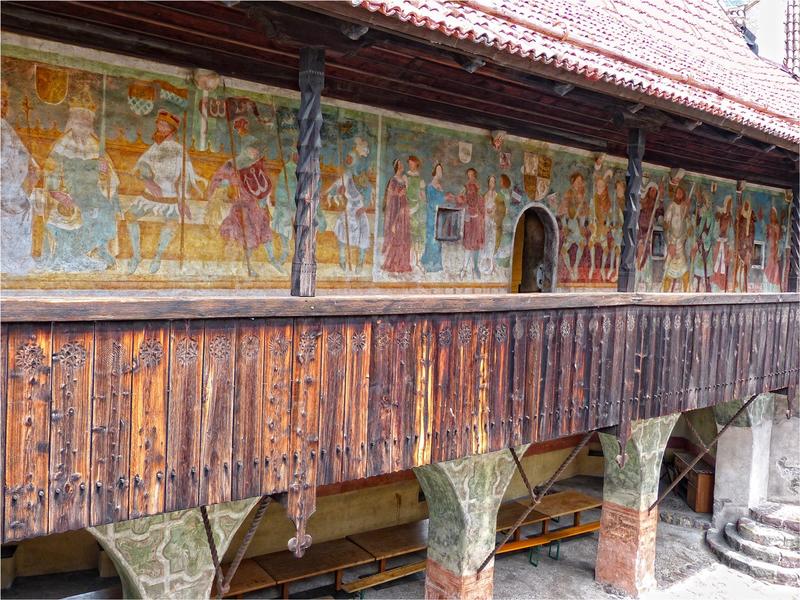
The summer house gallery - Eduard Kleitsch
Inside, an idea of the sheer scale of the decoration from the room devoted to the story of Garel vom blühenden Tal, a romance by the Salzburg poet of the mid-thirteenth century Der Pleier (currently the object of renewed interest in medieval German studies). Left to right, we see Garel, a knight of the Round Table defeat the forces of Ekunavers of Kanadic who had had Guinevere abducted at the beginning of the romance. Garel takes the captured enemy knights to King Arthur—the meeting with the king is the middle scene. Finally, the right-most scene, all Arthur’s knights gather around the Round Table.
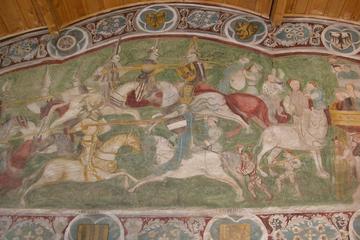
Particularly striking, and much-celebrated, are the terraverde cycle of images dated to around 1410, telling the story of Tristan and Isolde. Here is the death of the hero, the copious blood alarmingly bright against the muted colours. The frescos are of particular value to historians of costume, as they give a detailed overview of fashions over a number of decades. For instance, where the sleeves of the ladies tending to Tristan are gathered at the wrist, those of the ladies playing ball in the West Palace are fitted along the arm, a style thought to be more fashionable in the decades between 1360 and 1390.

Ladies tend to Tristan in the terraverde mural
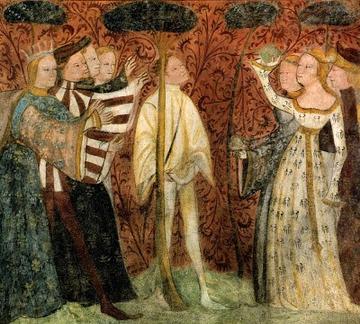
A group of ladies play ball in the West Palace - Needleprint
At any rate, the murals give a certain image of how courtly life was imagined to be. Imagination, after all, was always central to the idea of the court, and is famously sent up in the beginning of Hartmann’s Iwein, a translation-plus of Chrétien de Troyes’ Chevalier au lion. Hartmann, his eyebrow gently raised, opens by describing King Arthur’s Whitsuntide court as:
ein alsô schœne hôchzît
daz er vordes noch sît
deheine schœner nie gewan
…sich gesament ûf erde
bî niemens zîten anderswâ
sô manec guot ritter alsô dâ.
ouch wart in dâ ze hove gegeben
in allen wîs ein wunschleben
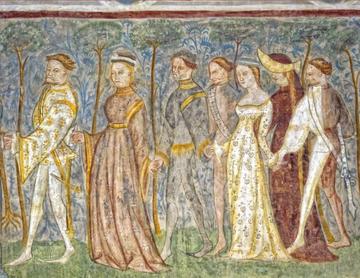
Court Life
Fresco at Schloss Runkelstein - Eduard Kleitsch
[‘Such an amazing festival, that neither before nor after did he have a better…at no time elsewhere had there been a collection on Earth of so many great knights as there was there. At court they had a dream life.’ (my trans. from ed. Cramer)]
While this topos is normally called laudatio temporis acti or praise of times past, Hartmann makes it quite clear that these are times that never happened. Indeed, he goes on to say that he would rather not have lived in those times, preferring to live in the present and to enjoy the stories about them.
In fact, this idea of a ‘wunschleben’ rings true in the story behind the paintings at Runkelstein. The man who commissioned the paintings, Nicklaus Vintler, was himself not noble, coming from a major mercantile family from Bozen. He was a counsellor to Leopold III, the Habsburg duke of Carinthia, as well as acting as his castellan at the important castle of Reinegg, ten miles south of Runkelstein; nonetheless, he did not have his own coat of arms (but made one up), and had bought the castle. The beautifully ornamented castle he bought with his brother was thus very much the Vintelers’ dream, a fact made all the more real when the family was dispossessed in 1409 by Friedrich mit den leeren Taschen, [‘with the empty pockets’], duke of Tyrol. Ruined by the impecunious prince—who resented the close relationship the Vintlers had had with another branch of the Habsburgs—Nicklaus’ brother Franz had to sell the property definitively after Nicklaus’ death.
So next time you see a mock-Tudor house, spare a thought for the brothers who went one better with their mock-Arthurian palace. Now that’s aspiration.
On 5-7th April 2018, project member Laura Slater attended the ‘Association for Art History’ annual conference in London, held at the Strand campus of King’s College London and The Courtauld Institute of Art. She gave a research presentation on ‘Devotional Soundscapes in the Psalter of Queen Philippa’ as part a thematic strand organised by Margit Thøfner and Tim Shephard. More excitingly, she contributed to a live musical event held at The Courtauld Gallery, organised by Dr Charlotte de Mille, founder and curator of the music programme at The Courtauld Gallery.
The programme began in the inspiring surroundings of the Medieval and Renaissance gallery, surrounded by Italian paintings by Bernardo Daddi and Fra Angelico. The singers sang directly below Lorenzo Monaco’s stunning c. 1370-1425 Coronation of the Virgin. Laura introduced the music from ‘Queen Philippa’s Psalter’.

The singers performed choral plainchant and psalms taken directly from the music found in the manuscript that she is researching for the MALMECC project, and that would have been heard by Philippa of Hainault when she attended services of the Divine Office.
This was followed by other research-informed performance pieces. Laura Stefanescu, a member of the ‘Music in the Art of Renaissance Italy’ project, introduced music that might have been familiar to the ducal court of Urbino.
After the dramatic plainchant from Queen Philippa’s Psalter, the audience enjoyed further examples of early Renaissance polyphony, with the performance of work by Francesco d’Aiolle, an important Florentine composer. He was one of the first to combine northern European sacred polyphony with distinctive Italian tones and harmonies.

Samuel Courtauld
The Courtauld Gallery is a wonderful collection of art, first built up by the textile magnate Samuel Courtauld and his wife Elizabeth.
In the later 1920s, Samuel and his wife were some of the first collectors of French Impressionists and Post-Impressionists, at a time when this art was still controversial and often ridiculed. Advised by the art critic Roger Fry, he bought numerous works by Cezanne, Renoir, Manet and Van Gogh, including masterpieces such as Manet’s A Bar at the Folies-Bergère and Déjeuner sur l’herbe, as well as a female nude by Modigliani.
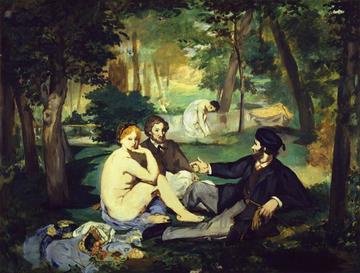
Manet, Edouard; Dejeuner sur l'herbe; The Courtauld Gallery; http://www.artuk.org/artworks/dejeuner-sur-lherbe-207294
Although its collection of twentieth-century paintings includes major works by Impressionists and Post-Impressionists, German Expressionists, the French Fauves, the Camden Town Group and the Bloomsbury Group, there is much more to see from earlier periods at The Courtauld Gallery, with major works by Cranach, Rubens, Gainsborough, Claude, Van Dyck, Goya and Tiepolo. Paintings, prints and drawings, sculptures and other decorative arts, such as an impressive collection of ivories and Islamic metalwork, are all on display.
On the 16th and 17th February the MALMECC team welcomed an international gathering of medievalists to Oxford for a workshop focused on ecclesiastical courts as places of cultural production, performance, reception and dissemination. The team hoped that assembling scholars of many different disciplines (including historians, musicologists, art historians and literary scholars) would both illuminate this important but understudied social milieu or setting, and facilitate future theorization.
Proceedings began in the suitably magnificent St Luke’s Chapel—sadly only neo-Gothic—with words of welcome from Prof. Karl Kügle, in which he laid out some of the questions that had been asked of invited participants and which were open for discussion: how should we define the ecclesiastical court? Beyond the households of (prince-) bishops and cardinals, could one perhaps include cathedral or collegiate church chapters? What about noble monastic houses such as the royal abbey of Las Huelgas or the Frauenstift at Essen? What, if anything, distinguished the ecclesiastical court from a secular one?
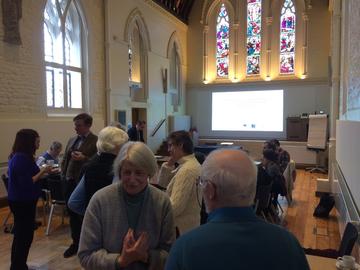
The first paper was given by Prof. Dr. Werner Paravicini. Taking as his subject matter the Teutonic Order, Herr Paravicini traced the developing differentiation between the knights and the Grand Master of the Order, the increasingly blatant retention of aristocratic practices that knights had supposedly given up on entry, with secular titles mentioned in the administrative documents of the order from the 1370s, and worldly rank becoming increasingly important for one’s treatment in the order. A far cry, then, from the ‘background-blind’ beginnings of the knighthood where officers were elected and personal property anathema. There was also a clear falling-off in religious observance, or, if knights were in chapel, there are accounts of brothers sitting in the stalls with hawks on their wrist. Next, Prof. Kügle read a paper on the court as heaven, and heaven as a kind of court, examining parallels in the importance of performance and proximity between religious and secular hierarchies. The generation of distinction, to use Bourdieu’s phrase, became a central goal of courtly life, often taking the form of the invention of new traditions (think of the knightly orders founded by so many dynasties in imitation of the Garter), while the overwhelming important of closeness to the source of power was common to both types of court.
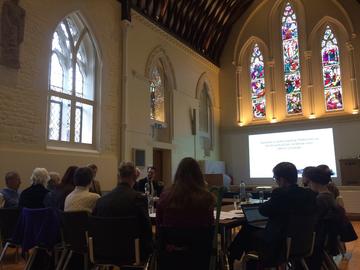
The second day of the workshop, when the participants met in the Margaret Thatcher Centre at Somerville College, began with a paper by Prof. Dr. Andreas Bihrer. Regrettably, Prof. Bihrer was unable to join us in person, but had very kindly allowed his paper to be circulated and discussed in his absence. Taking as his point of departure the Oxonian Walter Map and his De nugis curialium, his contribution was a stimulating and wide-ranging discussion of the episcopal court. Proposing a wide-ranging approach to the court as the ‘bishop’s milieu in its entirety’, including even the cathedral chapter, Bihrer suggested that ecclesiastical courts were more stable and office holders rather more independent than their secular homologues. This discussion was continued among the participants in Oxford, who wondered how the differentiation between entourage or familia and institution could be negotiated. Paired with Prof. Bihrer—whose PhD was a study of the court of the Bishops of Konstanz in the early fourteenth century—was Dr David Murray, whose paper looked at the court of Pilgrim II of Salzburg. Focusing on the adoption of influences from Prague (the Schöne Madonnen statues) and from France (in the shape of the melody of a three-part canon re-used by the Monk of Salzburg), he asked how cultural pursuits could be used in the elaboration of a shared identity among courtiers and, indeed, in the bishopric at large.
After coffee, Dr Laura Slater offered a paper which opened up discussion of the place of women at ecclesiastical courts, not only as visitors (including the example of Philippa of Hainault’s chilly reception on a visit to her husband at Durham), but also as valuable connections to secular power structures, for example as abbesses of reichsunmittelbare abbeys. Similarly, in secular courts, women (especially queens) were often responsible for the fostering of relationships to religious houses and, in cases such as that of St. Margaret of Scotland or St. Elizabeth of Thuringia, introducing an air of holiness to the court.
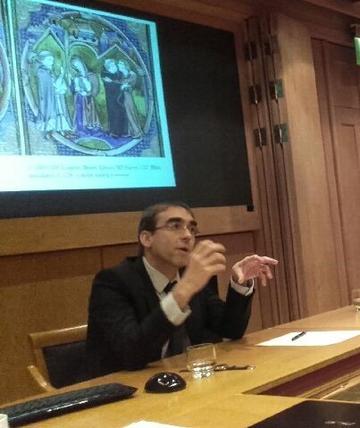
In the afternoon, attention was turned to Avignon as Prof. Étienne Anheim and Dr Christophe Masson drew the spotlight respectively to the Papal court and the cardinals’ livrées. First Prof. Anheim gave an illuminating account of the curia as a polycentric court which ‘produced’ government and the place from which the representation of power was done. It was, he suggested, the hieratic environment that encouraged and facilitated the development of the courtly model later exported around Europe. Dr Masson’s paper investigated the practical, methodological and also conceptual problems of studying the cardinals at Avignon, offering a view of the popes as super-cardinals, not cardinals as mini-popes as is more common in scholarship. The participants also discussed the problems of identifying in the records those responsible for liturgical singing, and the differentiation of cappellani from cappellani cappellae, as well as the evidence for competition between cardinals to host the most sumptuous entertainments.

In the final discussions, participants returned to the question of the relationship between household and court, seeing the one as the centre of the other, larger organism. It was also suggested that an administrative or judicial approach could be fruitful as a means of identifying courtiers as those subject to legal protections or exemptions from taxations. Rich food for thought, indeed. The workshop was undoubtedly a great success, and laid the foundations for important future conversations among the participants, opening up new lines of enquiry for all involved.
We were particularly grateful to our international visitors, Prof. Dr. Paravicini and Prof. Anheim, for their valuable contributions and participation. Special thanks are also due to both the project administrator Martha Buckley for all her organizational and logistical help, and to John Merrington of Somerville who assured the smooth running of proceedings on Saturday.
In her last post, Laura introduced us to the elaborate tombs of the Hastings family at St Mary’s priory Abergavenny, and showed what they can reveal about attitudes towards memorial and self-image amongst late-medieval nobles. This time, Laura turns her attention to other tombs at St Mary’s, and the difficulties of studying medieval art in Britain.
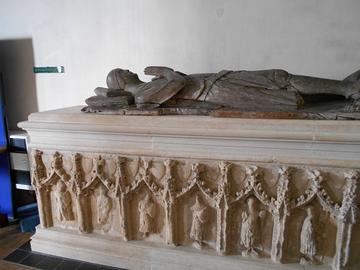
Weeper figures with heraldic shields
The Hastings tombs at Abergavenny, and the impressive fifteenth-century alabaster tombs of the Herbert family, that also now lie in St Mary’s Priory, contain spaces for weeper figures on their tomb chests. Sometimes, they were shown carrying heraldic shields, as in the angelic mourners seen on the tomb of Sir Richard Herbert and his wife Margaret. Or they might be secular figures, usually family members and ancestors. Such ‘kinship tombs’ formed a powerful display of aristocratic lineage.
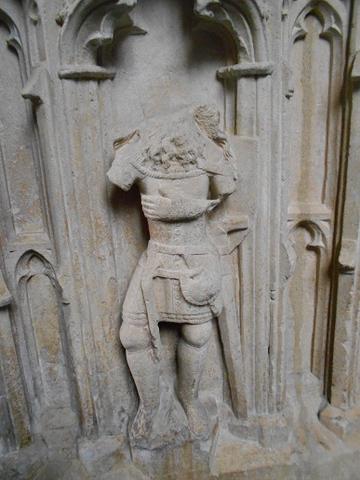
Weeper figure from the tomb of Laurence de Hastings
Studying medieval art in Britain means looking at rare fragments and chance survivals. During the Reformation, from 1535 onwards, monastic houses, holy sites, and the images, sculptures and wall paintings inside them were destroyed, whitewashed over, or removed from the landscape altogether. The Civil War and the Commonwealth in the seventeenth century caused further damage and destruction, especially to ‘royalist’ or aristocratic monuments. It is impossible to know how much was lost. Professor Colin Morris estimates that with the exception of English alabasters, ‘there is more late medieval art at Cologne than in the whole of England.’ This weeper figure from the tomb of Laurence de Hastings, probably intended to depict one of his family members, has been a victim of later iconoclasm.
Yet St Mary’s also contains extremely rare and valuable surviving artefacts. These images of saints and Biblical scenes, found on the alabaster tomb chest of William ap Thomas (d.1446) and his wife Gwladys, was barely touched by iconoclasts bent on removing ‘idolatrous images’. We can clearly see St Margaret standing in triumph over the dragon, and the Virgin seated with the Christ Child. We can also make out the scene of the Annunciation to the Virgin, flanked by angels. In the centre is the lily flower, symbolising Mary’s virginity.
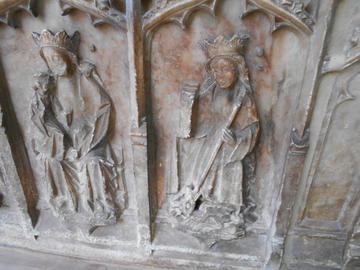
The Virgin Mary and infant Christ (left) and St Margaret and the dragon (right)
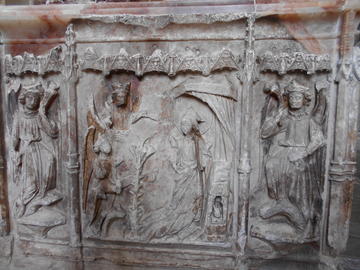
The Annunciation
The tomb still contains much of its original polychromy. It has been suggested that the region’s close ties to the House of Tudor, or simply the local power of the Herberts themselves, stopped reformers from getting too busy with their hammers and chisels.
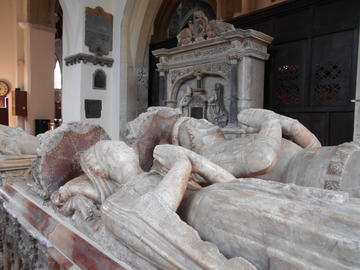
Tomb of Sir Richard and Margaret Herbert
In the second of her posts on commemoration, Laura shows the role that effigies could play in creating dynastic identity.

London, British Library MS Royal 20 C VII, f.40v: funeral service
Most aristocrats did not set up public crosses in memory of their deceased loved ones. But it was seen as very important for the salvation of your soul to be laid to rest properly, with all the right prayers and rituals. Funeral services were usually meticulously planned and could last for many days. Vigils were kept over the corpse and Requiem Masses would be said for the deceased. After the burial itself, funeral feasts could also be held on successive days, alongside lots of alms-giving. A month after the death, more feasts, masses and alms-giving followed on what was known as the ‘month’s mind’.
The elite of medieval Europe commissioned elaborate tombs, with a sculpted effigy on top depicting an idealised form of their living selves. Like the Eleanor Crosses, these not only kept the memory of the deceased alive, but would prompt- and sometimes explicitly request- the prayers of passers-by.
By the later middle ages, most aristocrats also had traditional dynastic burial places: religious houses that might have been founded by their ancestors, and remained supported by the family. The church of St Mary’s Priory in Abergavenny, in the scenic Brecon Beacons area of Wales, preserves many tombs of the Hastings family.

St Mary's Priory Abergavenny
The priory was originally founded in 1087 by a Norman knight, Hamelin de Ballon, and was staffed by monks from the abbey of St Vincent, in Le Mans. But in the early 1320s, John de Hastings was given control of Glamorgan by Edward II. A nephew and retainer of the staunch royalist Aymer de Valence, earl of Pembroke, these lands in Wales formed a rich reward for John’s service at court. As the new lord of Abergavenny, John de Hastings made his mark on the local priory. He arranged that the French monks of St Mary’s be replaced with Englishmen (resulting in prolonged legal disputes and appeals from the evicted monks) and completely rebuilt the priory church, including its tower. He died in 1325 and his beautiful wooden tomb effigy rests in the north transept. Originally, it would have been painted and gilded.
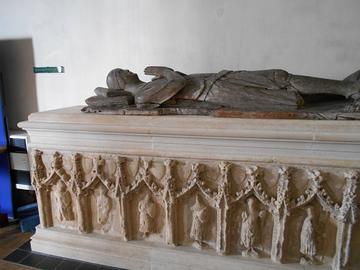
John de Hastings d.1325
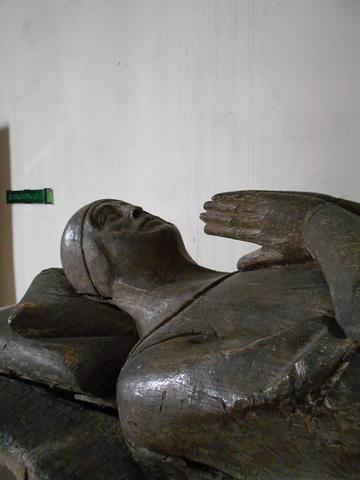
Detail of John de Hastings' effigy
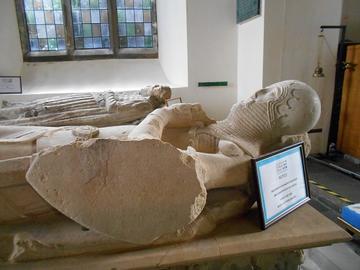
Laurence de Hastings, d.1348/9
His son, Laurence de Hastings, was only four when John de Hastings died in 1325 and wardship of his lands passed between numerous courtiers, including Edward II’s notorious favourite, Hugh Despenser the Younger. In 1328, at the age of just seven, he was married to the third daughter of Roger Mortimer. Mortimer was another controversial courtly favourite, this time of Queen Isabella of France, de facto regent of England until 1330. Mortimer, supposed by many to be the queen’s lover and blamed for all the evils of the regency government of Edward III, was clearly using his position at court to enrich himself and his family, exploiting his connections to make excellent marriages for his daughters.
In 1332, Hastings is recorded as an esquire in the household of Queen Philippa of Hainault and went on to make his career in royal service, fighting regularly in Edward III’s wars. He died in August 1348 or 1349 at Abergavenny and was again buried in the priory church.
Shown in armour, sword by his side and wearing an elaborate jewelled belt, the tombs of Laurence and his half-brother William, who also died in 1348, tells us how the Hastings family wanted to be remembered- as wealthy and powerful warriors.
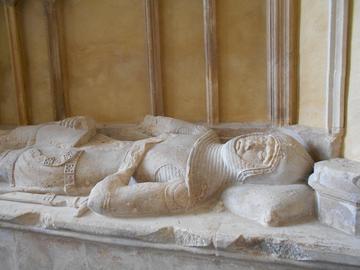
William de Hastings, d.1348
But neither died in battle. It is even possible that the brothers died of the bubonic plague, better known as the Black Death. The disease first reached England in summer 1348, and the first recorded instances of plague in Wales came in April 1349. As royal courtiers, who will have regularly travelled around southern England, including coastal towns such as Dover and the disease-ridden capital of London, it is perfectly possible that these members of the Hastings dynasty were some of the earliest casualties of the plague.
In the first of a series of posts on commemoration, MALMECC's art historian Laura Slater looks at the phenomenon of the 'Eleanor Crosses' - a very visible memorial to Eleanor of Castile.
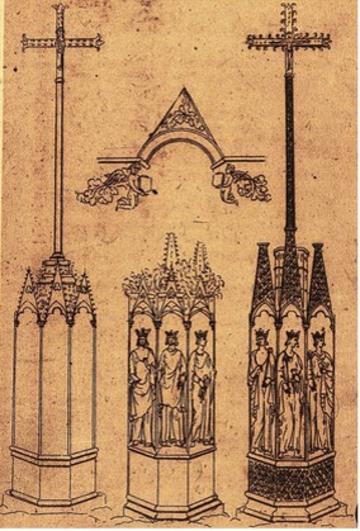
Montjoies, sketched in the 17th century
One example of a happy royal marriage was the union between Edward I of England and Eleanor of Castile. Eleanor accompanied her husband on crusade in 1270, and gave birth to her fifth child while staying in Acre, a daughter named Joan. In 1272 in Acre, Edward was attacked by an assassin with a poisoned knife. Surgery was required to remove it- a drastic step in a world without anaesthetics and with little means of preventing infection. The contemporary chronicler Walter of Guisborough records that Eleanor was led from Edward’s bedside before the operation, weeping and lamenting. Later legends suggested that Eleanor herself sucked the poison from her husband’s wound. Even in an age of pragmatic aristocratic alliances, people still liked the idea of a fairy-tale royal romance, followed by a loving and happy marriage.
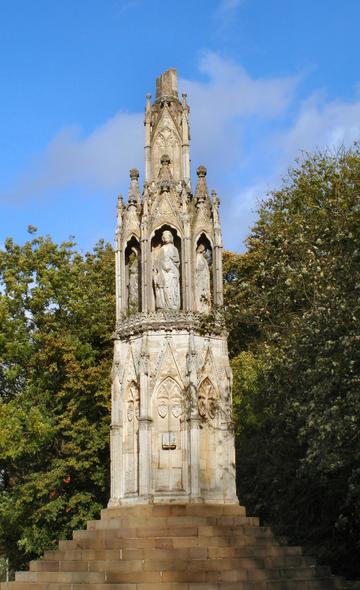
The Eleanor Cross at Northampton
When Eleanor died in 1290, a grief-stricken Edward I ordered that twelve monumental crosses mark the places where her funeral cortege rested each night, as it travelled down from the village of Harby in Nottinghamshire, where Eleanor died on the 28th November, to her final resting place at Westminster. In another reminder of the internationalism of late medieval courtly culture, the crosses echoed the royal ‘montjoies’ of France: a series of sculpted crosses set up between Paris and the abbey of St Denis to mark the route of King Louis IX’s funerary procession. All French monarchs were laid to rest at St Denis, and by the later thirteenth century, Westminster Abbey was becoming a similar royal mausoleum for the Plantagenets.
The surviving Eleanor crosses display numerous statues of the queen, shown in idealised and youthful form. Her hair is loose, just as it would have appeared at Eleanor’s coronation. The statues of the queen strongly resemble contemporary images of the Virgin Mary, deliberately drawing parallels between the dead queen and the tender, beloved mother of Christ. In contrast to vengeful saints like St Cuthbert of Durham, the Virgin Mary was venerated as a loving and forgiving intercessor- a caring mother whose spiritual grace could always be relied upon, no matter what your sins.
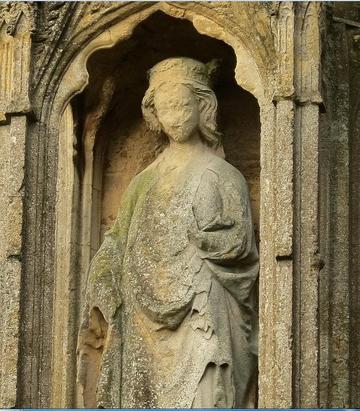
The 'Hardingstone Cross'
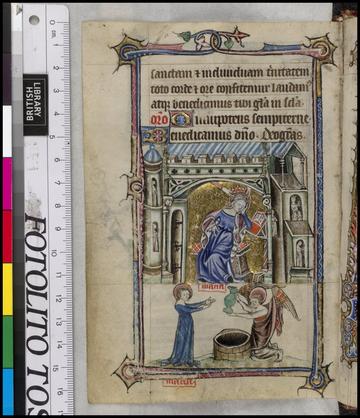
(BL MS Yates Thompson 13 (Taymouth Hours), f.59v- Virgin Mary)
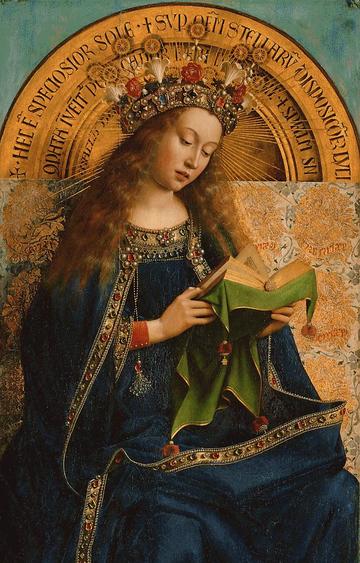
The Virgin Mary from 'The Ghent Altarpiece' by Jan Van Eyck
Decorated with an array of royal heraldry, the crosses form a lavish display of royal splendour. They also had a devotional function. Open books can be seen on some of the crosses. Originally, they were probably painted with requests for prayers. People passing the cross would have been encouraged to look up, see the beautiful figure of the English queen (who looked just like the Queen of Heaven) and then pray for her soul.
But would your medieval man or woman on the street have actually been willing to do this? In her lifetime, Eleanor was widely disliked by the common people. Four years before her death, John Peckham, the archbishop of Canterbury, wrote to one of Eleanor's officials that:
‘It is said that day by day the said lady [Eleanor] continues to acquire plunder and possessions of others…There is public outcry and gossip about this in every part of England.’
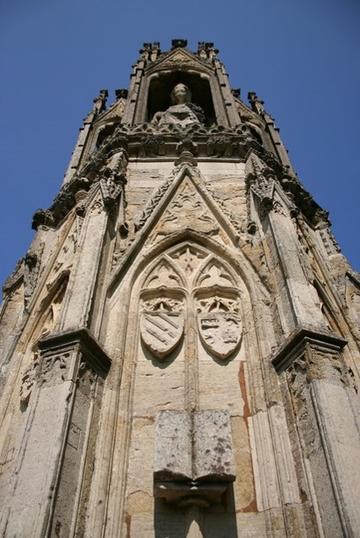
Detail of the books on the Hardingstone Cross
Eleanor encouraged her officials to be as grasping as possible, and took over the collection of debts to Jewish moneylenders, gaining the lands pledged as security for these debts. She was also blamed for the ‘oppressive’ aspects of Edward I’s government, as he raised taxes to fight his wars with Scotland, Wales and France. As a popular contemporary song had it: ‘The king would like to get our gold. The queen, our manors fair to hold.’
As well as a token of Edward I’s deep and genuine grief, the Eleanor Crosses may also have become part of (a perhaps unwitting?) royal PR effort - for as the later legends of Eleanor’s heroics in Acre show, she was ultimately remembered as a loving queen.
For a medieval French knight, being a courtier was just as important as being a tactician and military leader. Here, Christophe investigates the many facets of knighthood, inspired by his recent article in a special edition of Revue du Nord.
King Henry V: What prisoners of good sort are taken, uncle?
Exeter: Charles Duke of Orleans, nephew to the king, John Duke of Bourbon, and Lord Bouciqualt.
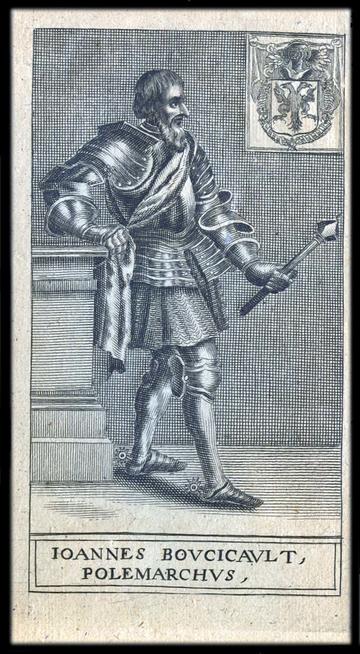
William Shakespeare, Henry V, Act 4, Scene. 8 Marshall Boucicaut
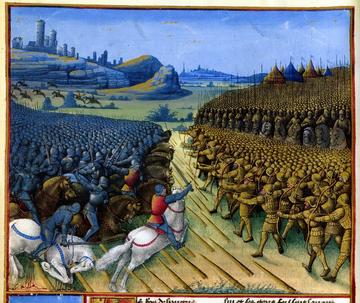
‘Battle of Nicopolis’ (1396), f. 263v. Sébastien Mamerot, Les Passages d’Outremer, Fr. 5594, BnF
In the early fifteenth-century, one of the most prominent French knights and captains was Jean II Le Meingre, commonly known by the nickname Boucicaut.
He was an accomplished jouster who took part in prestigious military campaigns: he joined the Prussian reise, took part in the infamous Nicopolis Crusade (1396), fought in Constantinople against the Turks (1399), ruled the Republic of Genoa for the king of France Charles VI (1401-1409), and of course, waged war against routiers and British troops during the Hundred Years War. It was only to be expected that he would join the French contingent sent against Henry V’s army in Normandy in 1415.
As a Marshall of France—the second most important function in the military hierarchy—, he led an impressive army to cut off the retreat of Henry V towards Calais. He even issued a battle plan, found in the 1980s, that would probably have changed the course of the battle if it had been followed, although it was unlikely to change French and English history. In the end, the French fought differently and were crushed by the English. Kept prisoner, Boucicaut remained a captive until his death in 1421.
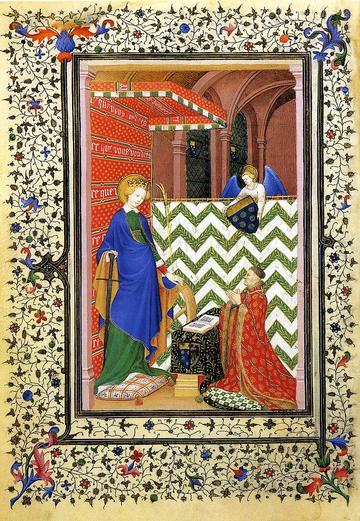
'Marshall Boucicaut Praying before Catherine of Alexandria’, Musée Jacquemart-André, Ms. 2, Livre d’heures du maréchal Boucicaut
Despite this eventful life, Boucicaut was more than a knight loyal to his king. A well-known courtier, he gathered around him several knights and squires who served him in his wars, some of them for years. One of these was Guillaume de Montrevel, who fought the Flemish rebels with Boucicaut in 1382, joined him for his adventures in Constantinople, Cyprus and the Middle East (1403) and who served him again in Italy. We can also mention Louis de Boisredont, serving in Genoa and who, in the Agincourt battle plan, was to attack the English forces from the rear.
In his role as a courtier, Boucicaut even founded his own knightly order, the Ordre de l’Ecu vert à la dame blanche (the order of the green shield with the white lady). Designed to protect oppressed ladies, it was composed of twelve knights, all Boucicaut’s companions, not least of whom was Charles d’Albret, the Constable of France and leader of the army during the Agincourt campaign.
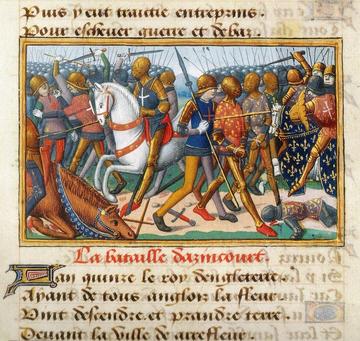
‘La Bataille d’Azincourt’, Martial d'Auvergne, Les Vigiles de Charles VII, Français 5054, BnF
The career of Boucicaut makes it clear that late medieval knights cannot be characterised simply as either brutal and short-sighted soldiers or lazy and fearful courtiers. Many were military leaders, able to conceive battle plans and strategy. Between campaigns, they would enjoy a more peaceful life, composing poems, jousting, and celebrating the service of ladies. These courtly interludes were not mere breaks in their main activities, but instead the perfect moment to create or strengthen political and martial relationships. It was these relationships which made them able to bring together a strong and numerous company of men-at-arms to fight the enemy, be it English, Turk or Italian.
In this post, Christophe discusses how authors wrote about military defeat in 15th Century Burgundy. Was the victor the captain who remained on the battlefield, or the one who captured the largest amount of prisoners and goods? In an era of knightly ideals, the most important thing was how you framed it....

Gravensteen, Ghent
Fifteenth century Burgundy is known to be one of the most brilliant polities of the late Middle Ages. The Order of the Golden Fleece, the Flemish Primitives, the illuminated manuscripts or the beautiful palaces of Dijon, Brussels and Ghent are just some examples of its legacy. Yet Burgundian dukes were also warriors who led important campaigns against, alternately, England, the Holy Roman Empire, France, Switzerland, and the Low Countries, not to mention their crusading enterprises.
Two authors, Olivier de La Marche and Jean de Haynin, respectively from Burgundy and Hainault (currently in Belgium), recorded part of their martial deeds in their Mémoires. These texts help us to understand the day-to-day life and feelings of 15th century men-at-arms. Obviously, large parts of these writings were meant to idealize their dukes, to emphasize their qualities, and to celebrate their success and prowess.
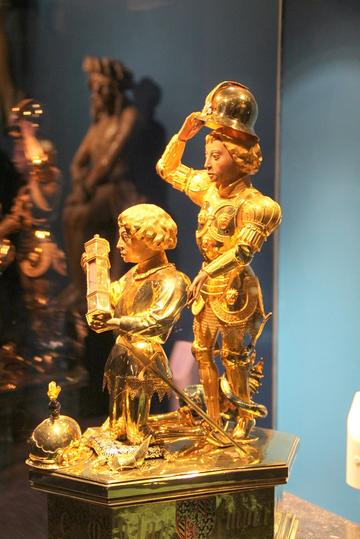
Charles the Bold, Cathedral of St Paul, Liège
Yet, the last duke of Burgundy born from the royal French house of Valois—Charles the Bold—faced several, and increasingly dramatic, defeats. In this context, one could wonder if and how La Marche and Haynin tried to “hide the truth” of his military failures. But it would be a methodological error to think that we can so easily part the so-called “historical truth” from the “historical lies.” Veterans of both successful and catastrophic campaigns, these two writers experienced what it was like to wage war in hostile regions. This is probably what they mostly wanted their readers—Burgundian dukes and aristocrats, members of the court—to understand. Each of the events they described was thus the occasion to, more or less clearly, give their ideas about warfare and how it was meant to be. In this context, defeat was not something to be met with shame alone. Of course, it was to be prevented. But when faced with defeat, there were solutions and attitudes to adopt.
In a martial prospective, the ideal captain was the one who never abandoned his troops, the one who was a kind of “father” to them.
The point most regularly made was that defeat encompasses a wide range of situations, from total annihilation to the situation where no one exactly knew who won, at the end. Was it the captain who remained on the battlefield or the one who captured the largest amount of prisoners and goods?
Order of the Golden Fleece, Kunsthistorisches Museum, Vienna
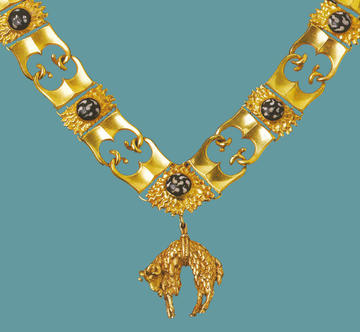
The answer of Haynin and La Marche was that what really mattered was the way in which captains acted to save as many of their men as they could, and to act as bravely and effectively as was humanly possible. In a martial prospective, the ideal captain was the one who never abandoned his troops, the one who was a kind of “father” to them. If these writers apparently minimized some defeats, it may have been less to hide the truth—that in any case would be known through other channels—than to give a model to emulate to their readers.
Last but not least, this portrait of the warrior great in defeat as well as in triumph was also used to describe the late medieval knight, no matter what his level in the military hierarchy. As this portrait began to be applied to the ordinary members of the army, it opened the way for the implicit dubbing of the entire army, commoners included. It was probably this movement that helped the knightly ideology to regenerate and survive in the Early Modern Period, not to say in Modern times…
This post is inspired by Christophe's recent chapter in P. Delsalle, G. Docquier, A. Marchandisse, B. Schnerb (eds.), Pour la singuliere affection qu’avons a luy Études bourguignonnes offertes à Jean-Marie Cauchies (Brepols 2017). You can read it by clicking here.
Blogs 08 2017 - 12 2017
Fourteenth-century courtly society may have been more intolerant of ‘sodomitical acts’ than earlier in the Middle Ages, with sodomites, traitors and heretics now bracketed together as deadly sinners. By contrast, in the eleventh and twelfth centuries, a unique tradition of passionate Christian friendship developed in clerical writing. Friendship was seen as the highest form of human relationship, helping you to learn how to know and love God. And these friendships could have a consciously erotic element to them.
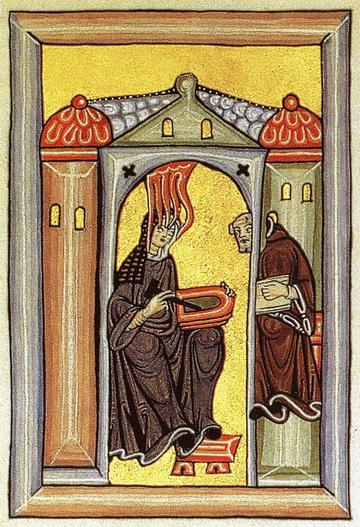
Hildegard von Bingen
The twelfth-century nun St Hildegard of Bingen is best known today for her intellectual talents: as a visionary and mystic, as a theologian and Biblical exegete, as a musical composer and scientific writer, and even as a popular public preacher and respected papal correspondent, in an age when women were ordered, as St Paul puts it in 1 Corinthians 14. 34, to ‘keep silence in the churches: for it is not permitted them to speak’.
For around a decade, Hildegard had an extremely close friendship with another woman in her convent, Richardis of Stade. Its exact nature continues to puzzle her biographers.
Erotic love and spiritual desire can be very difficult to separate in a medieval context, especially in a medieval monastery whose inhabitants were all dedicated to spiritual service, love and prayer.
In his famous study, Christianity, Social Tolerance and Homosexuality: Gay People in Western Europe from the beginning of the Christian era to the Fourteenth Century (University of Chicago Press, 1981), John Boswell highlights the erotic verse letters written from one woman to another found in a twelfth-century manuscript from Tegernsee in Bavaria. The writer declares:
I love you above all else,
You alone are my love and desire;
Another letter begins:
To G., her singular rose,
From A.-the bonds of precious love.
What is my strength, that I should bear it?
That I should have patience in your absence?
Would these women have seen their desires as a transgression of their vows of celibacy? Or would they be seen as an expression of spiritual love?
Aspremont Psalter-Hours, detail of fol. 57v
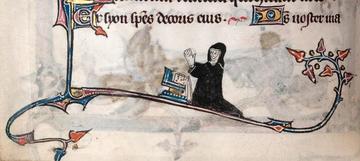
Same-sex female sexual activity was not discussed in detail by medieval manuals of sin and penitence, although such acts were still classed as sodomitical sins contra naturam. The seventh-century archbishop of Canterbury, Theodore of Tarsus, prescribed three years of penance for women fornicating with other women. An Italian legist in the early fourteenth century, Cino da Pistoia, puts his finger on exactly why lesbianism was considered an offence to the social order. He interpreted the ancient imperial Roman edict of lex foedissimam (‘laws of wickedness’) as a condemnation of ‘women who exercise their lust on other women and pursue them like men [italics added]’.
For Cino, just like the critics of Edward II and his friendships, the problem was men and women who acted ‘out of kind’, ignoring or undermining the natural boundaries that God had set for human relations.
Edith Benkov has discussed the legal implications of this idea in a recent essay. In 1405, the king of France granted a royal pardon to a married peasant woman named Laurence. Laurence had been imprisoned following the exposure of her affair with another married woman, Jehane. As Laurence describes it, Jehane had asked Laurence to be her sweetheart (‘mie’). Laurence did not see anything evil (‘mal’) in the request, a defence that would be used again by women accused of homosexual relations. After her surprise at Jehane’s sexual advances, the two would regularly meet, with Jehane doing ‘what a man does to a woman’. After Laurence sought to end the relationship, Jehane attacked her with a knife.
Valencia, Biblioteca Universitaŕia 387, f.7v
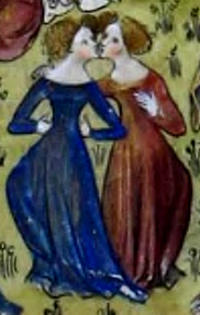
Laurence’s appeal may have been successful because it is Jehane (in this telling of the story) who took on the ‘male’, active and dominant role in the relationship. It is Jehane, not Laurence, who truly transgressed against the supposed natural order of things. We don’t actually know what happened to Jehane, or even why the case originally came to court and on what charges. But this record, possibly the earliest known criminal trial for lesbianism in Europe, shows us that female love did exist, even if it was rarely spoken about. In the Romance of the Rose, Guillaume de Lorris describes:
‘Two very charming maidens with their hair in a single braid and dressed only in their tunics […] but I need not say how beautifully they danced: one would approach the other very elegantly, and when they were close together, their lips would touch in such a way that you might have thought they were kissing one another’s faces. They knew well how to sway in the dance. I cannot describe it to you […]’
‘I need not say’. ‘I cannot describe it’. If male homosexuality was ‘the love that dare not speak its name’ in the Middle Ages, lesbianism may have been the love that others didn’t dare speak about. Especially at court.
References
Edith Benkov, ‘The Erased Lesbian: Sodomy and the Legal Tradition in Medieval Europe’ in F.C. Sautman and P. Sheingorn, ed. Same Sex Love and Desire Among Women in the Middle Ages (Palagrave Macmillan, New York, 2001), pp.101-122.
John Boswell, Christianity, Social Tolerance and Homosexuality: Gay People in Western Europe from the beginning of the Christian era to the Fourteenth Century (University of Chicago Press, Chicago, 1981)
Francesca Canadé Sautman and Pamela Sheingorn, ‘Introduction: Charting the Field’ in F.C. Sautman and P. Sheingorn, ed. Same Sex Love and Desire Among Women in the Middle Ages (Palagrave Macmillan, New York, 2001), pp.1-48.
In the last of her 'Sex at Court' posts, Laura examines attitudes to homosexuality at the medieval court - was Edward II really 'England's first gay king'? In the end, all that really mattered was power...
Actually the ‘kiss of peace’ (BL Loan MS 38, f.1v)
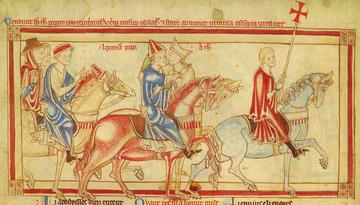
The phrase, ‘the love that dare not speak its name’ is a line from the poem Two Loves, by Lord Alfred Douglas. It was used in the late nineteenth century as a euphemism for homosexuality, including at the trial of Oscar Wilde for gross indecency.
Homosexuality as a specific type of sexual identity is another nineteenth-century social construct. Throughout the Middle Ages, men and women may have satisfied their physical desires with members of the same sex, and/or had their deepest and most fulfilling emotional relationships with members of the same sex. But they would not have thought of themselves as ‘gay’ or ‘lesbian’ or ‘bisexual’. These are all much later ways of categorising sexual desires and behaviour.

Encaustic tile from Medieval England
In popular history, Edward II has been anachronistically cast as ‘England’s first gay king’. The king did have intense, affectionate and emotional relationships with successive male ‘courtly favourites’. Contemporaries complained of the king’s ‘immoderate’ and ‘excessive love’ for Piers Gaveston, a boyhood friend. Gaveston was besieged, kidnapped and murdered by several English barons in 1312.
Yet Edward also had at least one illegitimate son, Adam, named in a wardrobe account of 1322 as Ade filio domini Regis bastardo (‘Adam, bastard son of the lord king’). Adam was probably born around 1307. By his wife, Isabella of France, Edward became the father of four healthy Plantagenet heirs. Piers Gaveston also fathered both legitimate and illegitimate children, at exactly the period when his closeness to the king was causing so much political controversy.
It may be difficult to put a modern label on the relationship between Edward II and Gaveston, but we know that contemporaries did speculate on the king’s possible sodomy. In 1334, Adam Orleton, the bishop of Winchester, was accused of publicly calling the king a sodomite, in a sermon preached at Oxford in October 1326. He strongly denied the charge, and it would have been an incendiary claim to make in public, whatever people might have thought in private.
It may be difficult to put a modern label on the relationship between Edward II and Gaveston, but we know that contemporaries did speculate on the king’s possible sodomy.
Queen Mary Psalter, Royal MS 2 B VII, f.201r
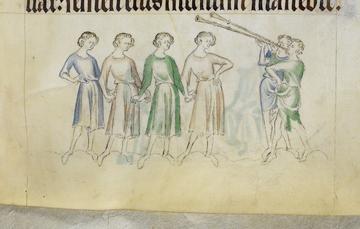
The term ‘sodomy’ is also a complex one in a medieval context. As Robert Mills highlights in his book, Seeing Sodomy in the Middle Ages (University of Chicago Press, 2015), medieval references to the ‘sodomitic sin’ (sodomiticum peccatum) usually referred to anal intercourse between males. Yet they could encompass a much wider variety of ‘sins against nature’ (contra naturam). A sin against nature might be defined as any act of fornication that failed to lead to human reproduction within the bond of marriage. Oral sex, for example, and other forms of sexual activity that ‘wasted’ semen, could all be classed as sodomitical ‘sins against nature’. These kinds of sexual excess were thought to have terrible consequences, unmaking a man and producing a homo effeminate or vir evirate- an effeminate, unmanned man.
In the world of the court, the dreadful sin of sodomy could also be a powerful political weapon. After all, courtiers were almost all men, and lived side-by-side in intense competition with each other. Every ambitious man at court wanted to get as close as possible (both physically and emotionally) to the king, and the power and favours at his command. Men aspired to a ‘sworn brotherhood’ with each other, modelled on the covenant sworn between David and Jonathon in the Bible. This could lead to affectionate, fraternal behaviour between them that their excluded rivals might well have cast as ‘unmanly’, ‘effeminate’ or ‘sodomitical’.
The Dream of the Magi’, Queen Mary Psalter, Royal MS 2 B VII, f.131v
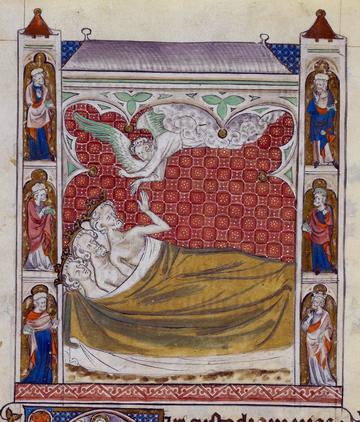
This was especially the case if your ‘brother’ was the king. Kings were not supposed to be equal to anyone. The idea of a king desperate to fulfil the desires of his ‘brother’ (or his wife), a needy, weak and ‘unmanly’ king who would not do what was best for his kingdom, but only what would satiate his own personal desires, was what really turned the stomachs of medieval courtiers.
So what of Edward II and the charge of sodomy? In his fascinating essay, ‘The Sexualities of Edward II’, the historian Mark Ormrod discusses the contemporary speculation surrounding Edward II’s sexuality in detail. Ormrod outlines how accounts of Edward’s death in Berkeley Castle in 1327, apparently killed by a red-hot poker being inserted into his anus, or the complaints of his ‘unnatural’ relationship with his last courtly favourite, Hugh Despenser the Younger, helped articulate some of the fundamental political problems of Edward’s kingship.
Casting the king as a sexual deviant and degenerate, prone to debauchery and licentiousness (among a range of other failings) helped chroniclers to explain his disastrous reign- and justify his deposition in 1327. The rex effeminatus is a rex inutilis (‘useless king’) and must be removed from power in the same way.
So while there may often have been sex at the medieval court, with all the permutations and partners that one can think of, what really mattered in the end was power.
In part three of 'Sex at Court' , Laura considers the status of mistresses and bastards. Throughout the medieval period, there was little stigma attached to being the close kin of a powerful man, whatever side of the blanket you might have been born on, and many mistresses were tolerated by royal wives...
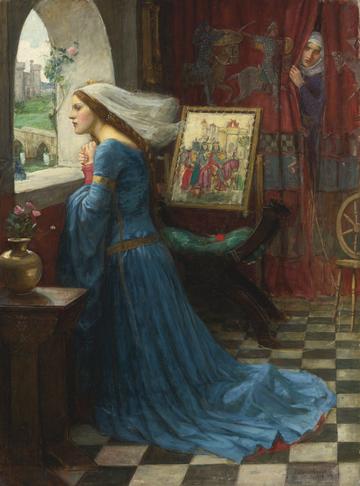
John William Waterhouse, Fair
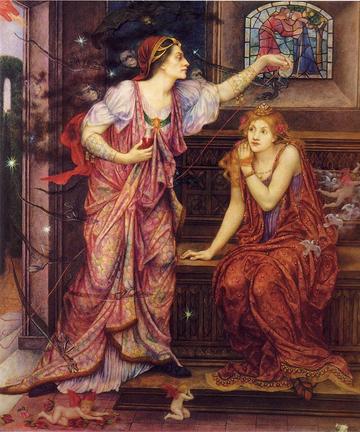
Evelyn de Morgan, Queen Eleanor and Fair Rosamund. c. 1880-1919
Courtiers and kings did not dally with whores, but as more befitting their status, maintained mistresses. The mistress of Henry II of England, Rosamund Clifford, a famous beauty, became legendary enough to inspire later Victorian art.
In the thirteenth century, the royal palace at Woodstock contained a ‘Rosamund’s Chamber’, named after her. Later legends suggested that Henry’s wife, the great patron of troubadours and courtly love, Eleanor of Aquitaine, tried desperately to poison ‘the fair Rosamund’. Henry II supposedly hid his mistress inside a labyrinth in the gardens of Woodstock palace, but the wicked Eleanor found her way in.
Unfortunately for fans of soap-opera history, the story is completely false. At the time that Rosamund was Henry’s mistress, Eleanor was in fact living under house arrest, on the orders of Henry II. The only person she might have wanted to poison would have been her husband! After her relationship with the king ended, Rosamund retired to Godstow Abbey, a nunnery just outside Oxford. Her tomb- paid for by the king and her family- even became something of a local shrine.

Godstow Abbey Ruins, © Dave Price
Although Henry and Eleanor’s marriage was a turbulent one- the queen was imprisoned for around sixteen years by her husband, after supporting a rebellion against Henry in 1173- it is most unlikely that Eleanor was particularly upset or disturbed by Rosamund’s existence. In the first place, Rosamund was only one among many. It has been suggested that Henry also bedded Rosamund’s aunt, Ida of Hainault, and Ida’s own daughter, Ida de Tosny. Another known mistress of Henry II is a woman called Ykenai, who gave birth to Geoffrey Plantagenet, a future archbishop of York. Geoffrey was even brought up in Eleanor’s household, suggesting great tolerance for her husband’s affairs.
An illuminated 'table of consanguinity' Getty Centre, MS Ludwig XIV 2, f.227v)
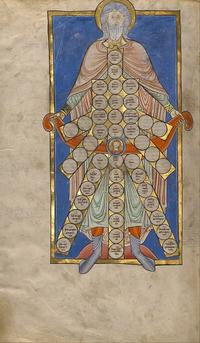
Why might Eleanor have brought up her husband’s bastard child in her own household? She may have seen in the infant Geoffrey a useful future ally. Mere mistresses, and the bastards they produced, were no threat to Eleanor’s power and position as Henry’s wife. Nor would they challenge the inheritance rights of her own children. Unlike in the early middle ages, the strict teachings of the church now gave illegitimate children no claims to the royal succession.
As a result, illegitimate kin could be relied upon. Henry II’s legitimate sons all rebelled against their father. His bastards did not. Henry II was the fount of all their wealth, power and position. Without him and his dynasty, they were nothing- so understandably, they were some of the staunchest supporters of the Angevins. Courtly half-brothers and sisters seem to have got on very well, no doubt for this reason.
Nor was Henry II unusual. His grandfather, Henry I, fathered at least twenty-four illegitimate children.
Henry I’s eldest natural son, Robert of Gloucester, became a great magnate. Another natural daughter, Maud FitzRoy (literally, ‘son of the king’) married Conan III, Duke of Brittany.
King Henry II of England and his children. (British Library, Royal 14 B VI)
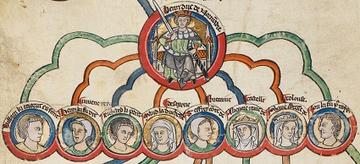
Bastards provided kings with spare ‘assets’ to be disposed of in the international courtly marriage market, helping establish peace treaties and cement wavering allies. They also provided proof of a ruler’s continuing virility. Giving birth to heirs was an essential part of a ruler’s job description. In another public display of power, the existence of many bastard children provided continuing, public proof of a ruler’s ‘manhood’- and silently implied that any problems producing legitimate heirs were due to his wife, and not to him.
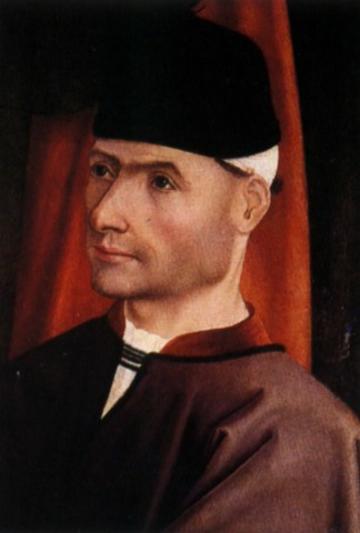
Jean de Dunois
The fifteenth-century nobleman Jean de Dunois was widely known as the ‘Bastard of Orléans’, in recognition of his status as half-brother to Charles VII of France. Anthony, the natural son of Philip III, Duke of Burgundy, was known as the ‘Bastard of Burgundy’ or simply ‘the Grand Bastard’. All such nicknames may seem incredibly rude to modern ears- but were in fact markers of great respect.
In the second part of her 'Sex at Court' series, Laura Slater looks at the phenomenon of prostitutes at court, and the various measures - including licensing, imprisonment and taxes - that were taken in order to try and regulate them.
The late medieval court was an overwhelmingly male place to be. Apart from laundrywomen, almost all of its menial household staff were male. The queen usually lived in a separate household from the king, as did their children. Female servants and ladies-in-waiting would attend these courts. But the vast majority of the courtly ‘staff’ around the ruler: courtiers and counsellors, clerics and bureaucrats, soldiers and bodyguards, diplomats and visitors, musicians and entertainers…were all going to be men. This image of courtly feasting from the Très Riches Heures shows us the all-male world of the court very clearly.

(Museé Condé, MS 65, f.1v)
The assorted hangers-on following in the train of the court would also usually be men: hopeful petitioners, messengers, spies and noble retainers. Most of these people had no official place in the royal household. Efforts were made throughout the Middle Ages in European courts to try and clear these people away from the vicinity of the court, and stop them eating, drinking and travelling at the ruler’s expense. But they invariably came to nothing. People needed to be at court: to get charters witnessed or marriages agreed, to get licenses and permissions for things, and generally just do business- sometimes with the king himself, but as often with his officials, or some of the great nobles in attendance on him. Other people’s business was the court: making a career in royal service, joining the royal household, or supplying the king and his household with the vast quantities of food, wine, clothes and jewels that courtly splendour required.
]
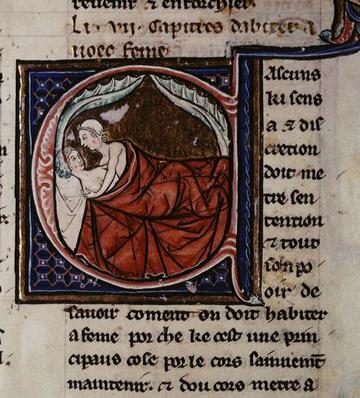
Sloane MS 2435, f. 9v. -British Library
In this all-male world, prostitutes were perennial, ever-tolerated (or at least, pragmatically accepted) court followers. During the reign of Henry II of England, one Ranulf de Broc held the office of ‘marshal of the whores of the royal household’. As Ruth Mazos Karras’s study, Common Women: Prostitution and Sexuality in Medieval England (Oxford University Press, 1998) shows, this legal regulation of prostitution was not unusual. Seen as a necessary outlet for otherwise unruly male desires, licensed brothels or ‘stews’ could be found in England, just as they were established across medieval Europe- especially in port towns such as Sandwich in Kent, or Southampton in Hampshire. In London, the red light district area was the suburb of Southwark, within the legal liberty of the bishop of Winchester. Prostitutes in Southwark were known as ‘the bishop of Winchester’s geese’.
Museé Condé, September
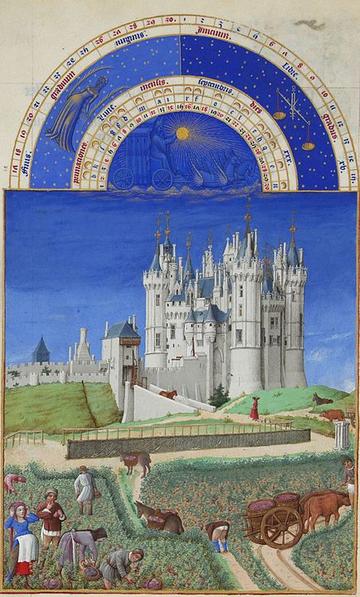
Regulation went hand in hand with ‘crackdowns’ and exclusion. In 1318, Edward II issued ordinances against prostitutes at court. A ‘bawd’ caught a third time within the legal vicinity of the court (known as ‘the verge of the court’) would be imprisoned for forty days.
Yet the rulings had little effect- in 1370, a marshal of the court prostitutes was again appointed. He was licenced to take four pence in ‘tax’ a week from each whore following the court.
As we saw in the 'Marriage at Court' posts, matters of romance were not always plain sailing... In the first of a series of posts on 'Sex at Court', Laura Slater looks at some notable examples of marital breakdown and adultery in medieval England.

British Library Stowe 17 f. 143
While a happy medieval marriage was possible, just like today, marriages could also break down. Joan, the ‘fair maid of Kent’, was the daughter of Edmund of Woodstock (d.1330, one of the younger sons of Edward I), and she spent much of her childhood in the household of Queen Philippa of Hainault. Over the winter of 1340-1341, when she was around twelve or thirteen years old, she was married to Sir William Montagu, the son of the earl of Salisbury, who was one of Edward III’s best friends. The grand alliance of Montagu with this ‘spare’ Plantagenet daughter shows the power of marriage as a form of courtly reward for loyal royal service. Yet in 1347, Montagu’s steward Sir Thomas Holland opened proceedings at the papal court in Avignon, claiming that he had already married Joan in secret, (making ‘a clandestine marriage’) in spring 1340.
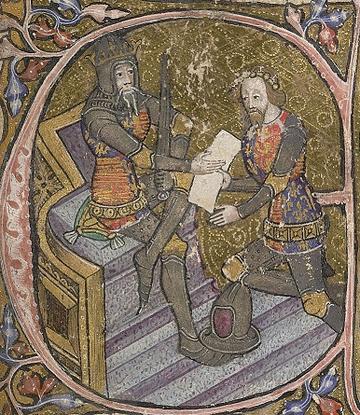
The 'Black Prince' in British Library - Cotton MS Nero D VI, f.3
Now that he was a wealthy man thanks to the profits of fighting at the battle of Crécy, Thomas Holland could afford to marry for love, and the historian Michael Bennett suggests that the story of the clandestine marriage might have been a convenient legal fiction*. It's possible that by 1347 the Montagu marriage may have broken down, with Joan embarking on an affair with Holland, her husband’s steward. However, the idea of a premarriage saved the honour of all parties. Once widowed, Joan would go on to marry her cousin the Black Prince, the eldest son of Edward III, in 1361. This marriage must again have been a love match, for negotiations had been underway to marry Prince Edward to a more suitable bride, Margaret of Flanders- the kind of strategic royal union that cemented diplomatic and trading alliances. In later life, Joan was referred to sarcastically as ‘the Virgin of Kent’, and seems to have ended up with something of a reputation for loose living. In the Peasants’ Revolt of 1381, the peasants who invaded the Tower of London made (sadly unrecorded) ‘ribald remarks’ to the dowager princess, and even, most disrespectfully, invited her to kiss them.
*see Bennett's essay ‘Honi soit qui mal y pense: Adultery and Anxieties about Paternity in Late Medieval England’

British Library - Royal MS 15 E VI, f. 6r
Less happy than Joan's love matches is the story of the prolonged marital breakdown between John de Warenne, the seventh earl of Surrey, and his wife Joan of Bar. Joan was the daughter of the Count of Bar in northeast France, and a granddaughter of Edward I - a great political match for John. When they wed in 1306, John was around twenty. Joan was probably below the age of ten. While this was not an unusual age gap for the period, the marriage proved unhappy and childless.
By June 1313, Joan was living in the Tower of London, supported by her uncle, Edward II. Warenne was living with his mistress, Maud Nereford- a deed for which he was excommunicated by the bishop of Chichester. Lengthy legal battles followed, for Warenne wanted to dissolve his marriage to Joan, marry Maud and legitimise his two Nereford sons. By 1316, Joan had departed for her native France. All Warenne’s legal efforts to dissolve his marriage were unsuccessful, and his two sons by Maud Nereford eventually joined the Hospitaller order.
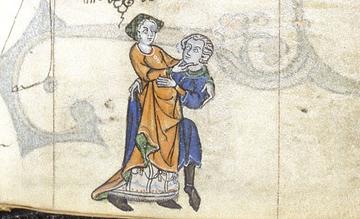
British Library - Royal MS 6 E VII, f. 150r
The couple may have reconciled in the 1320s, but in 1337, Joan returned to France with her household. By the 1340s, Warenne had another mistress, Isabella Holland, the daughter of a leading knightly follower of the earl of Lancaster. His will refers to her as ‘my companion’. When John died in 1347, he had at least six illegitimate children. All were left gifts and bequests in his will, but Joan received nothing.
Perhaps unsurprisingly after such a difficult experience, Joan didn’t marry again, living as a widow until her own death in 1361.

(banner picture from British Library, Stowe MS 955, f.13r. 'Friendly Expression' and 'Courteous Manner' catch hearts in their net)
A few months ago the Archivio Segreto Vaticano opened again after their traditional summer break, to the delight of the scholars that regularly gather there in search of unknown, interesting, surprising, or shocking documents. The archives are surrounded by an air of mystery, created partly by their name – the Vatican Secret Archives. Christophe, a veteran of the archive who will soon be travelling back for MALMECC, remembers his first visit…
The first time I went to the Vatican was during the last year of my PhD thesis. I must admit that despite having visited a number of archives before that, I was very intimidated. It was the Vatican after all! Thankfully I had been briefed by an expert of the Archivio on how to do it right.
Porta Sant'Anna, Vatican City (Mattes)

As students are not usually allowed in, there is quite a list of documents to bring - a letter explaining why you wish to access the Archivio, a
recommendation letter signed by your supervisor, proof that you have graduated (ideally a copy of your certificate), and a copy of your passport. Then, you go to the Santa Anna gate, to the right of Bernini’s famous colonnade, and explain to the Swiss guards, (yes, the real Swiss Guards, who are unfortunately not dressed in their colourful uniforms), why you are there. The most important thing is that they don’t think that you are just another tourist looking for the Vatican Museum! There is a sign just next to the door indicating the way to the Museum, which points totally in the opposite direction, but it nevertheless seems to be invisible to some… Once through the Santa Anna gate, you have entered the Vatican, and are likely to come across more cardinals, archbishops, monks and nuns than you have ever seen before!
Swiss Guardsman (Simone Casadei)
Don’t relax just yet - getting past the Swiss guardsman was just the beginning. Then come the local carabinieri. As a state, the Vatican City has its own police force. You have to explain to them, again, why you are there. In Italian, like everywhere else. They will show you the way to a small office where you have to hand over your ID or passport in exchange for a temporary visitor card (once you have your actual reader card, you can bypass that step). Then you keep on walking until you reach a third keep, where you are asked to show your card before walking through the Belvedere courtyard and finally accessing the Archives.

There, you will meet the academic equivalent of the Swiss guardsman - one of the archivists - who will ask you all about you: name, university, research subject, recommendation letter, requested documents, duration of your research stay… After that you will be asked to leave your bag and everything except what you need to take notes—not photographs—in the cloakroom and go upstairs to the reading rooms. Once there, you are almost done. Just drop the locker key to the archivists sitting behind the banco, write down your name and hour of arrival and sign the register, and order the documents you are here to see. “As simple as that”, I was told! In fact, while it seems like a lot of procedures, it’s actually quite logical and mechanical in the end. Once you are used to it, you might even inadvertently try to enter the Santa Anna gate without showing your reader card…
Research in the Archivio is often a treasure hunt. You can have a relatively clear idea of your itinerary and what you expect to find, but you will never have a clear idea of all that you could find - sources are so numerous and varied that it is hardly possible to have an idea of how far they extend.
Belvedere Square
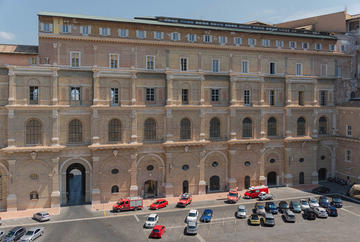
What really matters for researchers is not this all of this ceremony, but what is to be found in the Archives. The wealth of their collections is amazing.
Papal letters, account books, and diplomatic documents, to name but a few. More or less catalogued or inventoried, barely digitalized, you are neither allowed to photograph them, nor to see more than three volumes in one day. Research in the Archivio is often a treasure hunt. You can have a relatively clear idea of your itinerary and what you expect to find, but you will never have a clear idea of all that you could find - sources are so numerous and varied that it is hardly possible to have an idea of how far they extend. Luckily, you will find scholars who have been going there for years, some since they were writing their DPhil, who will be more than happy to share what they have found and suggest new collections to search. Of course, you cannot talk out loud with them in the reading rooms, but there is a garden, and a cheap but delicious cafeteria, where you can – and should - gather to exchange ideas, ask questions or give answers in a relaxed way. That is where the real social life of the Archivio happens, and also what makes the community of Archivio users so special. You don’t just go there to develop your research through reading, but to also move it forward through discussion over coffee. That has to be the ideal way of doing things!
Banner image courtesy of Patrick Landy

Christophe Masson (the lead on the 'Ecclesiastical Courts as Cultural Hubs' sub-project) looks at one of the most fraught periods of papal history to explain why there is a memorial inscription to 'the former pope John XXIII' in a medieval Florentine church.
When in Florence, you are permanently overwhelmed by art, and also, less enjoyably, by cohorts of badly-behaved tourists. Nevertheless, almost every street, square, corner or church should be visited, because there is so much to see: paintings, sculptures, manuscripts, astonishing pieces of architecture... It feels like you are outside time and away from the ordinary political concerns of the world. In fact, a lot of what you see displays a political message. The equestrian statue of Cosimo I of Medici is one well-known example, but the same could be said of the replica of Michelangelo’s David or the high tower of the Palazzo della Signoria. All of these pieces are not just beautiful, but meaningful.
In front of the cathedral and its exceptional dome stands the baptistry, where you may have been baptized, had you been born in the Middle Ages. Figures of Christ, Mary, and the apostles are on the ceiling, portrayed in one of the most marvelous thirteenth century mosaics conserved today.
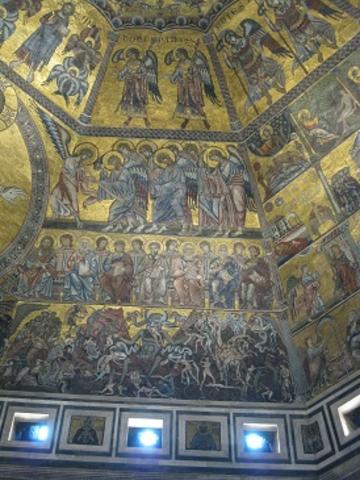
The baptistry of San Giovanni
Also in the baptistry, almost, but artistically, squeezed between two antique Roman columns, is a medieval tomb. Lying there at peace is a churchman, watched over by the Virgin and baby Jesus. But his epitaph might strike the reader as odd - Joannes quondam papa XXIII? The once pope John XXIII? Wasn’t pope John XXIII elected in 1958, before dying in 1963 and becoming canonized in 2014? In fact, this inscription refers to the 15th Century pope of the same name, and the explanation lies deep in the complex world of pontifical politics.
The tomb of antipope John XXIII
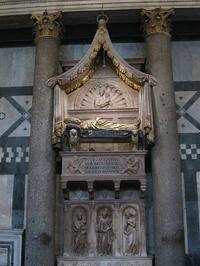
At the end of the Middle Ages, the Church experienced some of its worst days. Expelled from Rome and taken to the Rhône Valley by the French king
Philipp IV the Fair, the papacy settled in Avignon. There, it developed its administration to a point never experienced before, profiting from pontifical taxation and the seizure of local ecclesiastical charges. But, in the meantime, people wondered why the popes were not returning to Rome where they belonged. Finally, in the late 1370s, they settled back. For a moment. Almost as soon as they elected a new pope, Urban VI, the cardinals faced his hard-tempered manner and concluded that the election—held under intense external pressure and terrible conditions—was not valid, electing Clement VII instead. After a failed attempt at crushing Urban’s military forces, Clement made his way back to Avignon, where he died in 1394. Two popes were fighting, and Europe was divided between obedience to Rome and Avignon.
Antipope Alexander V
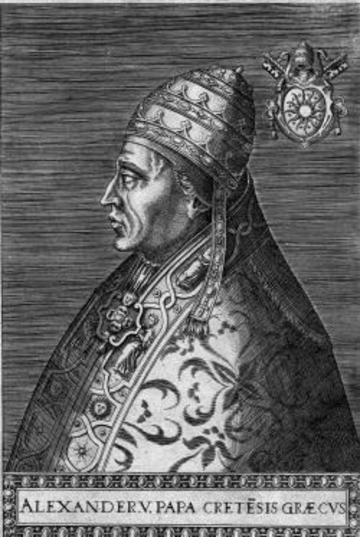
In 1409, exhausted by what they considered a dead end, several cardinals, theologians, prelates, princes decided to hold a council in Pisa, to solve what is now known as the Great Western Schism. They elected a new pope, Alexander V, But the other two existing popes, Benedict XIII (Avignon line) and Gregory XII (Roman line), refused to capitulate. Alexander (the first pope of the Pisan line), was succeeded by Baldassare Cossa, a Neapolitan churchman who was one of the main characters of the Pisan council.
He was a fighting pope, who was known before his election for his effective, yet harsh, manner. He ruled the Romagna province from Bologna and defeated several more Roman adversaries in Northern Italy. Having taken the name of John XXIII, he took Rome in 1410, signed alliances with some of the main rulers of Western Europe, and condemned the heresy of Jan Hus and John Wyclif, gaining, albeit briefly, the position that in those days was expected to be the Pope’s. But the odds were against him. With too many enemies (mainly Ladislas of Duras, the king of Naples, and the king of the Romans and future emperor Sigismund of Luxemburg) and not enough supporters, he finally had to leave Rome.
Baldassare Cossa, Antipope John XXIII
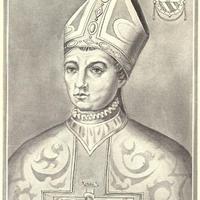
When a new council opened in Constance, he joined it, only to resign his papacy. Truth be told, he had no other choice. Seized by some of his fiercest opponents, he confessed his faults and resigned the papal tiara, leaving for four years of captivity in the Empire. In 1419, finally freed, he met the new, and only, pope, Martin V. He was on the move to regain a position of importance in Italian politics when he died in Florence, on the 27th December of that year.
The Medici, whom he had helped to enter the pontifical financial administration, and thus to make lots of profits, paid him back, so to say, by ordering his tomb from two of their best artists: Donatello and Michelozzo. It remains a masterpiece of the early Renaissance and a testimony to the interest of Florence in pontifical matters. One century later, that same Medici family would have given two popes to the Christian world…
Additional image of interest: J. Paul Getty Museum -
Master of the Getty Froissart (Flemish, active about 1475 - 1485), Pope Urban VI and the Anti-Pope Clement VII, about 1480 - 1483,
In the final part of her series of blogs on 'Marriage at Court', Laura Slater shows that privacy was a rare thing in aristocratic marriages, but that affection was still possible.
So what happened once you were married in the courts of medieval Europe? The Victorian idea of ‘separate spheres’- men dominating the public world of work and politics, women responsible for the private, domestic life of home and children- does not apply in the Middle Ages. We cannot make a clear distinction between the public and the private, or even between work and home.
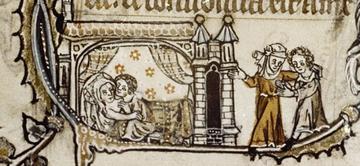
(Bodleian MS Douce 6, f.160v)
Aristocratic men and women lived their entire lives in public. Although they could retreat to more private chambers, surrounded only by trusted servants and intimate friends, they were almost never alone. If you were sleeping with your spouse (or someone else), your servants and guards always knew about it. Some servants slept in their master or mistress’s bedroom, or even in bed with them, as a matter of course. Whether you were dining happily with your spouse, at prayer together, suffering from insomnia or having a row, somebody, somewhere, always knew about it. And knowledge was power. Strangers to the court wanting to make a good first impression, or get a successful answer to their request, would pay handsomely to know what topics to avoid or emphasise in conversation with the king or queen, to make sure such meetings went well.

(Museé Condé, MS 65, f.1v)
So your ‘private’ married life could become very public. And your ‘private’ home was never closed to strangers. The noble household was a centre of business and administration, flocked to by public visitors and petitioners. Lavish feasts and entertainments, generous hospitality, the giving of alms and other forms of charity were integral to day-to-day public business. By showing off how rich, powerful and important you were, you could become even more so.
Noble landed possessions might be scattered across different territories, so managing those estates- not just accounting for their yields, livestock and crops, but sometimes physically making sure that your family or your tenants were still in possession of disputed manors- could mean long journeys across different areas of a kingdom by both husband and wife, just to keep track of everything.
Whatever their age or gender, medieval aristocrats were expected to rule- to make decisions, issue orders and give commands. A successful working partnership might be all either party expected from some unions.
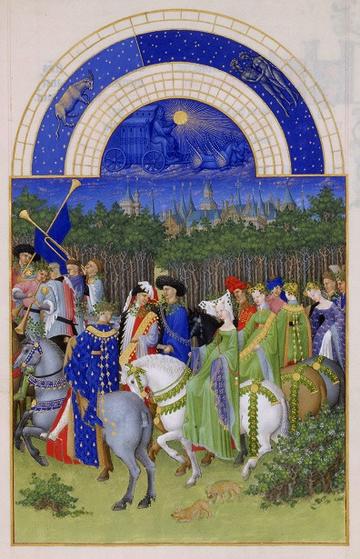
(Museé Condé, MS 65, f.5v) - May
In these images from the famous c. 1412-1416 Très Riches Heures, made for Duc de Berry, one of the sons of King Jean II of France, we can see his Paris residence, the Hôtel de Nesle, in the background of the calendar page for May. In April, another residence can be seen in the background: the Château de Dourdan. The reality of married life for aristocrats was an endless circuit of travel, from palace to manor to court.
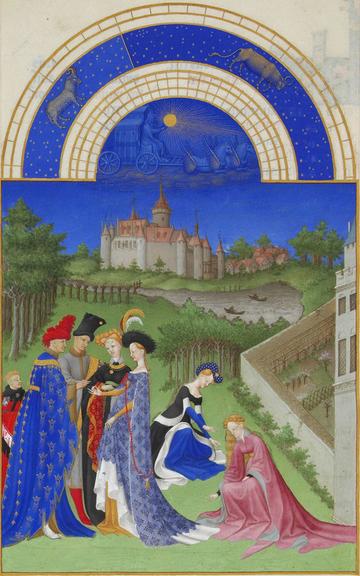
(Museé Condé, MS 65, f.4v) - April
A young noblewoman who had been married at twelve or thirteen to a man thirty years older than her would still be expected to start playing her role in the management of the family wealth, household and estates. And apart from her own personal servants, the rest of the household staff were almost certainly male. Whatever their age or gender, medieval aristocrats were expected to rule- to make decisions, issue orders and give commands. A successful working partnership might be all either party expected from some unions.
But love and affection certainly developed between some couples. Edward III and Philippa of Hainault’s union was a matter of diplomatic expediency on the part of Edward’s mother, Isabella of France. But the couple went on to enjoy an extremely happy and harmonious marriage, with Philippa giving birth to twelve children. The couple travelled together and spent most of their time together, frequently sending each other gifts. In their few surviving letters, Edward repeatedly addresses his wife as douce cuer (‘sweetheart’). So although love at the medieval court was rarely private, it was at least possible.
Many thanks to Laura for this interesting series on medieval courtly marriages. If you haven't read them yet, do take a look at the previous entries, and let us know what you think.
In the second part of her 'Marriage at Court' series, Laura looks at the pressures faced by young royal brides to start paying their 'marital debt', and its potentially life-threatening consequences.

Samson recovers his wife (Queen Mary Psalter, BL MS Royal 2 BVII, f.45r)
Royal princesses usually journeyed to meet their future husbands with a grand household, attended by many of the family’s most trusted servants. But most, if not all, of this entourage would be required to formally depart: sometimes at a mid-point between the kingdoms, sometimes a few weeks or months after the wedding itself. Left alone in a foreign country, and perhaps not yet speaking its language, it could be very difficult for a young bride to resist starting to pay her ‘marriage debt’. This medieval term for conjugal relations brings us back to the transactional nature of such alliances. The modern marriage ceremony still includes the words, ‘to have and to hold’. It might sound romantic, but the phrase habendum et tenendum is found in every medieval deed marking the transfer of property between two owners.
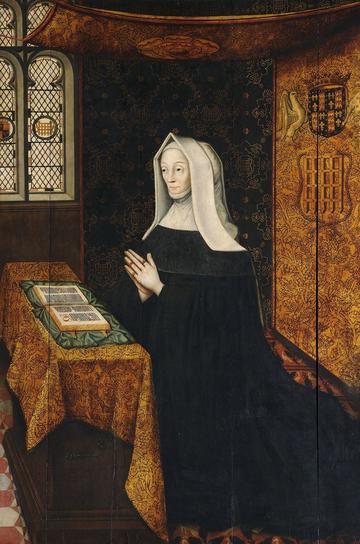
'Lady Margaret Beaufort at prayer', by Rowland Lockey, St John's College, Cambridge.
When Richard II agreed to marry a seven-year-old French princess, neither he nor anyone else was expecting him to start having full sexual relations with his new wife. He would have to wait until Isabella was of full adult age, which medieval canonists placed at between the ages of 12 and 14, the age when infancia ended and adolescentia began. In an era when you could be classed as ‘old’ by thirty, teenage pregnancies were positively encouraged. Yet childbirth was a dangerous business in the Middle Ages. Not all twelve or fourteen year olds might be physically mature enough to safely carry a pregnancy to its full term. Margaret Beaufort gave birth to Henry Tudor when she was thirteen (and already married to her second husband, who was twelve years older than her). It is possible that she was seriously injured in the process, for despite two more husbands, she never had another child.
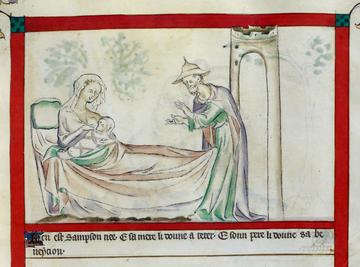
Queen Mary Psalter, BL MS Royal 2 B VII f. 43r
Eleanor of Castile, the wife of Edward I, also gave birth to her first child when she was thirteen. Although she went on to have many more children, she also seems to have found the experience a troubling one - for when it came to the marriage of her own royal daughters, she was extremely reluctant to let them leave the safety of their father’s court until they were past their early teens. She probably knew from experience that royal brides could be put under intense pressure to start producing the all-important royal heir.
In the first of a three-part series on 'Marriage at Court', researcher Laura Slater explains how aristocratic marriages were brokered, and how love was mostly for the lower orders of society.
Henry and Catherine -
Vasari, 1550 fresco in the ‘Sala di Clemente VII’, Palazzo Vecchio

The medieval court was a great marriage market. Royal and aristocratic marriages were not about love and affection, but politics and power.
Noble unions were strategic alliances, carefully calculated to maximise wealth and power, to preserve particular territories or enhance a family’s social and political position. Royal marriages might be intended to make peace between warring nations, bolster the shaky position of a new dynasty on the throne, or renew a longstanding diplomatic alliance.
Dynasties liked to glory in their noble ancestry- many European aristocrats boasted of a descent from Charlemagne, for example. Marriage to a social inferior (known as disparagement) was thought to permanently taint an aristocratic bloodline. When the future Henry II of France married Catherine de Medici in 1533, many sneered at the union of the ancient royal house of Valois with the daughter of an upstart ducal dynasty of rich Florentine merchants and bankers.
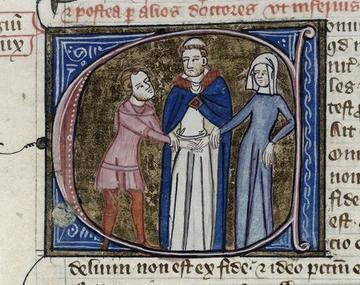
BL MS Royal 6 E VI, f. 375r.
One of the slogans of the 1381 Peasants’ Revolt directly attacked the noble obsession with lineage, pointing out humanity’s common ancestry: ‘When Adam delved and Eve span/ Who was then the gentleman?’
The English king held legal rights of marriage over widows and wards (children who inherited their lands when still underage), which he could use, sell or give away as favours as he pleased. A widow who wanted to avoid marrying again would have to buy the right to do so from the king. But if she was a great heiress, and her marriage rights had been granted to a courtly favourite in need of a grand estate, it might be very difficult to avoid marrying him. Similarly, young children whose estates were in the keeping of a guardian might also be obliged to marry their guardian’s son or daughter.
Richard II and his young wife Isabella (BL MS Royal 14 D VI, f.268v)
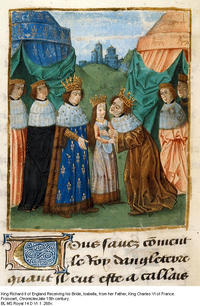
In theory, a medieval marriage wasn’t valid unless both parties had freely consented to it. But in the world of the court, where marriage was a matter of public business rather than private affection, few expected to have a completely free choice over their future spouse. St Augustine defined marriage not by its consummation, but by ‘affections of the mind’. This ‘sacramental’ view of marriage saw mutual love between the couple as both sign and substance of God’s grace. It became increasingly popular in late medieval Europe.
But love was for the little people…at court, marriages could be brokered at such a young age, ideas of mutual support and affection would have seemed extremely remote. Margaret Beaufort, mother of the future Henry VII of England, was betrothed to her first husband when she was between the ages of one and three. In 1397, Isabella of Valois married Richard II and became queen of England at the age of just seven. Richard’s wedding presents to his wife included a set of dolls.
In our next post, find out about the dangerous business of medieval childbirth, and just when you were expected to pay your 'marital debt'. . .
Blogs 09 2016 - 07 2017
Laura gives a researcher's perspective on what it's like to attend the largest medieval studies conference of its kind in Europe.

from www.leeds.ac.uk
From 3rd-6th July, I attended the 24th International Medieval Congress at the University of Leeds. I have been attending the Leeds IMC for several years now. The conference used to be held at a now-demolished block of university residences and classrooms towards the north of Leeds, in Adel. A colleague liked to call it ‘medieval boarding school’, but there was an interesting 1150-1170 parish church to go and visit whenever you started getting cabin fever.
Norman door ring from nearby Adel parish church - John Wray

Since moving to the city centre, Leeds has only got bigger - more talks, more delegates and more round tables, events and field trips. These days, the final day of the conference is marked by a celebration of all things medieval.
So what keeps me coming back year after year? I find Leeds is a great way to keep in touch with the range and variety of work being done in the different areas of my research interests. In sessions sponsored by research networks and societies such as the Society for Fourteenth-Century Studies, I can meet PhD students and early career researchers, and find out about unpublished work that is still-in-progress. I can also meet archivists and scholars working outside universities, in places such as the London Inns of Court or the History of Parliament Trust.
The internationalism of Leeds is also a major draw. Research projects from across the globe come to sponsor panels and sessions and present on their work at the IMC. In just a few days in the same place, I can find out about interesting research projects that I might never hear about otherwise.
Plato, Seneca, Aristotle. 14th Century (MS Hunter 231)
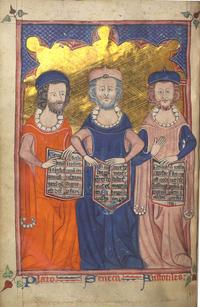
A longer-term benefit of going to Leeds is the improved ‘general knowledge’ of medieval studies you gradually acquire.
Dropping in on interesting-sounding sessions that are completely outside your research area, and listening to papers on Carolingian clerics or medieval Ethiopia, is a great way to keep your intellectual horizons open. Some of the specialist insights and approaches found in these papers can be applied to your own work, or they may inspire something new.I also get to appreciate the breadth of medieval scholarship as a whole. Turning to a random page in the conference programme, there is a choice between papers on ‘Byzantines and Seljuks on the Roads of Central Anatolia’, ‘Arabic Love Poetry at the Norman Court of Palermo’ and ‘Middle English Hippiatric Treatises'.
They also enrich your teaching, for academics never teach only on the subjects that they research and write about. A paper heard at Leeds on very specific details of pilgrimage to Rome, for example, may suddenly come in useful if you are asked to teach an introduction to the medieval cult of saints and relics. It also means that your students will get taught the latest research and thinking on a topic, even if they might not realise it. They are more likely to think what a strange person you are for knowing such obscure facts…
In the second part of his blog set on political infighting in ecclesiastical courts, David Murray discusses factions, revenge, and nepotism.
Lucan famously wrote in his Pharsalia ‘Exeat aula qui volt esse pius; virtus et summa potestas non coeunt’ (‘Leave the court if you want to be virtuous, for virtue and great power do not go together’). Quoted in the twelfth-century philosopher and churchman John of Salisbury’s Polycraticus, this advice clearly struck a chord in the medieval world. Court criticism certainly colours much of the literature of the time and beyond. Think of the digs, sly and otherwise, that are so often made about King Arthur’s court in romances from the dawn of the genre in the twelfth century all the way up to Mark Twain’s A Connecticut Yankee in King Arthur’s Court.
‘Leave the court if you want to be virtuous,
for virtue and great power do not go together’
An institution that ‘hangs’ around one person, and where preferment depends on seeking the favour and presence of that one person will inevitably give rise to in-fighting. And ecclesiastical courts are no different.
As I mentioned in my last post, the election of Gregor Schenk von Osterwitz as the provost in Salzburg in 1386 is a perfect example of revenge being a dish best served cold. It came to the rage of Ortolf von Ovenstetten who expected to succeed his own brother, the previous incumbent. The Archbishop of the time, Pilgrim von Puecheim, had been waiting for two decades to side-line the Ovenstetten brothers and their friends—his enemies—in Bavaria. This, however, is to look at the affair only from the side of the Bavarian faction. Seen from the other side of the divide, it was merely Gregor Schenk von Osterwitz’s reward for long service. He had, after all, spent a decade as scholaster from 1371-1382, after arriving in Salzburg from the college of canons at Arnsdorf near Dresden.
The rewards (just desserts or otherwise) did not end there; Gregor was elected Prince-Archbishop on Pilgrim’s death in April 1396. This was certainly not surprising, though may well have raised eyebrows (or, more likely, hollow laughs) among the locals in the Getreidegasse. This is because, the year before, a Papal order commanded Pilgrim to investigate Gregor for falsely imprisoning two men, Dietling Pellendorf and Rudolf Turs. Pilgrim, always a loyal servant of the pope (in this case Boniface IX), appointed an investigator. By an extraordinary coincidence the investigator happened also to be his nephew—what are the chances of that? So perhaps Gregor’s rise was not so resistible. Gregor was certainly not forgiving about the episode: when he was elected Archbishop, the canon who delivered the papal letter, Friedrich von Pernegg, was sent on extended gardening leave at the universities of Vienna and Prague.
Given that, in my own field of literary studies at least, much of our perception of the court comes from the secular world, one is often tempted to think things might be rather different at an ecclesiastical court. The machinations of the canons at Salzburg rapidly disabuse of the reality that this was far from the case. This all leaves us asking more questions: what exactly is it (if anything at all) that makes the ecclesiastical court different?
Even if the ruler did not inherit his position from his father, there is still evidently a place for heredity—just think about Ortolf von Ovenstetten’s expectations of succeeding his brother—as well as nepotism. Pilgrim the Prince-Archbishop had a particular flair for this, and managed to place two of his nephews (not the one who investigated his successor, though) as suffragan bishops in Chiemsee and Seckau. Perhaps the long view is important here: where a king can dismiss lackeys with relative ease, a bishop, abbot or other churchman is part of a fixed hierarchy, where there is always a higher instance, normally Rome. Sometimes, in more political affairs, local rulers and the Empire too. Then, of course, there’s God too…
In our latest 'Meet the Researchers' slot, resident art historian Laura talks source material, 'women's history', and the space between power struggles.
You’re the art historian on the project, so what sort of questions are you asking of the source material?
The American painter Edward Hopper supposedly said: ‘If you could say it in words, there would be no reason to paint’. I think it’s always a useful starting point to ask: what can this image suggest, or explain, or reveal, that a textual document cannot? For my project on Queen Philippa, we can look at official records of her property transactions and her gifts to servants and petitioners. But there are very few surviving household accounts that tell us what the queen actually did all day, or what she enjoyed on a cultural and intellectual level. Looking at the manuscripts she owned can give us an insight into Philippa’s wider interests, and a window into her more ‘private’, devotional and emotional world. We can consider Philippa as a thinking and feeling human being, as well assessing her on a public and political level as a queen of England, a wealthy and powerful landowner and a member of a pan-European aristocratic elite. The images found in Philippa’s manuscripts are not simply ‘illustrations’, but a unique form of historical evidence.
The role of women in history had quite a renaissance in different historical disciplines a while back. Do you think this trend is continuing?
‘Women’s history’ (formerly put in inverted commas) may have been a new and fashionable historical subject in the seventies, and it clearly developed alongside what was seen then as new and radical feminist theories.
If you don’t think that women matter, then of course, their histories won’t matter to you either.
But these histories (and many others), are still there to be explored
Decades later, the study of women is firmly established across the different disciplines that make up the arts and humanities. We cannot understand the past if we are only studying a small subsection of its population. This doesn’t only apply to women, of course. And privilege still matters. Philippa might do many similar things to other aristocrats, but as a queen, she is exceptional even in an elite context. And her life was very, very different to the lives of the vast majority of medieval women.
So how do you investigate Philippa's life?
Getting a more complete social picture of the past can be difficult due to the nature of the surviving source material. Philippa’s husband, Edward III, for example, seems to go around doing lots of things: signing letters, giving orders, waging war and travelling about.
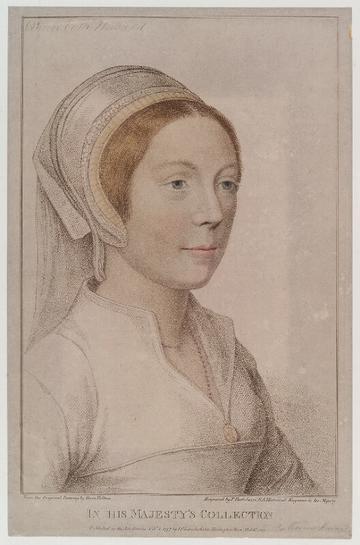
Unknown woman engraved as Catherine Howard (NPG D20279) © National Portrait Gallery, London
This leads to a lot more paperwork in his name, and a lot more historical sources to investigate. Similarly, just as journalists today are much more interested writing about the prime minister than an ordinary person, the historical chroniclers of the time were also focussed on what the king, rather than the queen, was doing. This can leave the impression that the queen was not really doing much at all, beyond having babies and perhaps making the occasional ceremonial appearance at court, giving out gifts and favours. Philippa was certainly doing things, but the vast majority of these activities were enacted, recorded and accounted for in her husband’s name. The result is that the only activities we seem to see Philippa doing are those distinctively female activities (such as childbirth) that cannot be credited to anyone else. So studying women’s history is in part a matter of looking at all the available historical sources from a different perspective- asking not just ‘what happened?’ but ‘whose viewpoint are we seeing here?’ And there remains a political aspect to it. If you don’t think that women matter, then of course, their histories won’t matter to you either. But these histories (and many others) are still there to be explored and investigated, even if the evidence for them may sometimes be more fragmentary than we’d like.
How would you explain the MALMECC project to interested members of the general public?
I would say that the MALMECC project is about exploring the world of medieval European courts as a whole.
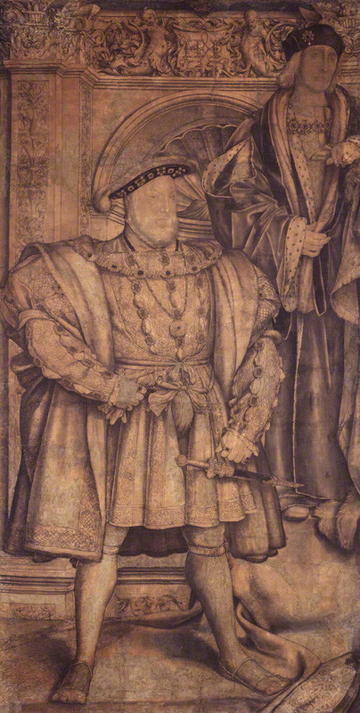
King Henry VIII by Hans Holbein the Younger (NPG 4027) © National Portrait Gallery, London
If we were thinking about ‘culture’ at court, and perhaps considering art, books and music in turn, before assessing the court as a political institution or social environment, as researchers we would be completely missing the point of ‘life at court’ in the Middle Ages and beyond, which is the interplay and interactions between all these different elements.
To take a later example. The fifth wife of Henry VIII of England, Catherine Howard, may have started a romance with Thomas Culpeper around 1540. They attended the same court functions, such as the May Day tournaments, or when she gave out gifts and favours on Maundy Thursday. And as Culpeper had been a gentleman of the Privy Chamber since 1537, in close personal attendance on the king, there were other opportunities for them to meet, and lots of plausible reasons for him to be passing in and out of the queen’s chamber, receiving letters from her, or dealing with her servants. So the social and cultural life of the Tudor court cannot be separated from the political upheavals and faction fights it fostered. And as Henry VIII aged, the fates of his friends, wives and ministers depended more and more on the king’s mood. If the king had been up late feasting the night before, and was now feeling tired and irritable, who knows what might happen? This is why court culture can matter so much- there is more to it than the space in between the power struggles.
What’s the most exciting thing about the project for you?
For me, the musical aspect of the project is particularly new and exciting. While I’m a very interdisciplinary medievalist, this is not an area I’ve engaged with before. It’s proving to be a very interesting learning curve! Because art historians usually view manuscripts and artefacts in the silence of a library reading room or museum collections room, I also think it can be too easy to ignore the sonic dimensions and performative aspects of these objects. MALMECC ensures that these elements are at the centre of our analysis.
The second exciting element of the MALMECC project is its transnationalism. It’s easy to focus on Philippa simply as ‘the queen of England’, but much more valuable to think of her as a transnational courtly figure. Philippa remained in close touch with her natal family, and her continuing links with the Low Countries were crucial to Edward III’s diplomatic efforts throughout the Hundred Years’ War. Philippa gave birth to two of her children in the Low Countries (Lionel of Antwerp and John of Gaunt, or Ghent) and travelled abroad regularly with her husband. Thinking about her cultural patronage from this transnational perspective is especially useful.
What are your interests outside of academia?
I enjoy yoga, going for walks in the countryside and now I’m getting more settled in Oxford, I’m hoping to start riding horses again.
In the latest MALMECC blogpost, our literature scholar David Murray talks about political wheezes and back-stabbing in the reign of Pilgrim von Puecheim. David is working on the subproject ‘The “Monk” and the Prince: Court Culture and Song in Late-Medieval Salzburg'
I recently heard a senior medievalist observe, ‘When I was a graduate student, we didn’t have the internet. We had Germans instead.’ The thought often comes to mind when flicking through vast series like the Monumenta or dictionaries like Friedrich von Wartburg’s Französisches Etymologisches Wörterbuch. At the other end of the scale sit smaller works of intellectual and technical intricacy. Indeed one of my most recent scholarly debts falls at this end of the chart. My gratitude is due to two Austrian scholars, now long dead, Hans Wagner and Herbert Klein who, in 1953, scraped together everything known about the members of Salzburg’s secular clergy. Put in such bald terms, it hardly sounds promising. However, an elaborate game of hide and seek in the civic archives leads one through several hundred years of political wheezes and back-stabbing. A particular highpoint for skulduggery seems to have been the reign of Pilgrim II von Puecheim (1365-96).
The 1321 font in Salzburg cathedral, resting on lions from c. 1180 is all that remains of the medieval building the Ovenstettens and Pilgrim knew, which was irreparably damaged by snow and rain after a fire in December 1598. See website for images www.salzburger-dom.at
The writing was, in a sense, on the wall from the start of his reign, when Pilgrim was imposed on the Domherren by the Pope in Avignon, to the considerable displeasure of two brothers, Eberhard and Ortolf von Ovenstetten. Eberhard, provost at the time, and a member of the community for the past three decades, had hoped that Ortolf would be elected as Prince-Archbishop. Add to this the fact that Pilgrim was allied with Clement VII in Avignon whereas the Ovenstettens’ Bavarian alliances led them to side with Urban VI in Rome, and it becomes more understandable why the next decades were so eventful. On top of all of this, when the young Pilgrim had been a student in Avignon, he had had to open legal proceedings to force Eberhard to pay him the income from his Salzburg benefice. Nothing worse than coming between a student and his beer money…
An uneasy peace was maintained for almost two decades (by 1377 Ortolf was a member of Pilgrim’s council) until the Salzburg
synod of 1380 when the Ovenstettens’ implacable devotion to Rome came to the surface again. (There was, incidentally, another Ovenstetten brother, Otto, who studied with Ortolf in Bologna. Nothing more is known of him, but one imagines him, rather like the third Attenborough brother, enjoying a quiet life and wondering why elder siblings are such a nuisance…)
Gold coin of Pilgrim II. The inscription refers to PILGRIMVS ARCHIEPISCOPVS - Archbishop Pilgrim. (Landesmuseum Württemberg)
Eberhard died in 1385, and Ortolf was duly elected, with a majority of 4-2, to succeed his brother. But in 1386, Gregor Schenk von Osterwitz was invested by the Prince-Archbishop as Provost, and the Salzburg Four fled to Bavaria. A series of begging letters from this Bavarian fraction bear witness to the uphill struggle to get back into Pilgrim’s good books. This was unsurprisingly hard work, since the figure-head of the faction, Friedrich, Duke of Bavaria, had taken Pilgrim prisoner in the Cistercian monastery at Raitenhaslach in 1387.
Ortolf seems to have made his peace with Pilgrim, and is recorded in Salzburg in 1390, where he died two years later.
Who needs House of Cards or The Thick of It when, thanks to Wagner and Klein, we have the Salzburg Domherren? In my next post, I’ll come back to the prodigal son, Gregor Schenk von Osterwitz, another ruthless politcal mover, and his inevitable rise.
On 27th-28th April 2017, the MALMECC project hosted its first workshop on: ‘Methodological Innovation in Late Medieval Studies’. Hosted by Wadham College, Oxford, a multidisciplinary group of medievalists from countries across Europe as well as North America joined us to debate new ways of approaching medieval sources and explore new methods of historical, art historical, literary and musicological investigation.
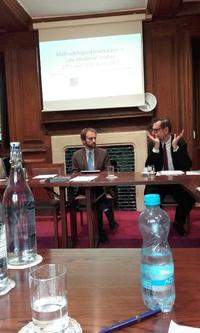
On Thursday morning, the workshop opened with a presentation from the MALMECC team, introducing the project in more detail and setting out some of the academic challenges facing us. This was followed by position papers from Elizabeth Eva Leach and Andrew Albin, sparking a lively debate about the extent to which medieval tournaments, plays and literary fictions ‘straddled’ the boundary between daily life and the imagined worlds of courtly love, medieval drama and cultural game-playing or performance.
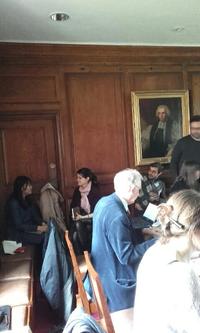
In the afternoon, Ruxandra Marinescu and Mary Carruthers encouraged discussion of the many
meanings and functions of rhetoric in medieval culture, considering the concept of ekphrasis and the creative value of perplexity in particular. The role of pictures and musical notation in manuscripts such as the Roman de Fauvel (Paris, Bibliothèque Nationale de France, MS Français 146), and the problems of performing such a complex, ‘multimedia’ work in a court context were carefully examined.
On Friday morning, John Harper introduced us to his fascinating ongoing research project, The Experience of Worship. We explored what the enactment of medieval liturgies and the recreation of medieval artefacts could reveal about the experience of worship in the medieval cathedral and parish church. Anna Kvičalová provided a Reformation-era perspective on pre-modern processes of seeing and hearing, discussing the new modes of listening that emerged in mid-sixteenth-century Geneva.
On the Friday afternoon, there was further discussion of the religious experiences of the laity and the role of the senses in medieval devotion.

Kathryn Rudy reviewed her investigations of the physical uses of medieval manuscripts by their users, including her use of a densitometer to measure the grime that original readers deposited in their books. Finally, Ursula Gießmann discussed the textiles of the papal court of Felix V in Basle and their place in ceremonial and performance.
Formal presentations were kept to a minimum to allow time for debate and discussion amongst all participants.
The insights and intellectual contributions of all attendees have enriched the MALMECC project enormously. We thank everybody for coming with such interest, enthusiasm and intellectual generosity, and the staff at Wadham for their invaluable assistance. We hope that this shared workshop experience proves as intellectually exciting and methodologically valuable for all its participants as it has done for the MALMECC team.
In the General Prologue of The Canterbury Tales, Geoffrey Chaucer introduces the worthy and virtuous Knight, as one who ‘loved chivalrie,/Trouthe [truth] and honour, fre[e]dom and curteisie [courtesy].’ (lines 45-46). He stresses the knight’s crusading heroics, saying that he had ridden ‘As wel in Cristendom as in hethenesse [heathen areas]’, fighting at ‘Alisaundre...whan it was wonne’. The dramatic capture of the Egyptian city of Alexandria in 1365 by Peter of Cyprus was one of the great crusading victories of the fourteenth century. The Knight was also present ‘In Gernade at the seege eek hadde he be/Of Algezir’, probably a reference to the 1344 siege of Algeciras. Going on to namecheck other famous crusading battles, Chaucer is making it clear to his audience that the Knight is a warrior to be greatly respected, who spent his youth engaged pious and honourable acts. As he was writing in the late 1380s, these past glories also underline the Knight’s great age.
Chaucer completes the Knight’s ‘greatest hits’ of glamorous and iconic crusading destinations when he tells us that:
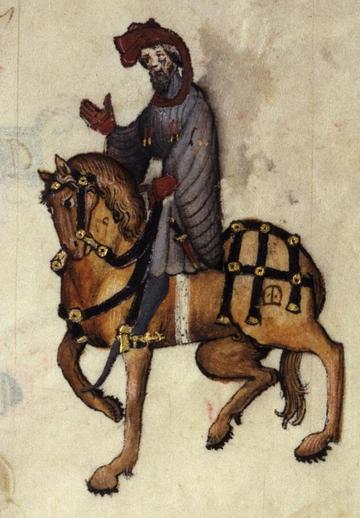
'The Knight' from the Ellesmere Chaucer, Huntington Library. EL 26 C 9 f.10
'Ful ofte tyme [often] he hadde the bord bigonne [sat in the place of honour]
Aboven alle nacions in Pruce [in Prussia]
In Lettow [Lithuania] hadde he reysed, and in Ruce
Chaucer’s original audience would have immediately understood the verb reysed, although the term is a Middle German one. The Reisen (journeys) were the seasonal campaigns conducted by the Teutonic Knights of Prussia in the ‘heathen’ Baltic regions and western Rus. The Teutonic Knights attracted enthusiastic volunteers from all across Europe, all arriving ready to fight (and so saving the Knights a great deal of money, as then they did not have to raise professional armies or buy expensive military equipment). In return, the Knights offered the perfect crusading package tour.

Marienburg Castle, built by the Teutonic Knights in Malbork, Poland - © Thomas Stegh
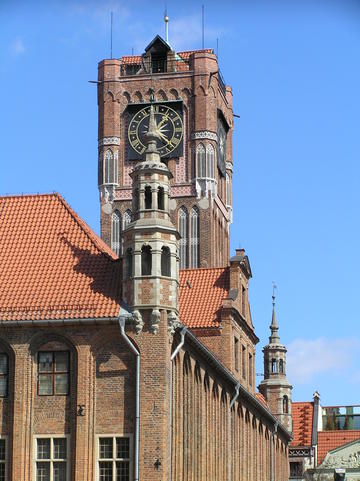
Old-Town Hall of Toruń, Poland. © Pko
You could stay for as little as a few weeks, or for months at time. The Knights provided guaranteed fighting against pagan ‘infidels’, so everybody could go back home and boast about their military exploits. In the frozen wastes of Lithuania in the winter, with even rivers and marshes iced over, it was impossible to fight pitched battles. Instead, short-term tactical raids or reysas were the order of the day. You could go out to fight for a few days or weeks, before returning to the warmth, safety, good food and on-site entertainment provided at the Order’s castles, especially at Königsberg (now Kaliningrad in Russia) or Riga (today the capital of Latvia). And if you didn’t fancy joining that day’s reyse, you might go hunting. Or you might go and visit a large town not too far away from the heathenesse: places like Marienberg (now Malbork in Poland), Thorn (now Toruń in Poland), Elbing (now Elbląg in Poland) or Danzig (now Gdańsk in Poland). All of these towns were large and thriving centres.
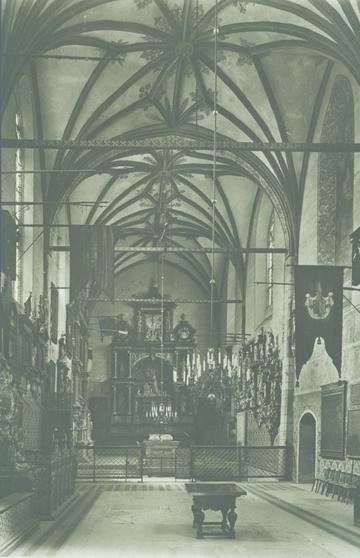
The choir of Konigsberg Cathedral, now situated in Kaliningrad, Russia
You might visit only to buy horses and supplies for your next reyse. But you could just as easily go shopping for luxury goods and souvenirs. Or you might spend some time visiting shrines and churches, such as St Mary in Königsberg, full of memorials to nobles killed on the reyse. Piety was an important part of the reyse, with most crusaders attending daily Masses. The Teutonic Knights organised their reysen not only for when the terrain was passable, but around the major feasts of their patroness, the Virgin Mary, such as the feast of her Purification (2nd February).

Reliquary made in Elbing in 1388 for Teutonic komtur Thiele von Lorich - © Maciej Szczepańczyk
After the raids, or in the more extended summer campaigns, the prolonged sieges, the crusaders could enjoy feasts and banquets galore. There were regular special prizes to be won, awarded for noble deeds and daring chivalric feats. Most coveted was a place at the Ehrentisch, the table of honour sat in by Chaucer’s Knight. So after a short season away from home, the keen crusading knight would arrive back at court with useful ‘combat experience’ to put to service in his king’s wars, some thrilling stories and things to boast about, interesting souvenirs, many new friends and even some useful contacts abroad.
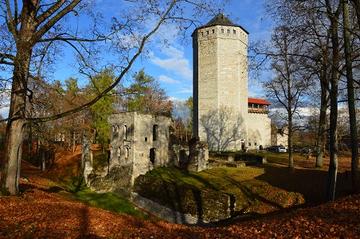
Teutonic Order Castle, Paide, Estonia - © Ivo Kruusamägi
This might make time on the reyse sound like the perfect student gap year for medieval nobles. And a campaign or two with the Teutonic Knights was certainly seen as a useful military apprenticeship, quite apart from the spiritual prestige that it conferred. But in fact, families would often travel together. Young noblemen were also likely to go on the reyse at a much earlier date than we might imagine. William Beauchamp and his brother Thomas went on crusade in Prussia in 1365, when he was just eleven years old. In contrast to other medieval theatres of war, the reyse was relatively safe: someone as small as William would have been protected by a heavily-armed retinue out in the field, and left behind in the Order’s castles when necessary.
Yet as Timothy Guard points out in his recent study, this wasn’t even William’s first crusade. The year before, aged just ten, he had been present at the battle of Nájera. When we are thinking about European court cultures, this aspect of courtly life can be easily forgotten. Edward III of England took part in his first battle at the age of fourteen. For all the courtly fun and games of knights competing in tournaments dressed as Tartars, or banqueting at the Ehrentisch, these men had been fighting since they were children.
In the second of her three blog posts on court cultures and the crusades, Laura Slater looks at how going on crusade could be a massive boost to one's chivalric reputation
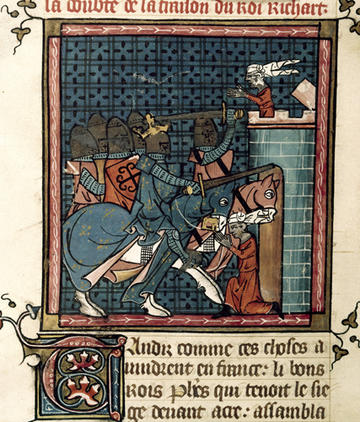
'Capture of Acre' Grandes Chroniques de France (BL Royal 16 G VI, f. 352v) - British Library
Princes as well as courtiers dreamed of going on crusade. In late medieval Europe, rulers were supposed to act as rex crucesignatus (‘the crusading king’): the perfect Christian monarch, always working towards the recovery of Jerusalem, and always ready and willing to lead their men into battle against the 'infidel'. In practice, however, most kings had responsibilities that kept them at home throughout their lives. Few rulers who took crusading vows were ever able to fulfil them.
So as a way of living up to the spiritual and secular ideal of the crusade, rulers were likely to offer knights going on crusade their protection and help: licences to travel abroad, letters of introduction and most importantly, extra money to meet the astronomical cost of equipping a miniature army and then shipping it thousands of miles across land and sea.
If you came home alive from your crusade, with lots of exciting stories to tell about exotic people and places, or death-defying combats with the enemy, the court was also one of the places where returned crusaders might reap more tangible, earthly rewards from all that hardship and heroism. Crusading missions were international ones. Knights from all across Europe joined the 1366 crusade of Amadeus VI of Savoy. Travelling and fighting in such a multinational group would spread word of your valour and glory throughout many lands. This kind of chivalric reputation was a huge career boost, perhaps helping you become an intimate of the king’s chamber or make a great marriage to a wealthy heiress once you arrived back home.
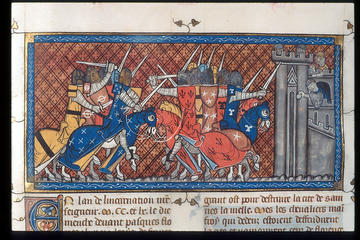
'An Attack of the Tartars' Grandes Chroniques de France (BL Royal 16 G VI, f. 427v) - British Library
At the English court, historical artefacts owned by Edward III of England included a supposed ‘helmet of Saladin’ and the dagger used in Acre to try and assassinate his crusading grandfather Edward I in 1274. Edward III’s courtly spectacles also played on crusading themes. In 1331, a tournament at Cheapside in London saw a parade of knights dressed as Tartars (a word used loosely to refer to nomadic Mongol and Turkic peoples from central Asia). Echoing a scene from a famous romance, The King of Tars, the ‘Tartars’ led a procession of noblewomen on silver chains into the jousting arena. The knights fighting in the tournament could play at being the crusading Christian champions of these ‘captives’, winning freedom for them through their victories in jousts and duels.
But late medieval crusading wasn’t just a matter of courtly fun and games….
In a new series of blog posts, Laura Slater examines the relationship between court cultures and the crusades, crusading as a late medieval ideal, and the penitential obligation and social cachet attached to becoming a holy warrior...
When we imagine knights going off on crusade to the Holy Land, we tend to locate this activity in the twelfth century. From the sixteenth century onwards, the legends of Robin Hood have been set in England during the absence of Richard I (‘Richard the Lionheart’) on the Third Crusade in the 1190s, with the kingdom suffering under the rule of his wicked and cowardly brother John.
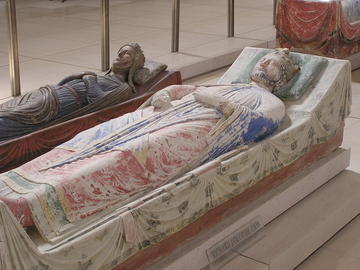
Richard I's tomb at Fontrevault
After the 1291 fall of the last crusader kingdom of Acre, it certainly became more difficult to go and fight for Jerusalem. But crusading remained a very powerful late medieval ideal. Fighting in God’s service was seen as spiritually purifying- a way of gaining forgiveness from God from all your sins. Holy warfare was seen by some as a religious duty and penitential obligation, a way of quieting and healing the soul through physical exertion of the restless body.
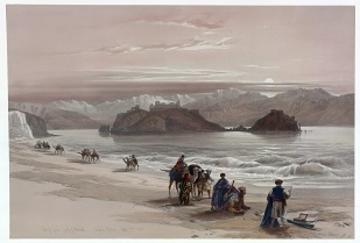
David Roberts, 'Isle of Graia' (1839)
There was also a great social cachet attached to becoming a holy warrior. Going on crusade was seen as the ultimate mark of chivalric honour. It was incredibly expensive to travel to faraway places ready to fight in this way. With the exception of a few, lucky early noblemen in the early years of the crusader states, such as the Ibelin counts of Jaffa and Ascalon, there were no great fortunes or estates to be won in medieval Syria and Palestine. Crusaders slogged at an endless grind of defensive warfare, in besieged castles or disease-ridden military camps. To be willing to risk your life and waste your material resources in this way was thought to demonstrate your impeccable noble lineage, the generosity of your Christian spirit and your great knightly virtue.

Edmund Blair Leighton, 'God Speed' (1900)
Such a combination of spiritual heroics, and the possibility of secular fame and wealth, made the late medieval European court a hub of crusading enthusiasm and recruitment. It was at court where idealistic knights hoping to prove themselves in battle met and signed up with the ‘professionals’ charged with organising crusading missions: papal envoys from Avignon, diplomatic embassies from Byzantium or Spain, or crusading orders such as the Knights Hospitallers of St John. The increasing threat of the Ottoman Turks to Europe saw the creation of naval leagues financed by the papacy, the Hospitallers, and the great maritime and trading powers of Venice and Cyprus. Throughout the fourteenth century and later, European knights continued to travel to Palestine and northern Syria, fought in modern-day Turkey against the Ottomans, took part in the Reconquista led by the Spanish monarchy, or crusaded on the eastern edges of Europe with the Teutonic Knights of Prussia.
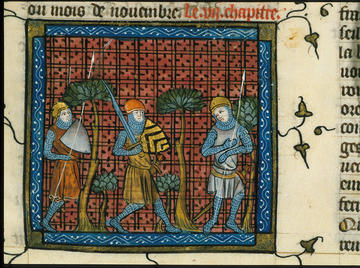
Crusaders from Grandes Chroniques de France (BL Royal 16 G VI, f. 316v) - British Library
At court, knights might hear friars preaching sermons encouraging them to take the cross. They would also come across luxury artefacts depicting ancestral crusading exploits, or relics and souvenirs from the Holy Land. In 1251, Henry III of England commanded that his personal chamber at the palace of Clarendon be painted with the ‘story of Antioch and the duel of King Richard’, either depicting events from the Third Crusade, or the epic romance history of the First Crusade, the Chanson d’Antioche. The Grandes Chroniques de France, a royalist official history of the kings of France coped and circulated at the French court, includes many pictures of crusading heroics by the French kings.
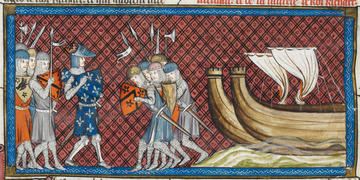
Philip Augustus arriving in Palestine from Grandes Chroniques de France (BL Royal 16 G VI, f. 350v) - British Library
In March, project team member Dr Laura Slater visited the Dr Williams’s Library in London. Her project looks at the cultural patronage of Queen Philippa of Hainault, wife of Edward III of England, focussing particularly on the manuscripts made for her personal religious devotions. One of these manuscripts, a psalter possibly made for Philippa on her arrival in England in 1327, is today part of the collections held by this fascinating library.
Laura’s first priority was to go through the manuscript folio by folio. Like many medieval manuscripts, MS Ancient 6 had been catalogued some decades ago, but not researched, displayed or photographed in any detail since. It is one thing to know from a catalogue that on f.20r there is a depiction of King David, but much more can be learned from seeing this image on the page. How has King David been portrayed? What kind of dress, gestures or expression does he have? The next thing is to think about what these images might have communicated to the medieval viewer, and what kind of deeper meanings or Christian symbolism they may have had.

Man's Shoe and Baby Boot (1300-1500) from http://www.stockholmskallan.se/Soksida/Post/?nid=30523 (taken 2016-09-16). On display at the Museum of Medieval Stockholm
On f.20r of MS Ancient 6, for example, David is dressed in elaborate, multi-coloured and decorated robes. His shoes are formed by a complicated pattern of crossed black lines. This is exactly the kind of fashionable shoe mocked in The Canterbury Tales by Chaucer, when he describes a vain young clerk ‘With Poule’s wyndow corven on his shoos’ (l. 210 of The Miller’s Tale). Chaucer was referring here to the complicated, criss-crossing patterns of tracery found in church windows such as St Paul’s Cathedral in London. By dressing a Biblical icon of virtuous kingship in the latest courtly fashions, Philippa’s psalter gives a divine sanction to magnificent courtly display. This subtle visual lesson may have found a willing pupil in Philippa, for we know that in her later life, she spent lavishly on clothes and jewels.
Minute individual details like the state of David’s shoes are never going to be noted down by a cataloguer, so it is essential for the researcher to spend time patiently working through the manuscript, noting down any features that might be of further interest or require more research. A particularly valuable detail to look out for is any marks of ownership and use. Many of the images in MS Ancient 6 are damaged and partly scratched away. Some small human heads in the initials have even been scored out with a cross mark. This tells us that MS Ancient 6 was probably in England during the Reformation, when ‘idolatrous’ images were deliberately destroyed as part of a new Protestant focus on the Word of God alone. Yet the psalter can still be easily read. Such careful iconoclasm suggests that Philippa’s psalter was still being read and used as a book of prayer in the sixteenth century. Its new audience may have been concerned to not let themselves be distracted by all its lovely images.
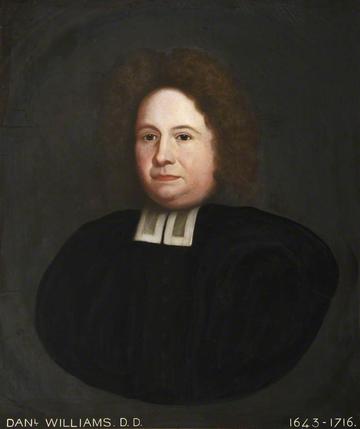
The Dr Williams' library was founded by Dr Daniel Williams (c. 1643-1716), a Presbyterian minister. Born at Wrexham in north Wales, he worked for some years in Dublin before moving to London and becoming a leading figure in the world of Protestant dissent: ‘his large Acquaintance and diffusive Influence, gave him Advantages for Usefulness beyond many of his Brethren’. In 1678, he even took part in an exorcism recorded by Richard Baxter in his 1691 book, The Certainty of the Worlds of Spirits.

Robert Harley, 1st Earl of Oxford by Sir Godfrey Kneller
The term ‘dissenter’ applies to Protestants who ‘dissented’ from the official articles of faith of the Church of England. After the restoration of the British monarchy in 1660, an Act of Uniformity was passed in 1662, setting out the rites and ceremonies of the Church of England in detail. All clerics and all holders of public office (such as MPs or soldiers) were required to take the Oath of Uniformity, swearing to uphold this official, state version of the liturgy and sacraments. Nonconformists- for example, a Quaker or a Presbyterian- refused to do this. As all students at Oxford or Cambridge were required to take the Oath of Uniformity, the Act also excluded such dissenters from practising the law or training as doctors. Other civil and commercial careers, while not formally impossible to pursue, were in practice often equally difficult to embark on.
Williams took an active part in the disputes between Presbyterians and Congregationalists in the 1690s and tried to use his growing prominence in public life during the reign of Queen Anne to support dissenters in the American colonies as well as in England, Ireland and Scotland. From at least 1701, he had an active correspondence with Robert Harley, the first earl of Oxford. A powerful politician, the earl was also a great collector of manuscripts, leaving what is now the Harleian collection in the British Library to the nation at his death in 1724.
The Dr Williams’s Library started more modestly. Williams bequeathed 7,600 of his books to be made available for all nonconformist ministers, tutors and students in the City of London, establishing one of the first public libraries in the United Kingdom in the process. He set up a trust for religious and educational purposes in his will, but it was the commitment and fundraising efforts of its first trustees that enabled the library to open in 1729 in Red Cross Street, Cripplegate. In 1865, the coming of the railways forced its removal to Bloomsbury, traditional heartland of the London intelligentsia.
After a time at 8 Queen Square, the library moved to a purpose-built new location in Grafton Street East. In 1890, the library moved to its present home at 14-15 Gordon Square. This grand building was designed as the first hall of residence of University College London and later shared between UCL and what was then called the Manchester New College (now Harris Manchester College in Oxford). Both institutions were founded by dissenters, and the grandeur of the Dr Williams’s Library building is quite deliberate. Nobody was going to be allowed to dismiss nonconformist educational centres as shabby poor relations of Oxbridge. Architectural glories? Grand libraries and intimidating wealth? Available here to anyone, no matter what they believe in. These buildings are proud statements of rebellion and dissent.
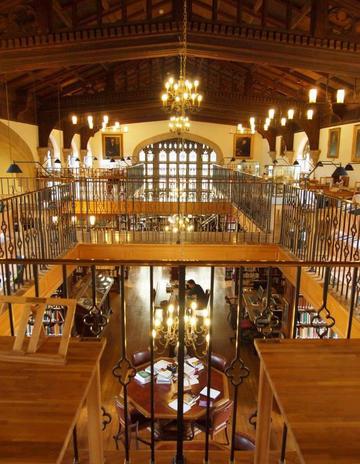
© David Hawgood
Have you ever visited the Dr Williams’s Library?
In the next instalment of our 'Meet the Researchers' series, David, our resident Literature scholar, talks about songs, Salzburg, and Oxbridge rivalry...
You arrived for this post in September. How are you settling in?
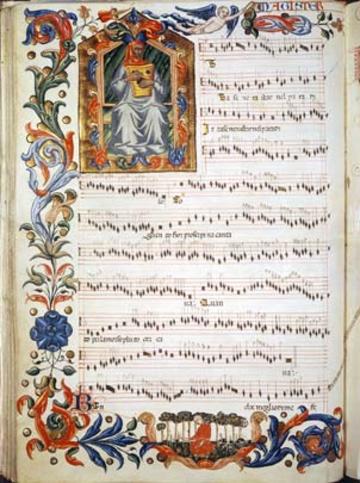
I’m enjoying being back in the UK, having spent the previous two years working in France, and have especially liked getting to know Oxford better. The
University is a wonderful place to be a medievalist, both for the people, whether they are Oxonians or visitors, and for the resources. The project team is a very stimulating and supportive group, and I’m looking forward to a fruitful couple of years.
Is there any one type of literature you feel particularly drawn to?
I wouldn’t say that I am drawn by any particular type. What I find most stimulating are literary texts that challenge our expectations and ways of categorising things and people. My PhD work was focused on poems or songs that ‘moved’ around Europe, whether that was in the form of one melody being re-texted in different languages (think ‘One Song to the Tune of Another’), or songs whose lyrics resist linguistic labels like ‘French’ or ‘Italian’.
What was a court, and how did music interact with,
say, politics or the visual arts?
In the same way, the court of the Prince-Archbishops of Salzburg sits on the fault-line between secular power (the Archbishops were independent rulers) and the Church. So I am looking forward to thinking more how this mixture of influences and connections affected the cultural life of this milieu.
How would you explain this project to interested members of the general public?
Studying medieval courts is not in itself new. Nor is thinking about the musicians who performed there or the composers who wrote the music. MALMECC is something of an experiment in medieval studies: what happens when you take people without an academic background in musicology (with the exception of the project leader, of course), have them work together closely for four years? Essentially we are aiming to give a more integrated understanding of culture at court in the long fourteenth century. What was a court, and how did music interact with, say, politics or the visual arts?
What’s the most exciting thing about the project for you?
Something I am enthused by is being able to roam across the full scope of medieval studies and look for points of interactions disciplines other than literary studies. For instance, at the moment I am looking at the intersections of representations of the Virgin Mary in sculpture and in the songs of the Monk of Salzburg, something that I might not have thought about doing otherwise. Similarly, being able to work in depth with a single composer’s works, particularly one for which there is so much surviving music, is a refreshing change from my previous work on multiple troubadours. I’m particularly looking forward to getting to grips with the sound of the Monk’s songs and the court at Salzburg.
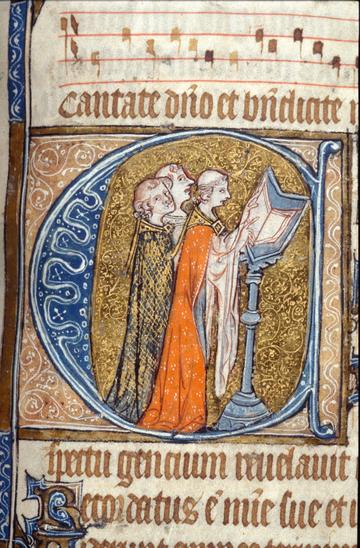
What are you up to when you are not researching?
Cake, both making and eating. Reading, of course—sometimes even things as recent as the nineteenth century! I also play the piano, in a somewhat agricultural style.

Finally, because I know where you took your undergraduate degree… Oxford or Cambridge?
What a question! I am enjoying life in Oxford tremendously, but to paraphrase Miss Jean Brodie, give me a medievalist at an impressionable age, and he is mine for life…
In the final post of the current series on the patronage of Charles IV, Laura Slater looks at the work of Master Theodoric, court painter to Charles IV.
Another famous panel painting found in the Holy Cross Chapel at Karlštejn Castle is an image of St Luke the Evangelist, found on its north wall.

St Luke is shown with his symbol or attribute to help us recognise him: the winged bull at his shoulder.
Calves and bulls were the beasts sacrificed on the altar in the Jewish Temple. The motif was intended to remind a medieval viewer of Christ’s own sacrifice to God, in his suffering and death on the Cross. In St Luke’s gospel, in his account of the Last Supper, Jesus says ‘This is the chalice, the new testament in my blood, which shall be shed for you’ (Luke 22:20). St Luke is also shown holding an open book. This refers to his gospel, found in the New Testament of the Bible. So the image of book and bull link together: as Christ is the Word made Flesh (John 1:14), his flesh-and-blood suffering and sacrifice on the cross, in echo of what happened to the bull in the Old Temple of Judaism, creates a New Temple of Christianity, founded on the words of the Gospels. Luke wears a sky-blue robe, symbolising the eternal heavenly realm he now moves in.
Yet St Luke looks straight out at the viewer, meeting our eyes with a clear, direct gaze. He is the only figure in all the portrait panels to do so. Art historian Jiří Fajt suggests that the panel may be a self-portrait of Theodoric himself. St Luke was the patron saint of painters, thanks to the legend that he painted a portrait of the Virgin and Child. In the Middle Ages, many famous icons were thought to be ‘autograph works’ by St Luke, including the now-lost Panagia Hodegetria icon in Constantinople. It was believed to have been brought back from the Holy Land in the fifth century by Eudocia, the wife of the Byzantine Emperor Theodosius II.
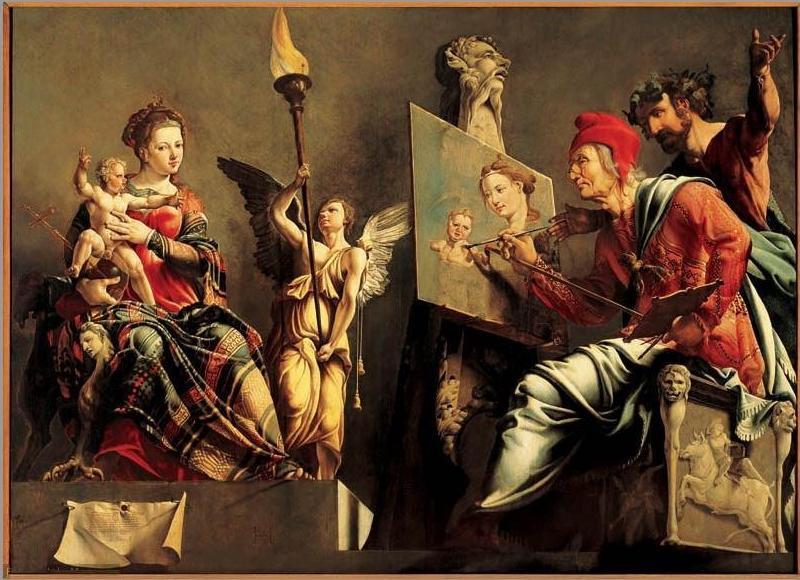
'St Luke Painting the Virgin and Child' - Maerten Van Heemskerck
Many guilds and early academies of painting in Europe were dedicated to St Luke for this reason. Theodoric himself was the head of the Brotherhood of St Luke in Prague. As his team of artists had worked flat-out over four years to paint and decorate the Holy Cross Chapel at Karlštejn, including finishing all 130 saintly portraits, Theodoric may have thought that he deserved to be permanently honoured in the Holy Cross Chapel in this way. And since Charles IV later rewarded Theodoric for what he described as ‘profound and masterly’ work at his court, the emperor may not have minded such a clever visual conceit.
Thanks to Laura for the insight into the art and design of the Holy Cross Chapel. Get in touch via. the contact form or Twitter, and let the team know what you would like to hear about next!
In the next of her blog posts looking at the life and patronage of Charles IV, Laura explores the opulent Chapel of the Holy Cross at Karlštejn Castle...
A day’s horse ride away from Prague, Karlštejn Castle became one of Charles’ most important courtly residences. He stored his imperial treasure and the imperial regalia there. It was also a place where this deeply pious ruler could honour his absent family, and the saints he believed were looking out for him in heaven, watching over him and helping him with his daily life.
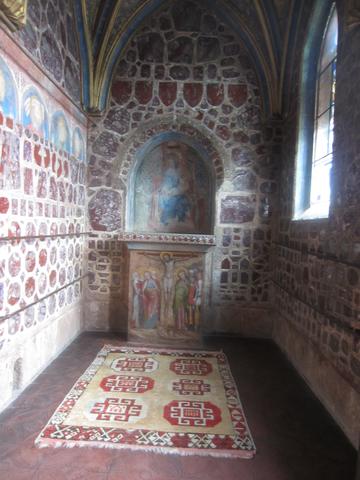
© Jürgen Regel, Marian
When Charles returned to Prague in 1333, aged seventeen, his mother had died and his father was far away, ruling other countries. In an autobiography begun in 1346, Charles writes that ‘when we arrived in Bohemia we found neither father nor mother nor brothers nor sisters nor anyone else we knew. In addition, we had completely forgotten the Czech language…’
Perhaps feeling lonely and isolated, Charles turned to saintly protectors with enthusiasm, particularly saints who were also family, such as his holy ancestor, St Wenceslas. He became a great collector of relics- the earthly remains of saints, which could be anything from a fragmentary body part, such as limbs or even locks of hair, to an object owned or perhaps even just touched by the saint while they were alive. These objects were thought to have become charged with the holy essence of the saint and could now work miracles, particularly healing and protective ones.
‘when we arrived in Bohemia we found neither father nor mother nor brothers nor sisters nor anyone else we knew. In addition, we had completely forgotten the Czech language…’
At Karlštejn, Charles had an oratory dedicated to St Wenceslas in his private apartments. And he had pictures of his ancestors painted all over the castle. Perhaps they reminded him of who he was, and where he came from before he started on his travels between different European courts. Karlštejn Castle hall was painted with a huge family genealogy, starting with Noah and the Trojans and finally reaching Charles’s more recent Luxembourg and Brabantine ancestors. Portraits of Charles and his own family were also placed in other castle chapels.

Ludvík Kohl - Chapel of the Holy Cross (1820)
There were at least five chapels at Karlštejn, but the largest and most splendid was the chapel dedicated to Holy Cross. The Holy Cross Chapel is accessed by a staircase, and Charles decorated it with scenes from the lives of two of his holy ancestors, St Wenceslas and St Ludmila.
Decorated between 1360 and 1364, the walls of the chapel are covered with slabs of precious and semi-precious stones, including gold, jasper and amethyst, set in the form of large gold crosses.
The brilliance of the decoration evokes the heavenly Jerusalem described in Revelation 21, 18-19: ‘the city itself [was of] pure gold like unto clear glass. And the foundations of the wall of the city were adorned with all manner of precious stones. The first foundation was jasper: the second,sapphire…’ Charles clearly liked to imagine Prague as a new Jerusalem. He made sure that a smaller chapel in Karlštejn, known today as St Catherine’s Chapel, also echoed the gem-studded walls of the heavenly city. In the Holy Cross Chapel however, there is a very unusual feature. Amongst the glitter of gold and precious stones, three tiers of portraits are lined up on the chapel walls. The Holy Cross Chapel looks like a huge picture gallery, hundreds of years before they became popular.
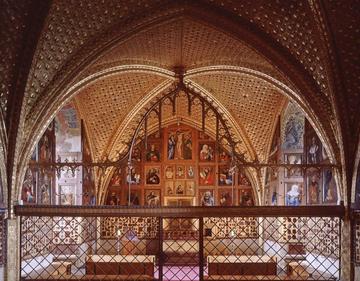
The Holy Cross Chapel - czechtourism.com
Charles IV - Master Theodoric
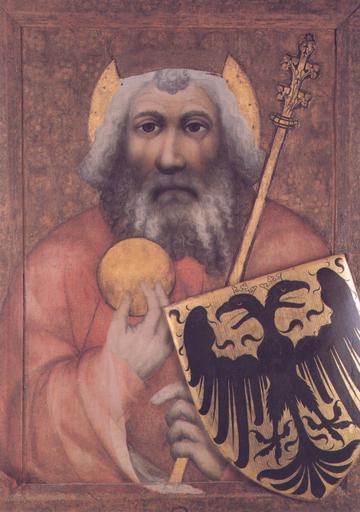
A medieval visitor is more likely to have seen a resemblance to the iconostasis, the wall of paintings and icons found in Orthodox Christian churches between the nave and the sanctuary. Painted by Charles’ court painter, Master Theodoric and his workshop, there are 130 portraits of different Christian saints, placed like witnesses to the Crucifixion of Christ that was painted on a panel behind the altar. On the north wall are portraits of the authors of the gospels, the apostles and angels. On the west wall are holy bishops, abbots and rulers. Most of the panels have a textured or engraved gold ground, matching the textured and gem-encrusted golden walls of the chapel and its vaulted roof. In each frame is a small compartment, designed to hold a relic of the saint depicted in the panel painting.
Even here, Charles made sure to honour his ancestors. One of the most famous panels from the Holy Cross Chapel is this painting of his ancestor Charlemagne, believed by the fourteenth century to be a holy saint as well as a great ruler.
Charlemagne is shown holding the golden orb and sceptre found in the imperial treasury. The shield emblazoned with the imperial eagle, like the now-missing crown on Charlemagne’s head, were both carved separately and added to the panel at an angle. By overlapping with the frame of the panel, and standing out from the circular metallic appliqués decorating the gold background, the crown and shield stop Charlemagne from blending in with the rest of the paintings on the walls. Your eye is unable to drift from picture to picture.
Charlemagne is a solemn, bearded figure- and he does seem to look a lot like Charles IV…
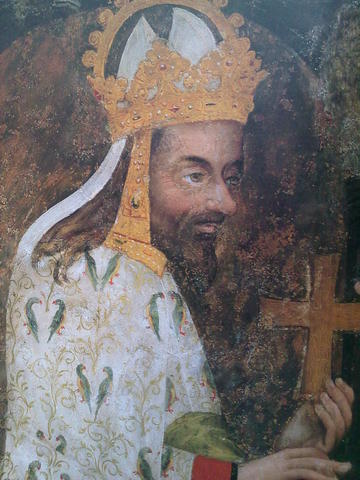
Charles IV - Master Theodoric
Discover more about Master Theodoric, the court painter of Prague, in our next post...
Here Christophe, our newest team member, gives an insight into the project and his interests...
So, you’ve come from Liège, how are you finding Oxford?
They are two completely different cities. Liège is quite a bit bigger than Oxford but destruction caused by war and modern urbanization means that most pre-eighteenth century buildings, except churches, have disappeared.
As a historian, I love being brought back into the past when walking in Oxford. It’s great being able to find everything I want, from seminars to cinemas, from research libraries to pubs, in less than a 20 minute walk. I am sure I am just mentioning the most obvious things though. Hopefully, the time I will spend here will make me discover much more than that!

I was the type of kid who always wanted
to take his family to visit every possible
kind of museum during holidays!
Have you always been drawn to the medieval period?
As far as I remember, I always have been passionate about culture and history, and mainly about the period before the eighteenth century. So I was the type of kid who always wanted to take his family to visit every possible kind of museum during holidays! At that time, the Middle Ages seemed to me as interesting as, let's say, Alexandre Dumas' musketeers or the prehistoric period. It was at university that I devoted myself to the Middle Ages, thanks to some teachers I had back then, and probably also to the opportunity of studying castles and knights.
You have previously specialised in military history, are there any differences in this field?
There are lots of differences, of course, between military and court history, mainly regarding the questions we are asking sources—not “How many knights were there in this army?” or “What materials did they use to storm this castle?” but “What was the role of literary culture in structuring courtly life?”, “What was the place played by women, if any?” and “How was the court turned into a stage by courtiers and princes?”. This project also crosses multiple disciplines. However, many medieval captains were also courtiers who enjoyed staying in princely households, and talking about ladies, romances, music, or jousts. So I see this new research as a way to expand my knowledge of late medieval élites in a new direction.
What’s the most exciting thing about this project for you?
To discover new disciplines “from the inside” and to be part of an ambitious project that aims to redefine what we may think we already know, namely the cultural identity of late medieval courts.
How would you explain this project to interested members of the general public?
Even if we have studied courts for centuries, the focus has remained too often on their national and institutional aspects. The main questions have been “Who was present?” “How were the courts organized?” and “How did the courtly system help kings to centralize their State?”
In contrast to this, the MALMECC team wishes to question the cultural aspect of courts, emphasizing the role played by musical performances and international cultural exchanges.
The ultimate aim is to design a new model of late medieval courts; one where national boundaries may well appear less powerful than we used to think.
What are your interests outside of academia?
I enjoy reading (reading, always reading...) novels and comic books, fantasy, science-fiction, histories, humour, and classics, as well as watching movies and television series. I also love walking, trekking, and of course visiting lots of different countries and their museums!
Why are the cultural connections of Charles IV so important for the MALMECC project? Laura Slater begins a series of blog posts looking his life and patronage.
In September 2016, the MALMECC project team travelled to the Charles University in Prague (https://www.cuni.cz/UKEN-1.html), to take part in a workshop held as part of the ‘Sound Memories: The Musical Past in Late-Medieval and Early-Modern Europe’ project (http://www.soundme.eu/)
Founder of the Charles University in 1348 and responsible for making Prague into such a splendid cultural capital, Charles IV of Bohemia (1316-1378) remains a highly respected figure in the modern-day Czech Republic.

Charles would probably enjoy seeing his face on the Czech koruna today. In his own lifetime, he made sure that his portrait could be seen in many public places, and, through his seal, on important documents that might be publicly inspected or displayed for all to see.

Seal of Charles IV from the 'Golden Bull' of 1356
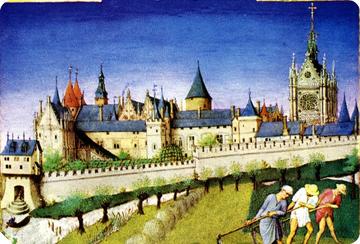
Palais de la Cité, the residence of the Kings of France from the 6th century until the 14th century
Later crowned Holy Roman Emperor, Charles’ court in Prague is a perfect test case for MALMECC’s research into the interactions between different late medieval court cultures and their music, looking at these environments from a pan-European, transnational perspective. Charles IV brought not only art, books, music and song from across Europe to Prague, but even his own name. When he was born, he was baptised Wenceslas (Václav) after his Bohemian ancestors. But at the age of only seven, he was sent away to be educated at the French royal court in Paris.
Ruled over by his uncle, Charles IV of France, Wenceslas took the name of a man who must have become an important father-figure for him. In 1330, Charles was sent off to Italy by his own father, King John. Now fourteen years old, in a medieval context he would have been considered quite old enough to start ruling some of the far-flung domains of his paternal family, the Luxembourg dynasty. In fact, Charles had already been married for some years, to a French princess named Blanche of Valois.
In Italy, Charles came into contact with the art and culture of sophisticated urban centres like Siena. So when he finally returned to Prague in 1333, he was determined to make the city and his court as famous for its beauty, culture and learning as some of the many European cities he had travelled through or lived in. As well as founding the Charles University, Charles rebuilt Prague Cathedral and built himself a new royal residence at Prague Castle.
He also founded new religious houses, such as the Carmelite monastery of Our Lady of the Snows, and in 1348, he founded the New Town, a new residential district outside the city walls.
But how much did he ever feel at home there? After 1355, he started rebuilding an old Luxembourg country residence: Karlštejn Castle, deep inside the royal forests surrounding medieval Prague...
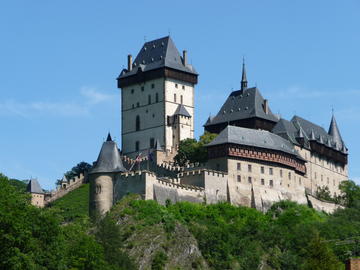
Do you have a research interest in Charles IV or medieval Prague? Let us know!

